Quick filters:
Mechanical loom Stock Photos and Images
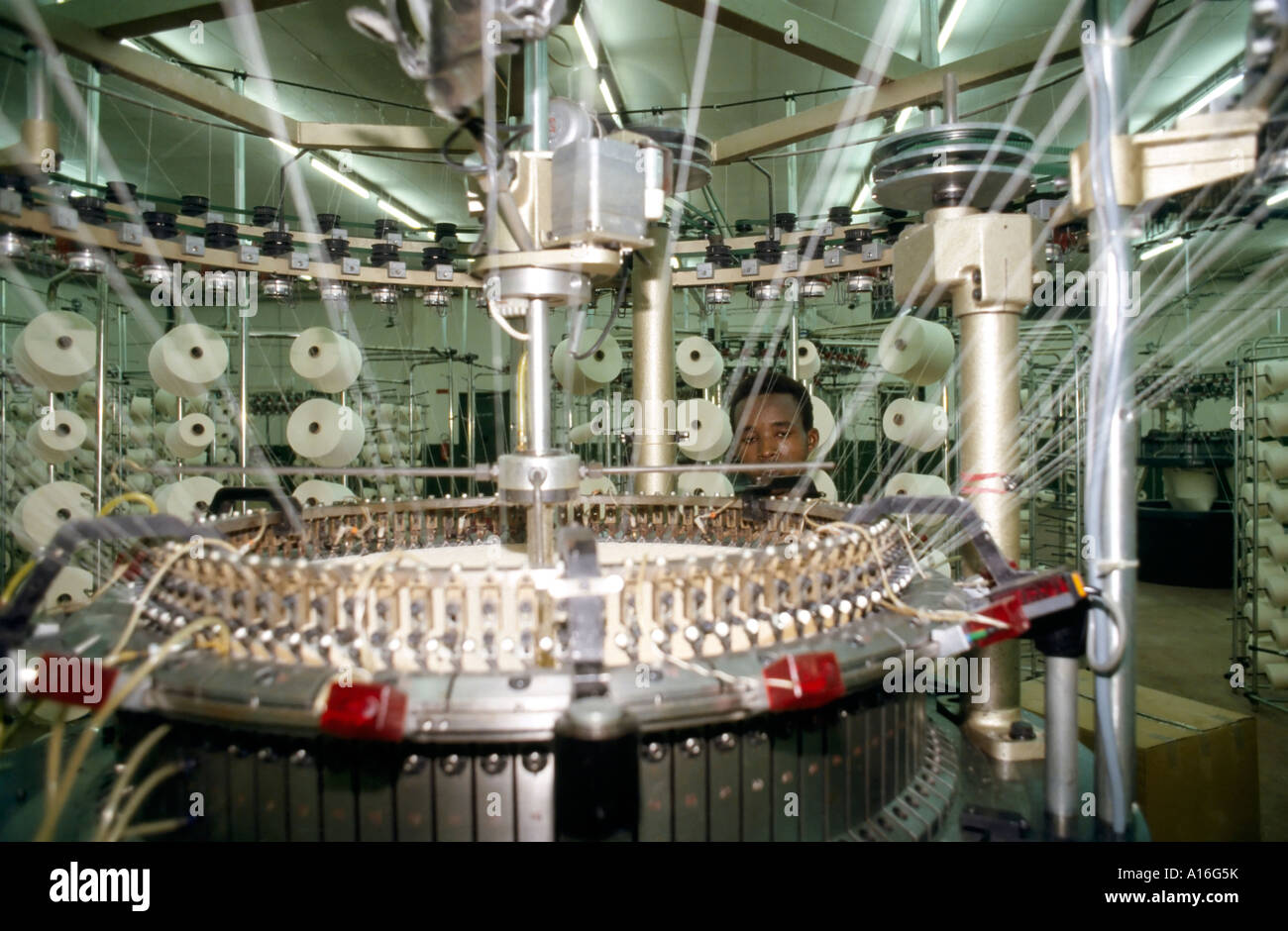 modern mechanical loom Stock Photohttps://www.alamy.com/image-license-details/?v=1https://www.alamy.com/stock-photo-modern-mechanical-loom-10159806.html
modern mechanical loom Stock Photohttps://www.alamy.com/image-license-details/?v=1https://www.alamy.com/stock-photo-modern-mechanical-loom-10159806.htmlRMA16G5K–modern mechanical loom
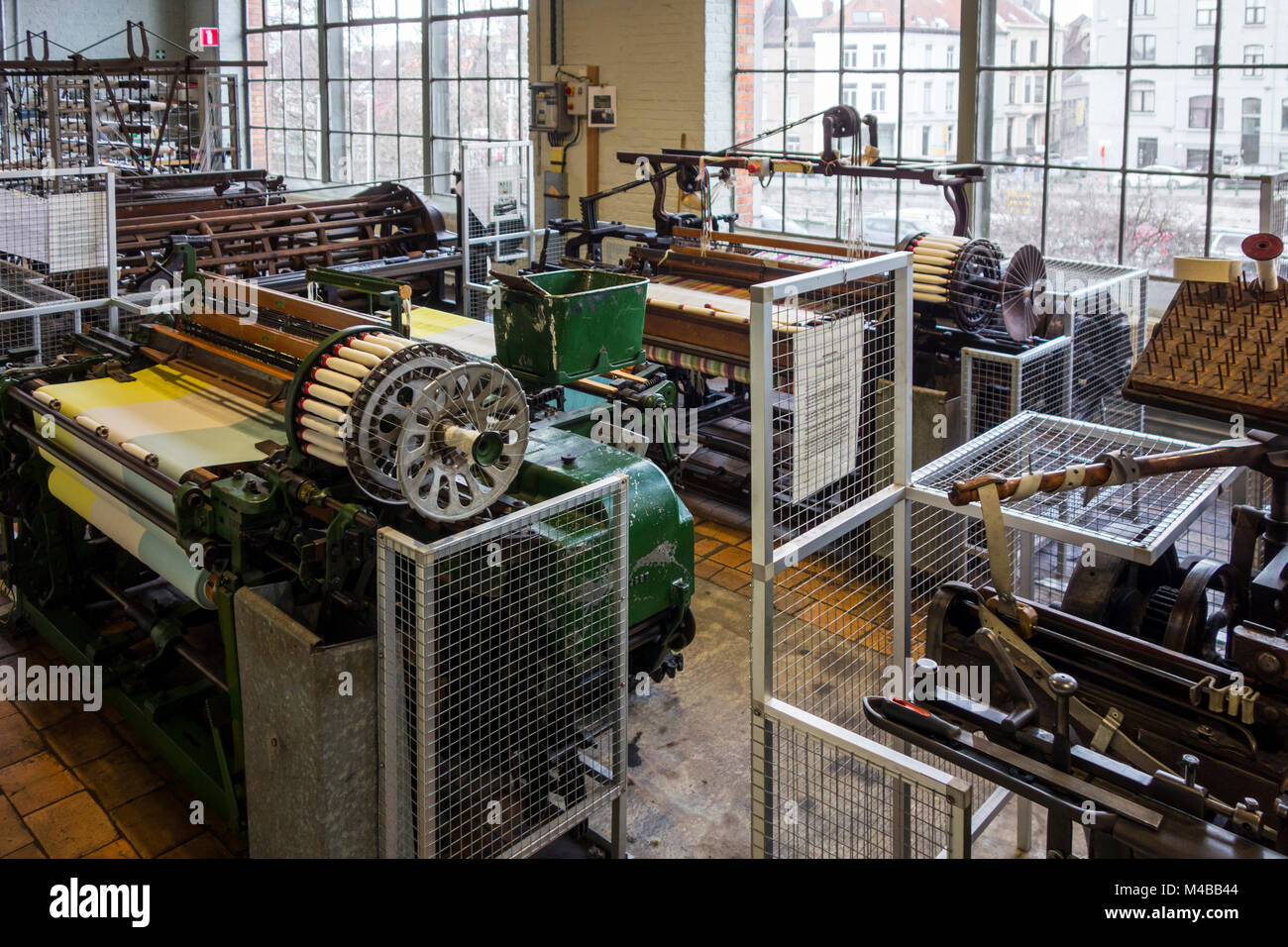 Mechanical flying shuttle loom / shuttle weaving machine in cotton mill / spinning-mill Stock Photohttps://www.alamy.com/image-license-details/?v=1https://www.alamy.com/stock-photo-mechanical-flying-shuttle-loom-shuttle-weaving-machine-in-cotton-mill-174812516.html
Mechanical flying shuttle loom / shuttle weaving machine in cotton mill / spinning-mill Stock Photohttps://www.alamy.com/image-license-details/?v=1https://www.alamy.com/stock-photo-mechanical-flying-shuttle-loom-shuttle-weaving-machine-in-cotton-mill-174812516.htmlRMM4BB44–Mechanical flying shuttle loom / shuttle weaving machine in cotton mill / spinning-mill
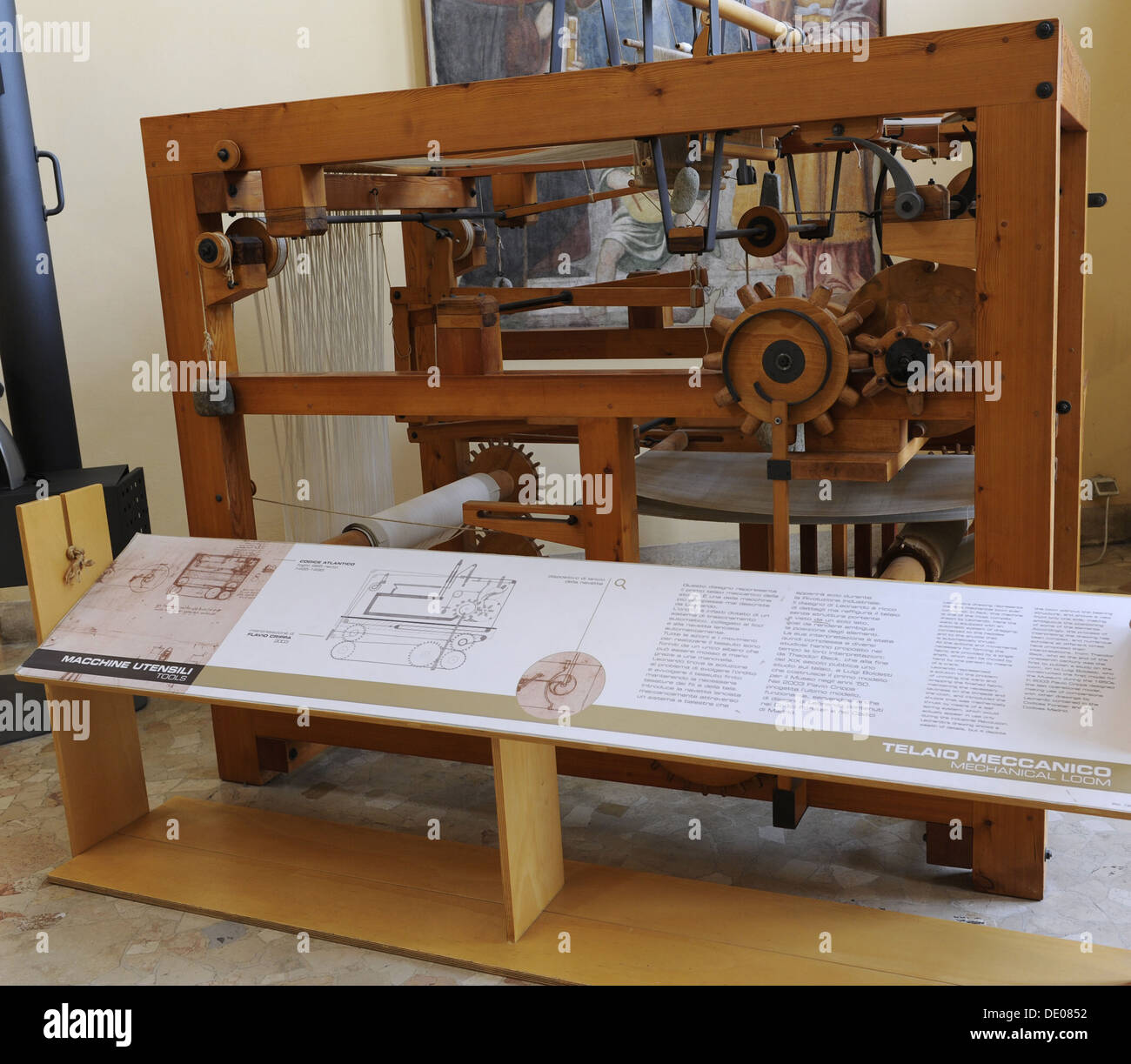 Study of Leonardo da Vinci. Weaving machines. Mechanical loom. 15th century. Model. Stock Photohttps://www.alamy.com/image-license-details/?v=1https://www.alamy.com/study-of-leonardo-da-vinci-weaving-machines-mechanical-loom-15th-century-image60242702.html
Study of Leonardo da Vinci. Weaving machines. Mechanical loom. 15th century. Model. Stock Photohttps://www.alamy.com/image-license-details/?v=1https://www.alamy.com/study-of-leonardo-da-vinci-weaving-machines-mechanical-loom-15th-century-image60242702.htmlRMDE0852–Study of Leonardo da Vinci. Weaving machines. Mechanical loom. 15th century. Model.
 Mechanical cotton spinning and weaving mill in Augsburg, 1840, at the start of the machine age in Bavaria. Stock Photohttps://www.alamy.com/image-license-details/?v=1https://www.alamy.com/stock-photo-mechanical-cotton-spinning-and-weaving-mill-in-augsburg-1840-at-the-29839404.html
Mechanical cotton spinning and weaving mill in Augsburg, 1840, at the start of the machine age in Bavaria. Stock Photohttps://www.alamy.com/image-license-details/?v=1https://www.alamy.com/stock-photo-mechanical-cotton-spinning-and-weaving-mill-in-augsburg-1840-at-the-29839404.htmlRMBMF8D0–Mechanical cotton spinning and weaving mill in Augsburg, 1840, at the start of the machine age in Bavaria.
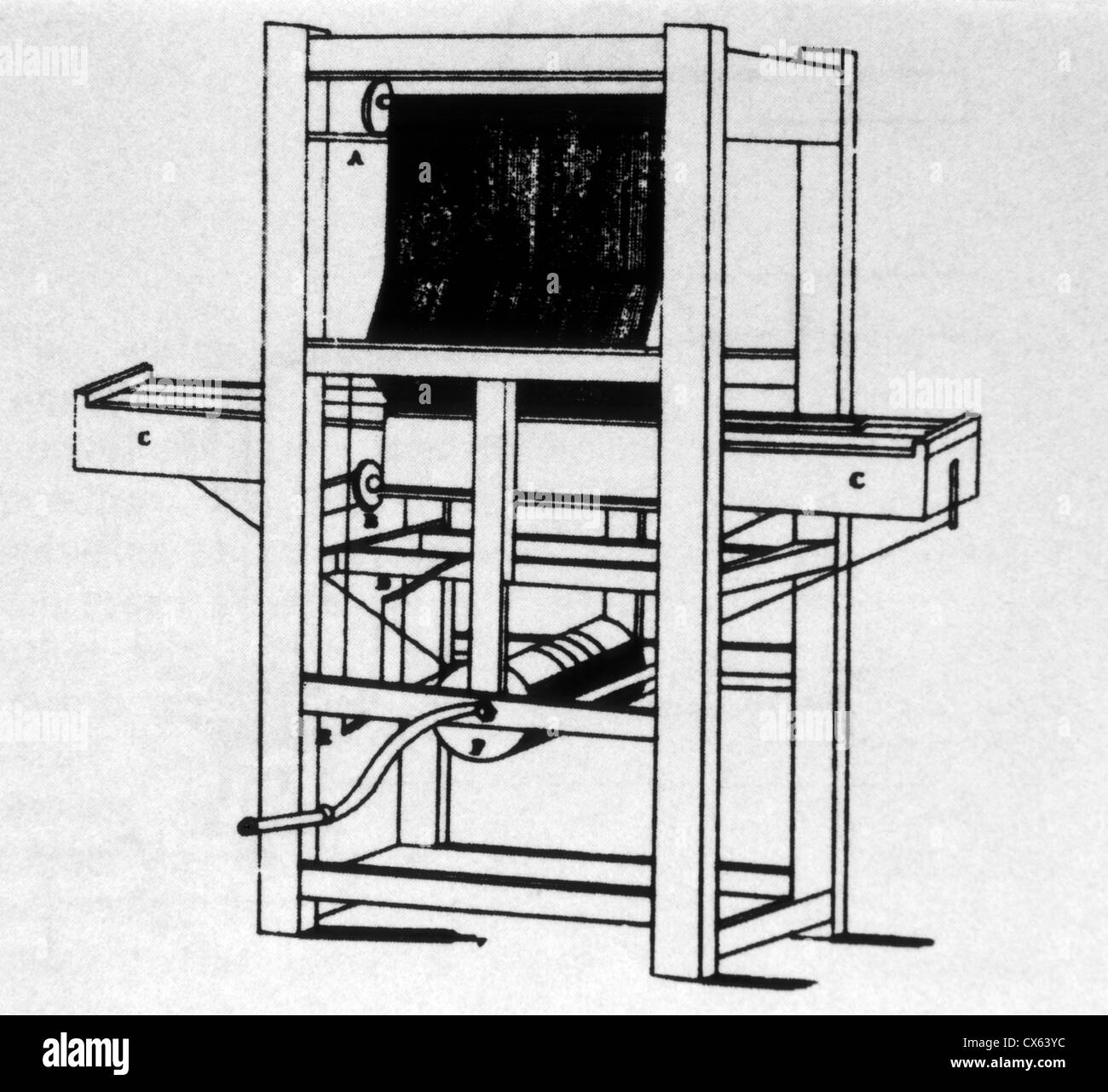 First Mechanical Loom, Constructed by Edmund Cartwright in 1784, Print Stock Photohttps://www.alamy.com/image-license-details/?v=1https://www.alamy.com/stock-photo-first-mechanical-loom-constructed-by-edmund-cartwright-in-1784-print-50536624.html
First Mechanical Loom, Constructed by Edmund Cartwright in 1784, Print Stock Photohttps://www.alamy.com/image-license-details/?v=1https://www.alamy.com/stock-photo-first-mechanical-loom-constructed-by-edmund-cartwright-in-1784-print-50536624.htmlRMCX63YC–First Mechanical Loom, Constructed by Edmund Cartwright in 1784, Print
 19th century Industrial Revolution Era mechanical loom, Technology Museum, Berlin, Germany Stock Photohttps://www.alamy.com/image-license-details/?v=1https://www.alamy.com/stock-photo-19th-century-industrial-revolution-era-mechanical-loom-technology-29853536.html
19th century Industrial Revolution Era mechanical loom, Technology Museum, Berlin, Germany Stock Photohttps://www.alamy.com/image-license-details/?v=1https://www.alamy.com/stock-photo-19th-century-industrial-revolution-era-mechanical-loom-technology-29853536.htmlRMBMFXDM–19th century Industrial Revolution Era mechanical loom, Technology Museum, Berlin, Germany
 Renaissance. Study of Leonardo da Vinci. Weaving machines. Mechanical loom. 15th century. Model. The Science and Technology Museum Leonardo da Vinci. Milan. Italy. Stock Photohttps://www.alamy.com/image-license-details/?v=1https://www.alamy.com/renaissance-study-of-leonardo-da-vinci-weaving-machines-mechanical-loom-15th-century-model-the-science-and-technology-museum-leonardo-da-vinci-milan-italy-image231205106.html
Renaissance. Study of Leonardo da Vinci. Weaving machines. Mechanical loom. 15th century. Model. The Science and Technology Museum Leonardo da Vinci. Milan. Italy. Stock Photohttps://www.alamy.com/image-license-details/?v=1https://www.alamy.com/renaissance-study-of-leonardo-da-vinci-weaving-machines-mechanical-loom-15th-century-model-the-science-and-technology-museum-leonardo-da-vinci-milan-italy-image231205106.htmlRMRC48D6–Renaissance. Study of Leonardo da Vinci. Weaving machines. Mechanical loom. 15th century. Model. The Science and Technology Museum Leonardo da Vinci. Milan. Italy.
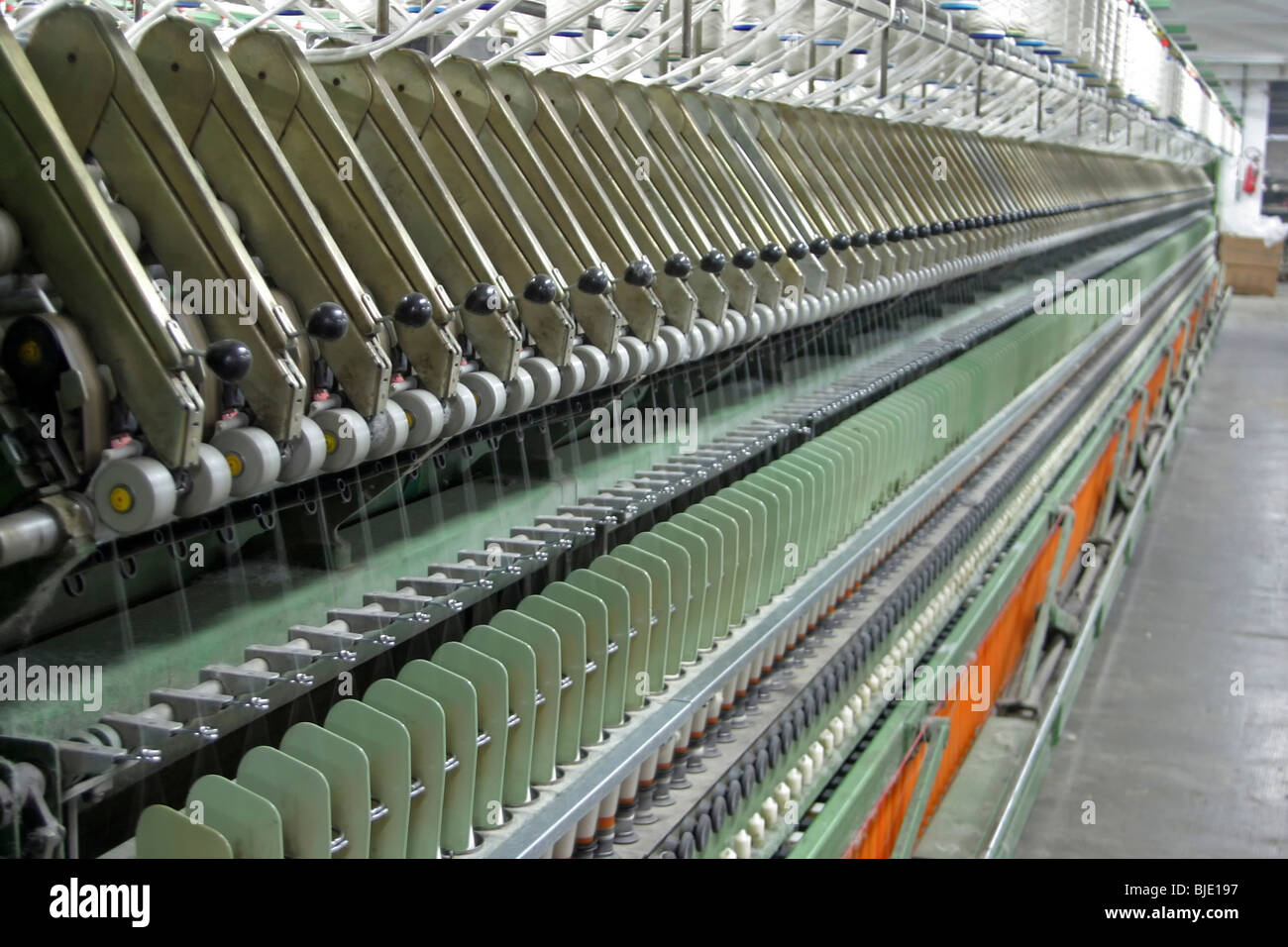 Mechanical loom Stock Photohttps://www.alamy.com/image-license-details/?v=1https://www.alamy.com/stock-photo-mechanical-loom-28582547.html
Mechanical loom Stock Photohttps://www.alamy.com/image-license-details/?v=1https://www.alamy.com/stock-photo-mechanical-loom-28582547.htmlRMBJE197–Mechanical loom
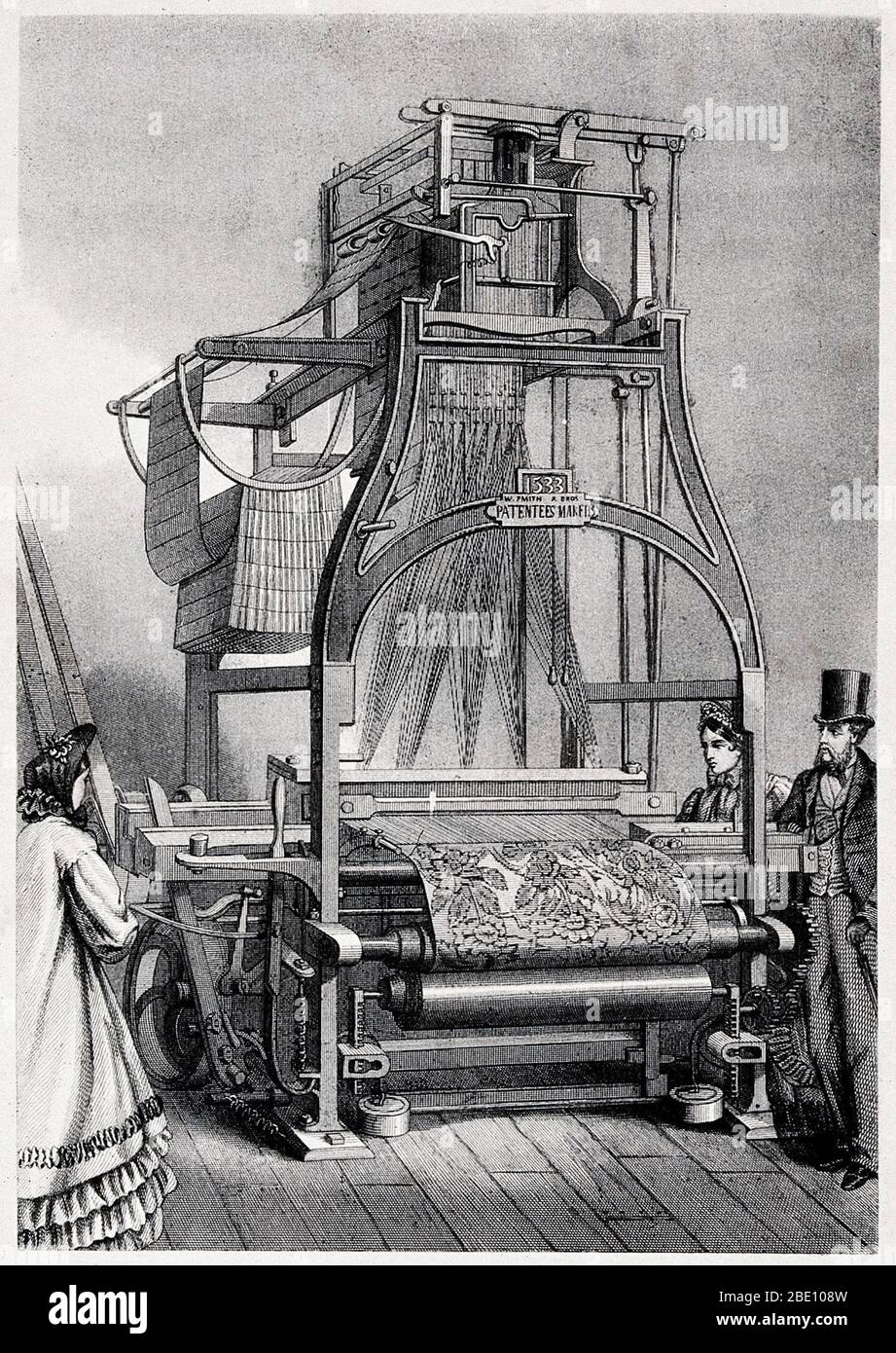 A mechanical Jacquard loom, front and rear elevations. Engraving by Pegard after L. Guiguet. This device for weaving textiles was invented in 1804 by the French weaver and inventor Joseph Marie Jacquard (1752-1834). It had a number of novel design features and was the first to be automatically controlled. It was controlled by a number of perforated cards, the holes corresponding to the weave pattern. When this was introduced into factories, there were riots among workers who feared losing their jobs. Stock Photohttps://www.alamy.com/image-license-details/?v=1https://www.alamy.com/a-mechanical-jacquard-loom-front-and-rear-elevations-engraving-by-pegard-after-l-guiguet-this-device-for-weaving-textiles-was-invented-in-1804-by-the-french-weaver-and-inventor-joseph-marie-jacquard-1752-1834-it-had-a-number-of-novel-design-features-and-was-the-first-to-be-automatically-controlled-it-was-controlled-by-a-number-of-perforated-cards-the-holes-corresponding-to-the-weave-pattern-when-this-was-introduced-into-factories-there-were-riots-among-workers-who-feared-losing-their-jobs-image352834745.html
A mechanical Jacquard loom, front and rear elevations. Engraving by Pegard after L. Guiguet. This device for weaving textiles was invented in 1804 by the French weaver and inventor Joseph Marie Jacquard (1752-1834). It had a number of novel design features and was the first to be automatically controlled. It was controlled by a number of perforated cards, the holes corresponding to the weave pattern. When this was introduced into factories, there were riots among workers who feared losing their jobs. Stock Photohttps://www.alamy.com/image-license-details/?v=1https://www.alamy.com/a-mechanical-jacquard-loom-front-and-rear-elevations-engraving-by-pegard-after-l-guiguet-this-device-for-weaving-textiles-was-invented-in-1804-by-the-french-weaver-and-inventor-joseph-marie-jacquard-1752-1834-it-had-a-number-of-novel-design-features-and-was-the-first-to-be-automatically-controlled-it-was-controlled-by-a-number-of-perforated-cards-the-holes-corresponding-to-the-weave-pattern-when-this-was-introduced-into-factories-there-were-riots-among-workers-who-feared-losing-their-jobs-image352834745.htmlRM2BE108W–A mechanical Jacquard loom, front and rear elevations. Engraving by Pegard after L. Guiguet. This device for weaving textiles was invented in 1804 by the French weaver and inventor Joseph Marie Jacquard (1752-1834). It had a number of novel design features and was the first to be automatically controlled. It was controlled by a number of perforated cards, the holes corresponding to the weave pattern. When this was introduced into factories, there were riots among workers who feared losing their jobs.
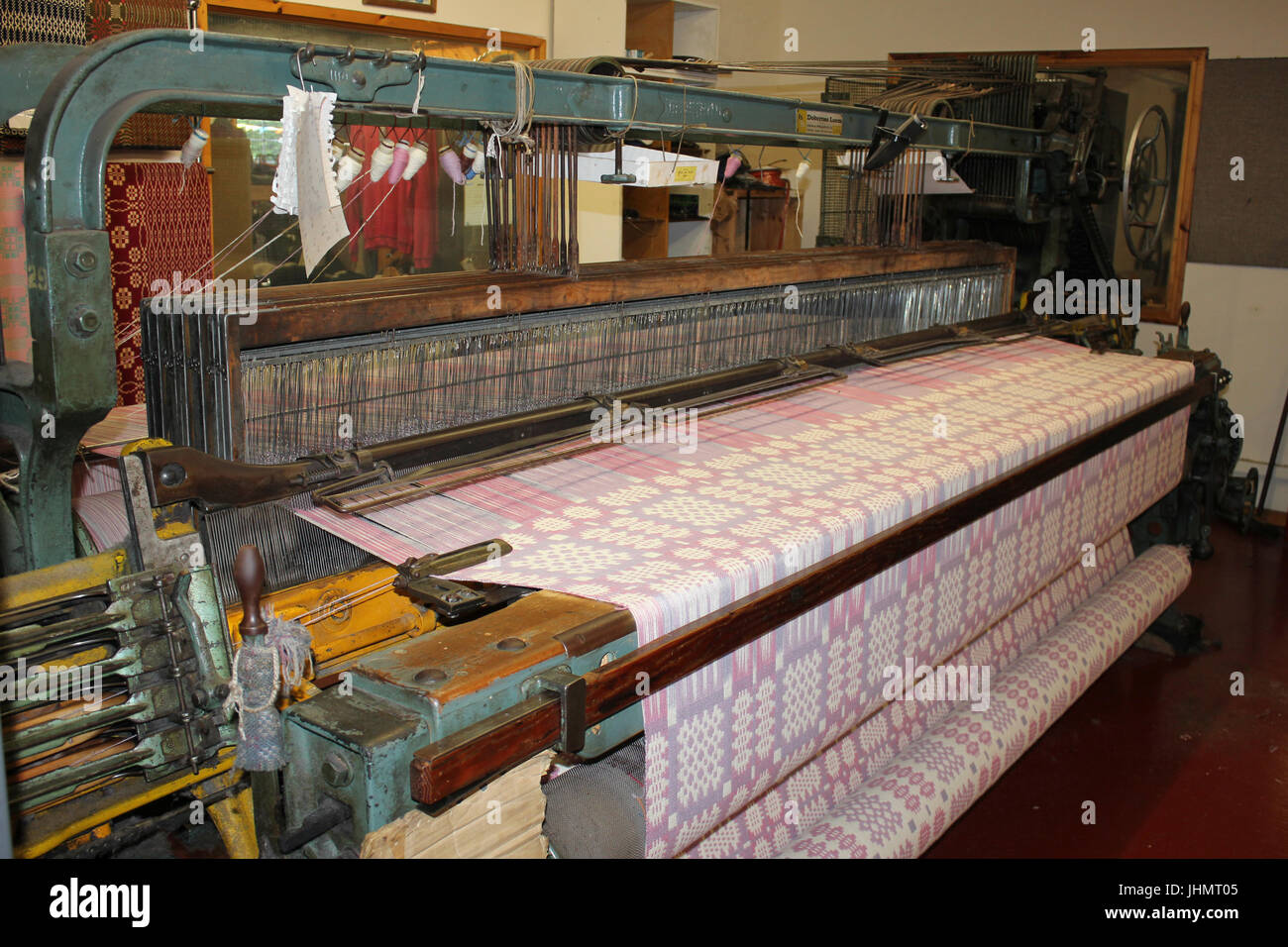 Trefriw Woollen Mill Loom Stock Photohttps://www.alamy.com/image-license-details/?v=1https://www.alamy.com/stock-photo-trefriw-woollen-mill-loom-148589957.html
Trefriw Woollen Mill Loom Stock Photohttps://www.alamy.com/image-license-details/?v=1https://www.alamy.com/stock-photo-trefriw-woollen-mill-loom-148589957.htmlRMJHMT05–Trefriw Woollen Mill Loom
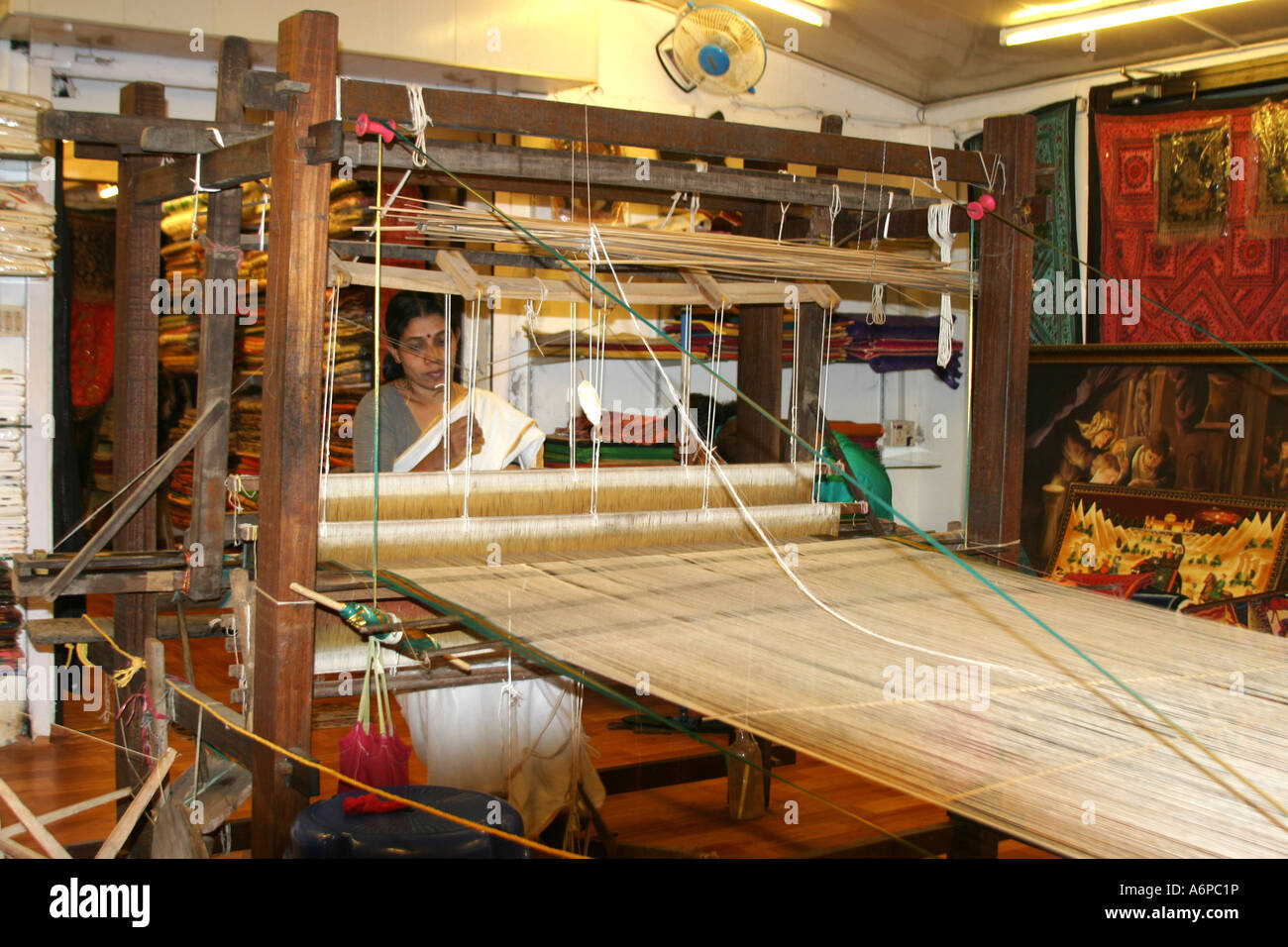 Indian woman using a wooden mechanical loom to weav e in Jew Town ,Cochin,India Stock Photohttps://www.alamy.com/image-license-details/?v=1https://www.alamy.com/stock-photo-indian-woman-using-a-wooden-mechanical-loom-to-weav-e-in-jew-town-11626065.html
Indian woman using a wooden mechanical loom to weav e in Jew Town ,Cochin,India Stock Photohttps://www.alamy.com/image-license-details/?v=1https://www.alamy.com/stock-photo-indian-woman-using-a-wooden-mechanical-loom-to-weav-e-in-jew-town-11626065.htmlRMA6PC1P–Indian woman using a wooden mechanical loom to weav e in Jew Town ,Cochin,India
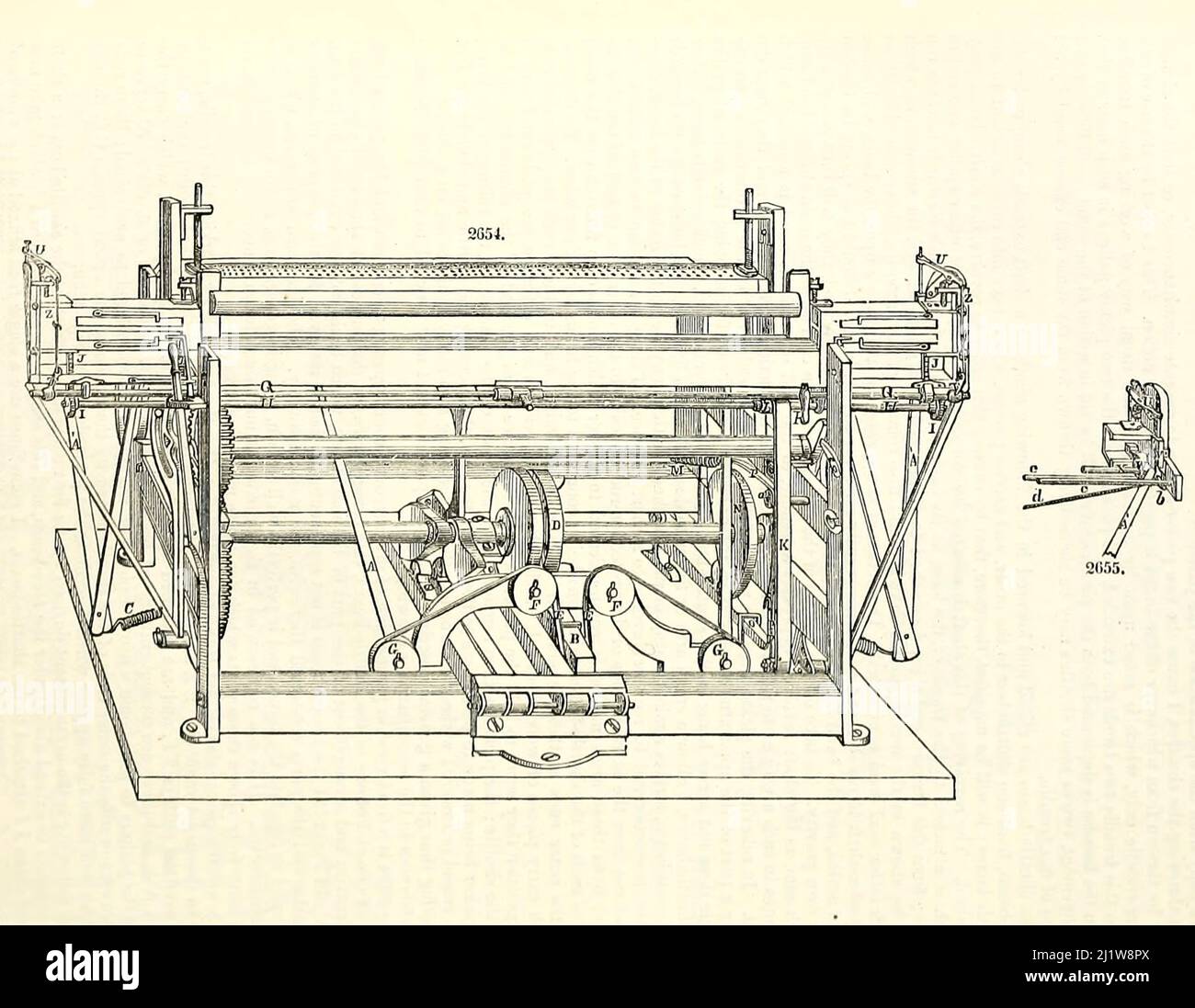 Mechanical Loom from Appleton's dictionary of machines, mechanics, engine-work, and engineering : illustrated with four thousand engravings on wood ; in two volumes by D. Appleton and Company Published New York : D. Appleton and Co 1873 Stock Photohttps://www.alamy.com/image-license-details/?v=1https://www.alamy.com/mechanical-loom-from-appletons-dictionary-of-machines-mechanics-engine-work-and-engineering-illustrated-with-four-thousand-engravings-on-wood-in-two-volumes-by-d-appleton-and-company-published-new-york-d-appleton-and-co-1873-image465850306.html
Mechanical Loom from Appleton's dictionary of machines, mechanics, engine-work, and engineering : illustrated with four thousand engravings on wood ; in two volumes by D. Appleton and Company Published New York : D. Appleton and Co 1873 Stock Photohttps://www.alamy.com/image-license-details/?v=1https://www.alamy.com/mechanical-loom-from-appletons-dictionary-of-machines-mechanics-engine-work-and-engineering-illustrated-with-four-thousand-engravings-on-wood-in-two-volumes-by-d-appleton-and-company-published-new-york-d-appleton-and-co-1873-image465850306.htmlRF2J1W8PX–Mechanical Loom from Appleton's dictionary of machines, mechanics, engine-work, and engineering : illustrated with four thousand engravings on wood ; in two volumes by D. Appleton and Company Published New York : D. Appleton and Co 1873
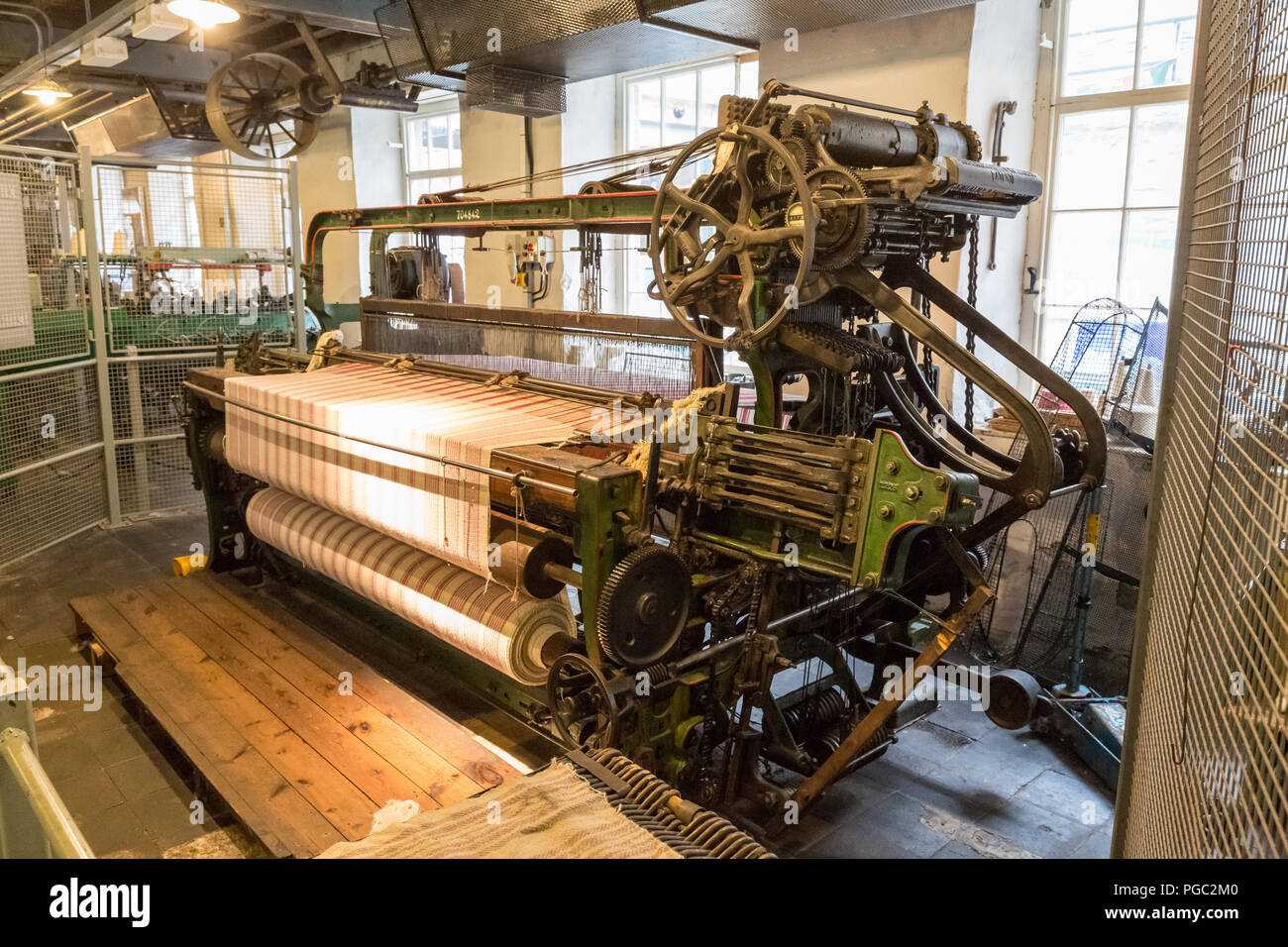 mechanical loom in the National Wool Museum, Drefach Felindre, Llandysul, Carmarthenshire, Wales, UK Stock Photohttps://www.alamy.com/image-license-details/?v=1https://www.alamy.com/mechanical-loom-in-the-national-wool-museum-drefach-felindre-llandysul-carmarthenshire-wales-uk-image216624464.html
mechanical loom in the National Wool Museum, Drefach Felindre, Llandysul, Carmarthenshire, Wales, UK Stock Photohttps://www.alamy.com/image-license-details/?v=1https://www.alamy.com/mechanical-loom-in-the-national-wool-museum-drefach-felindre-llandysul-carmarthenshire-wales-uk-image216624464.htmlRFPGC2M0–mechanical loom in the National Wool Museum, Drefach Felindre, Llandysul, Carmarthenshire, Wales, UK
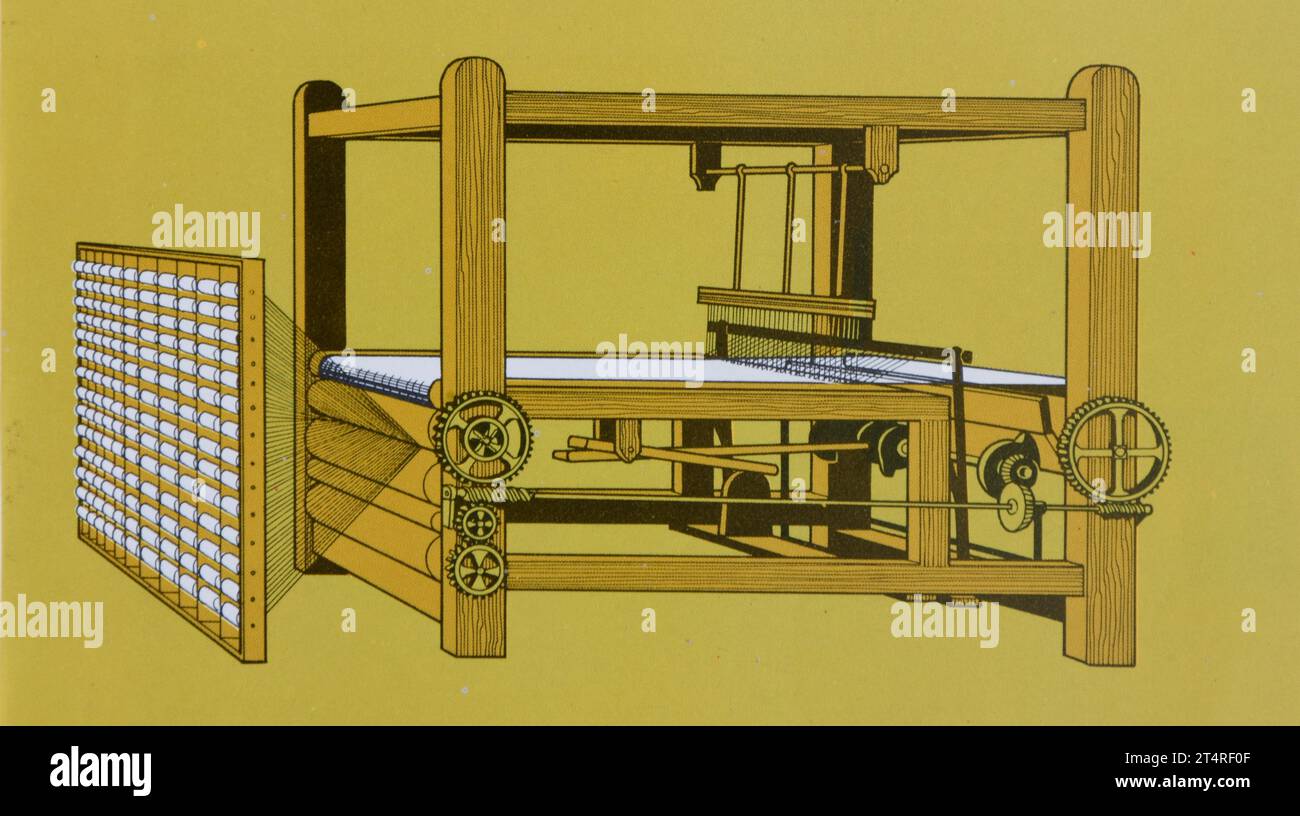 First mechanical loom by Edmund Cartwright (1743-1823), English inventor. Cartwright designed his first power loom in 1784 and patented it in 1785. Stock Photohttps://www.alamy.com/image-license-details/?v=1https://www.alamy.com/first-mechanical-loom-by-edmund-cartwright-1743-1823-english-inventor-cartwright-designed-his-first-power-loom-in-1784-and-patented-it-in-1785-image570917439.html
First mechanical loom by Edmund Cartwright (1743-1823), English inventor. Cartwright designed his first power loom in 1784 and patented it in 1785. Stock Photohttps://www.alamy.com/image-license-details/?v=1https://www.alamy.com/first-mechanical-loom-by-edmund-cartwright-1743-1823-english-inventor-cartwright-designed-his-first-power-loom-in-1784-and-patented-it-in-1785-image570917439.htmlRM2T4RF0F–First mechanical loom by Edmund Cartwright (1743-1823), English inventor. Cartwright designed his first power loom in 1784 and patented it in 1785.
 Harris Tweed manufacture . The finished cloth on the mechanical loom . Isle of Harris , Scotland March 1968 Stock Photohttps://www.alamy.com/image-license-details/?v=1https://www.alamy.com/harris-tweed-manufacture-the-finished-cloth-on-the-mechanical-loom-isle-of-harris-scotland-march-1968-image623387093.html
Harris Tweed manufacture . The finished cloth on the mechanical loom . Isle of Harris , Scotland March 1968 Stock Photohttps://www.alamy.com/image-license-details/?v=1https://www.alamy.com/harris-tweed-manufacture-the-finished-cloth-on-the-mechanical-loom-isle-of-harris-scotland-march-1968-image623387093.htmlRM2Y65MGN–Harris Tweed manufacture . The finished cloth on the mechanical loom . Isle of Harris , Scotland March 1968
 Silk production, Usbek woman working on a mechanical loom, Silk Road, Fergana Valley, Uzbekistan, Central Asia Stock Photohttps://www.alamy.com/image-license-details/?v=1https://www.alamy.com/stock-photo-silk-production-usbek-woman-working-on-a-mechanical-loom-silk-road-34622563.html
Silk production, Usbek woman working on a mechanical loom, Silk Road, Fergana Valley, Uzbekistan, Central Asia Stock Photohttps://www.alamy.com/image-license-details/?v=1https://www.alamy.com/stock-photo-silk-production-usbek-woman-working-on-a-mechanical-loom-silk-road-34622563.htmlRMC095C3–Silk production, Usbek woman working on a mechanical loom, Silk Road, Fergana Valley, Uzbekistan, Central Asia
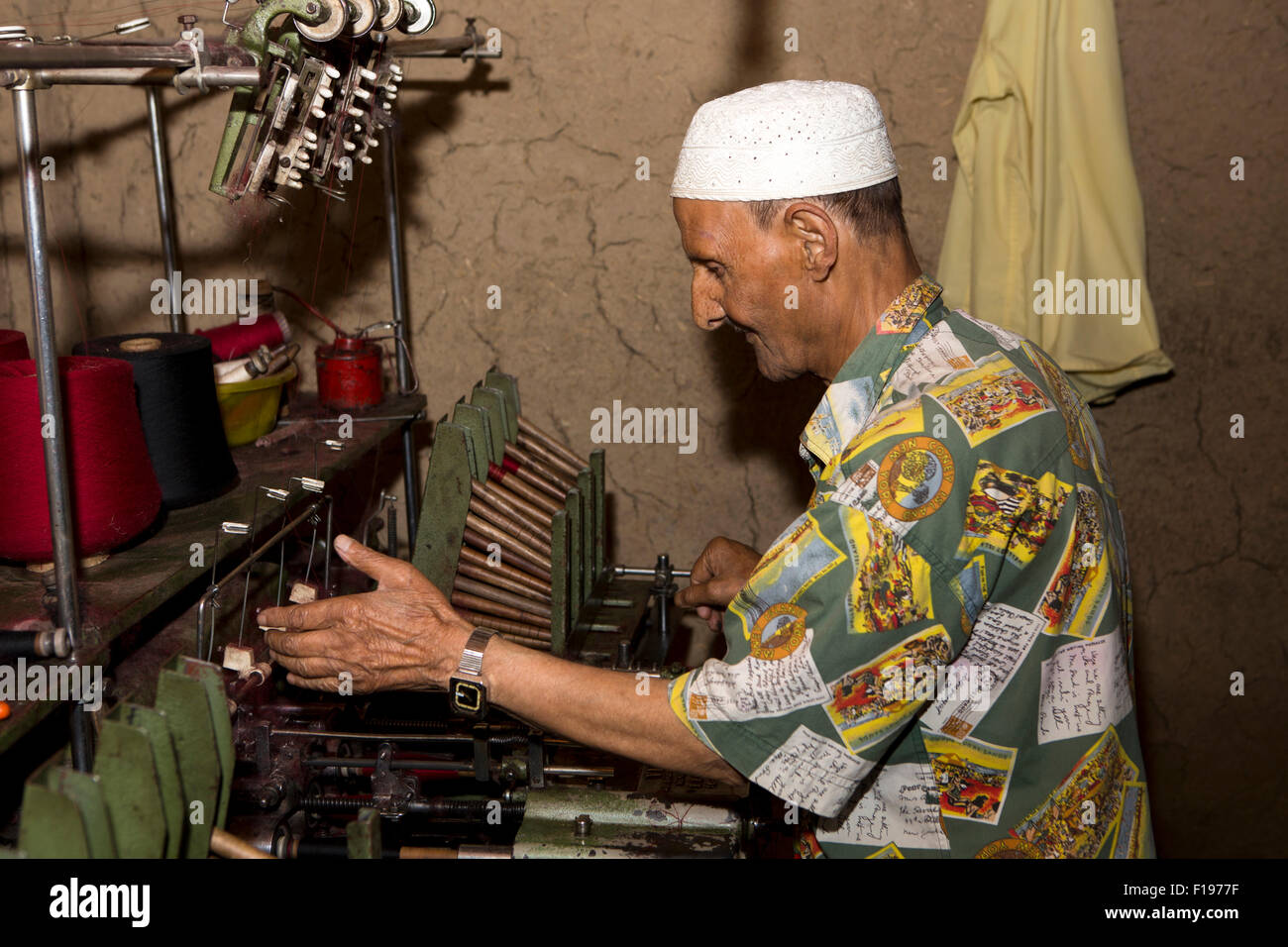 India, Jammu & Kashmir, Srinagar, pashmina production, man weaving pasminas on mechanical loom in dark workshop Stock Photohttps://www.alamy.com/image-license-details/?v=1https://www.alamy.com/stock-photo-india-jammu-kashmir-srinagar-pashmina-production-man-weaving-pasminas-86869763.html
India, Jammu & Kashmir, Srinagar, pashmina production, man weaving pasminas on mechanical loom in dark workshop Stock Photohttps://www.alamy.com/image-license-details/?v=1https://www.alamy.com/stock-photo-india-jammu-kashmir-srinagar-pashmina-production-man-weaving-pasminas-86869763.htmlRMF1977F–India, Jammu & Kashmir, Srinagar, pashmina production, man weaving pasminas on mechanical loom in dark workshop
 Woman works on mechanical loom making Khmer style cotton scarves on Koh Dach Island off central Phnom Penh, Cambodia. Stock Photohttps://www.alamy.com/image-license-details/?v=1https://www.alamy.com/woman-works-on-mechanical-loom-making-khmer-style-cotton-scarves-on-koh-dach-island-off-central-phnom-penh-cambodia-image359299946.html
Woman works on mechanical loom making Khmer style cotton scarves on Koh Dach Island off central Phnom Penh, Cambodia. Stock Photohttps://www.alamy.com/image-license-details/?v=1https://www.alamy.com/woman-works-on-mechanical-loom-making-khmer-style-cotton-scarves-on-koh-dach-island-off-central-phnom-penh-cambodia-image359299946.htmlRF2BTFEMX–Woman works on mechanical loom making Khmer style cotton scarves on Koh Dach Island off central Phnom Penh, Cambodia.
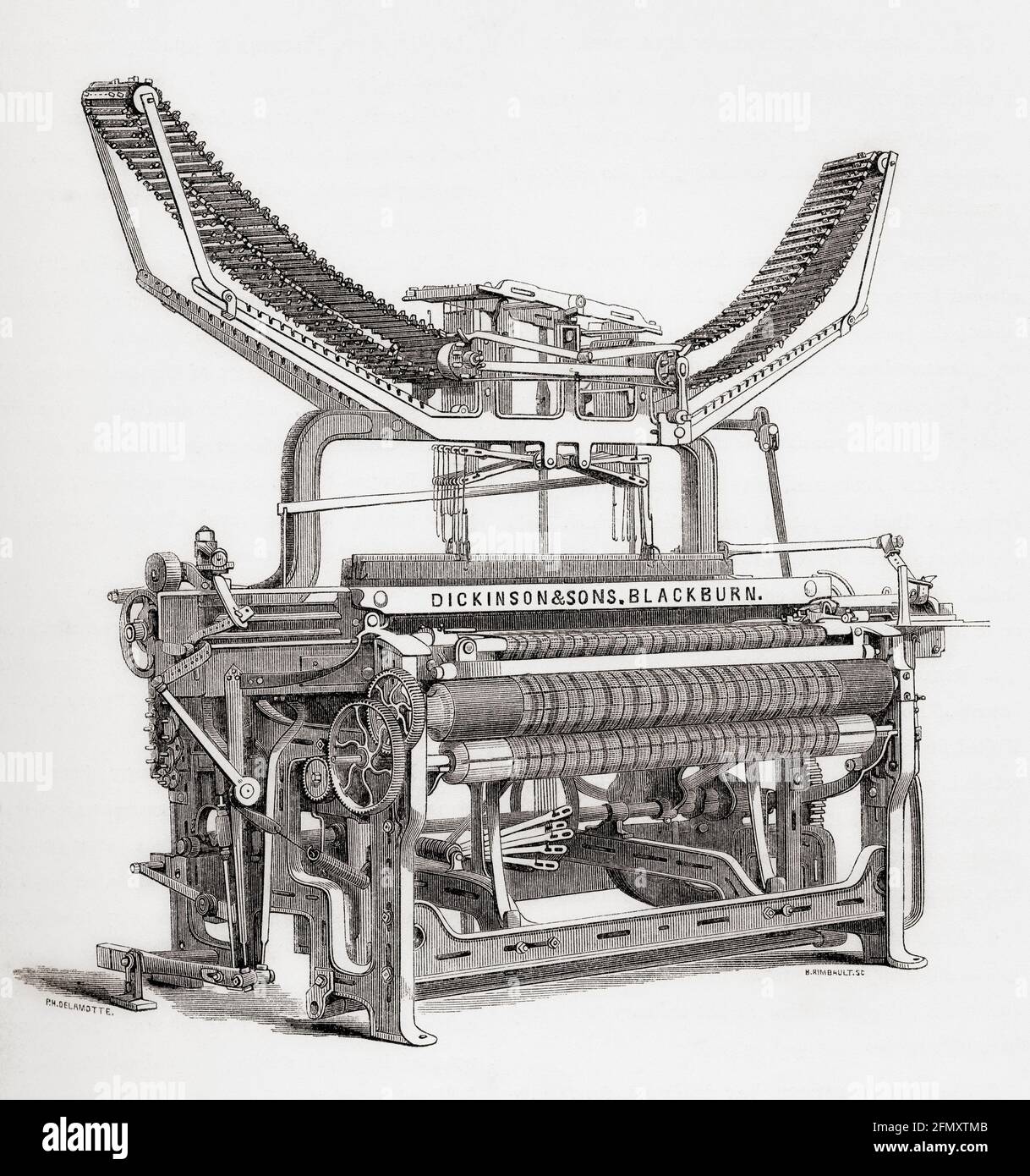 The Blackburn power loom invented by William Dickinson & Sons. From A Concise History of The International Exhibition of 1862, published 1862. Stock Photohttps://www.alamy.com/image-license-details/?v=1https://www.alamy.com/the-blackburn-power-loom-invented-by-william-dickinson-sons-from-a-concise-history-of-the-international-exhibition-of-1862-published-1862-image425932091.html
The Blackburn power loom invented by William Dickinson & Sons. From A Concise History of The International Exhibition of 1862, published 1862. Stock Photohttps://www.alamy.com/image-license-details/?v=1https://www.alamy.com/the-blackburn-power-loom-invented-by-william-dickinson-sons-from-a-concise-history-of-the-international-exhibition-of-1862-published-1862-image425932091.htmlRM2FMXTMB–The Blackburn power loom invented by William Dickinson & Sons. From A Concise History of The International Exhibition of 1862, published 1862.
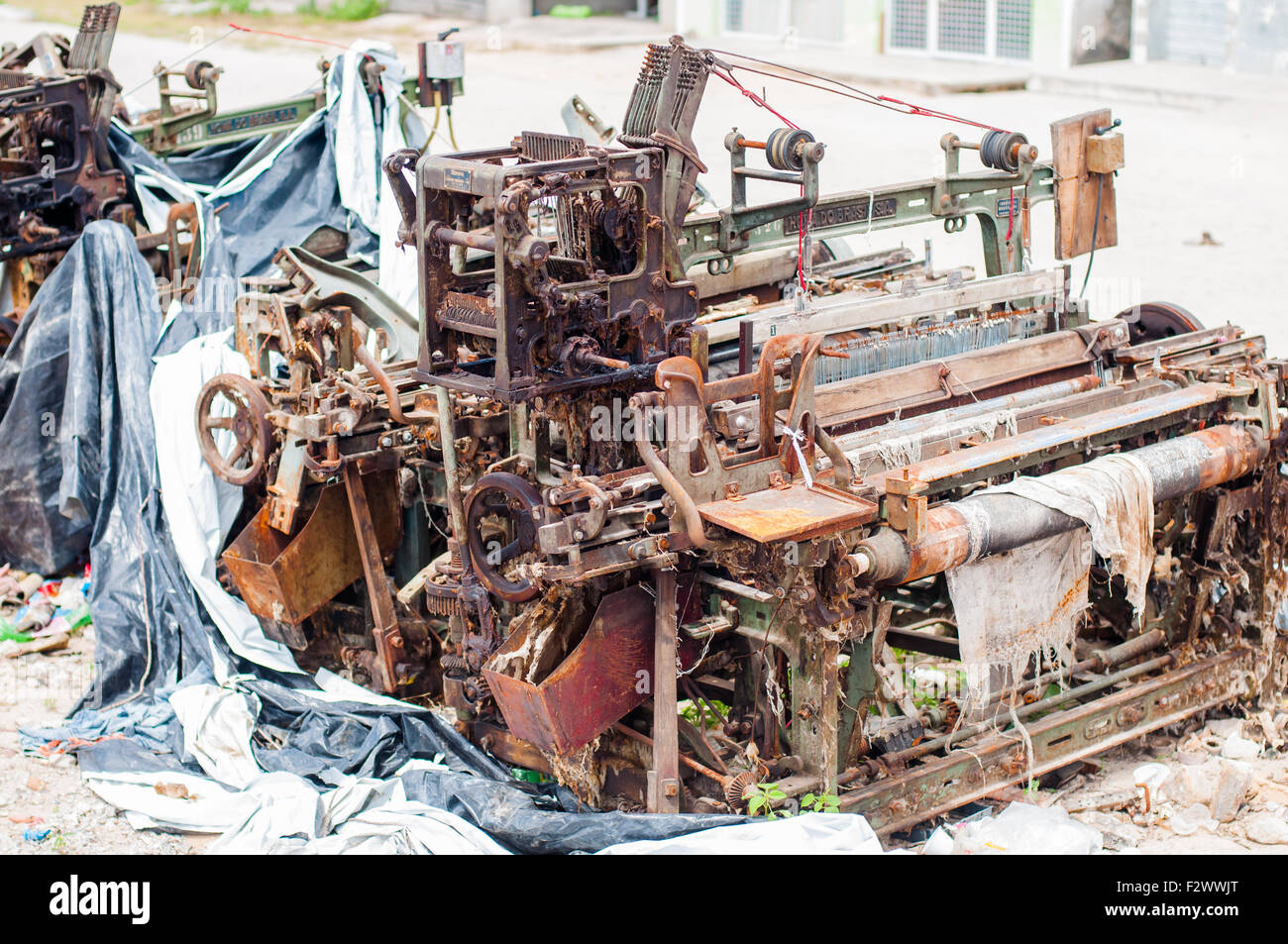 Old, worn out mechanical loom to be taken away Stock Photohttps://www.alamy.com/image-license-details/?v=1https://www.alamy.com/stock-photo-old-worn-out-mechanical-loom-to-be-taken-away-87850080.html
Old, worn out mechanical loom to be taken away Stock Photohttps://www.alamy.com/image-license-details/?v=1https://www.alamy.com/stock-photo-old-worn-out-mechanical-loom-to-be-taken-away-87850080.htmlRFF2WWJT–Old, worn out mechanical loom to be taken away
 France, Pas de Calais, Cote d'Opale (Opal Coast), Calais, City of Lace and Fashion (2009), preparation of a mechanical loom to weave lace Stock Photohttps://www.alamy.com/image-license-details/?v=1https://www.alamy.com/france-pas-de-calais-cote-dopale-opal-coast-calais-city-of-lace-and-fashion-2009-preparation-of-a-mechanical-loom-to-weave-lace-image499492516.html
France, Pas de Calais, Cote d'Opale (Opal Coast), Calais, City of Lace and Fashion (2009), preparation of a mechanical loom to weave lace Stock Photohttps://www.alamy.com/image-license-details/?v=1https://www.alamy.com/france-pas-de-calais-cote-dopale-opal-coast-calais-city-of-lace-and-fashion-2009-preparation-of-a-mechanical-loom-to-weave-lace-image499492516.htmlRM2M0HRPC–France, Pas de Calais, Cote d'Opale (Opal Coast), Calais, City of Lace and Fashion (2009), preparation of a mechanical loom to weave lace
 Study of Leonardo da Vinci. Weaving machines. Mechanical loom. 15th century. Model. Stock Photohttps://www.alamy.com/image-license-details/?v=1https://www.alamy.com/study-of-leonardo-da-vinci-weaving-machines-mechanical-loom-15th-century-image60242737.html
Study of Leonardo da Vinci. Weaving machines. Mechanical loom. 15th century. Model. Stock Photohttps://www.alamy.com/image-license-details/?v=1https://www.alamy.com/study-of-leonardo-da-vinci-weaving-machines-mechanical-loom-15th-century-image60242737.htmlRMDE0869–Study of Leonardo da Vinci. Weaving machines. Mechanical loom. 15th century. Model.
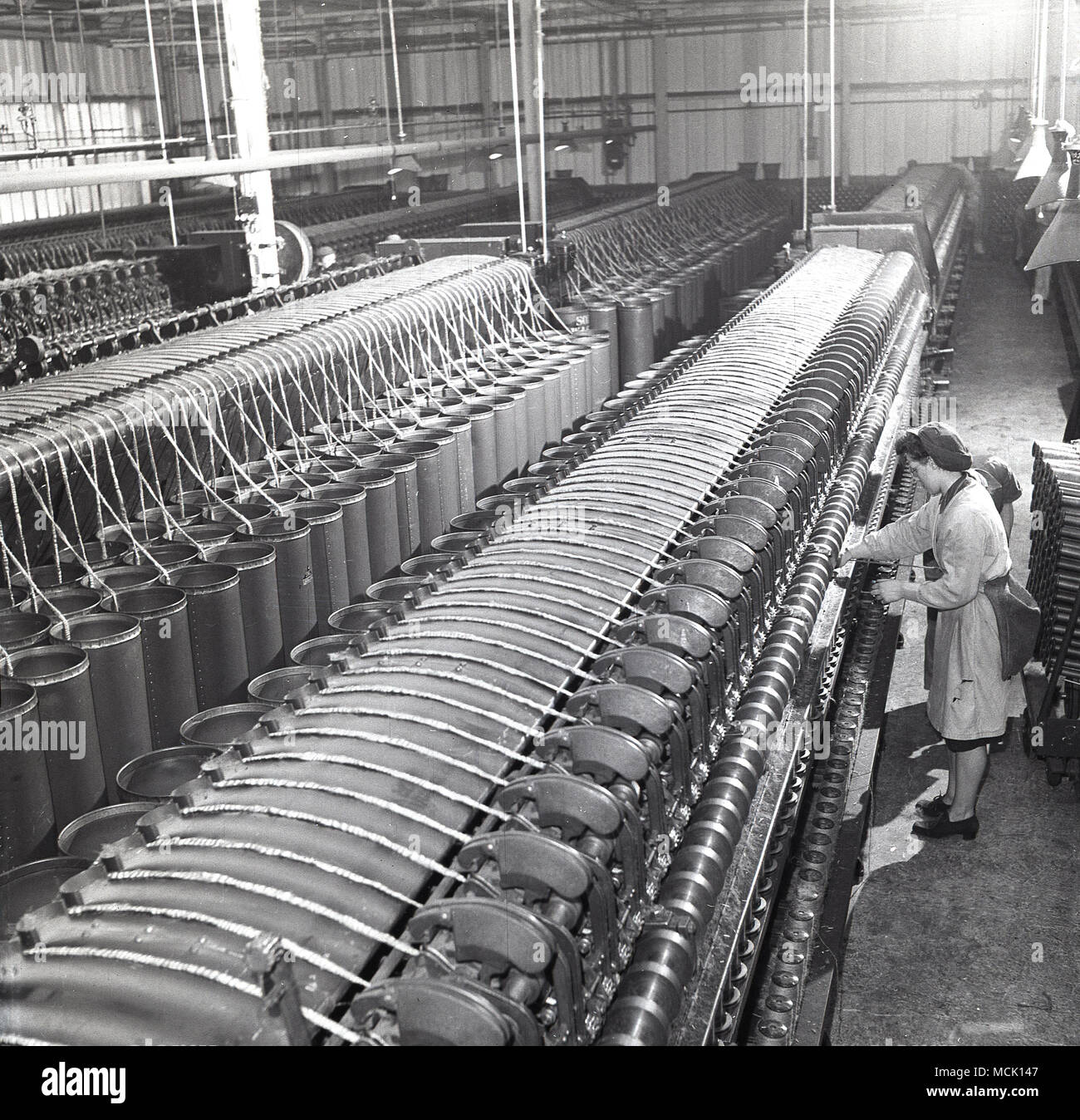 1950s, historical, a lone female working by herself on a giant textile loom inside a factory. She is wearing behind her a small hussain sack or bag. Stock Photohttps://www.alamy.com/image-license-details/?v=1https://www.alamy.com/1950s-historical-a-lone-female-working-by-herself-on-a-giant-textile-loom-inside-a-factory-she-is-wearing-behind-her-a-small-hussain-sack-or-bag-image179897543.html
1950s, historical, a lone female working by herself on a giant textile loom inside a factory. She is wearing behind her a small hussain sack or bag. Stock Photohttps://www.alamy.com/image-license-details/?v=1https://www.alamy.com/1950s-historical-a-lone-female-working-by-herself-on-a-giant-textile-loom-inside-a-factory-she-is-wearing-behind-her-a-small-hussain-sack-or-bag-image179897543.htmlRMMCK147–1950s, historical, a lone female working by herself on a giant textile loom inside a factory. She is wearing behind her a small hussain sack or bag.
 Sweater manufacturing factory owners by a mechanical loom in the plant in Moroleon Guanajuato Mexico Stock Photohttps://www.alamy.com/image-license-details/?v=1https://www.alamy.com/sweater-manufacturing-factory-owners-by-a-mechanical-loom-in-the-plant-image741211.html
Sweater manufacturing factory owners by a mechanical loom in the plant in Moroleon Guanajuato Mexico Stock Photohttps://www.alamy.com/image-license-details/?v=1https://www.alamy.com/sweater-manufacturing-factory-owners-by-a-mechanical-loom-in-the-plant-image741211.htmlRMAB4F5B–Sweater manufacturing factory owners by a mechanical loom in the plant in Moroleon Guanajuato Mexico
 19th century Industrial Revolution Era mechanical loom, Technology Museum, Berlin, Germany Stock Photohttps://www.alamy.com/image-license-details/?v=1https://www.alamy.com/stock-photo-19th-century-industrial-revolution-era-mechanical-loom-technology-29850855.html
19th century Industrial Revolution Era mechanical loom, Technology Museum, Berlin, Germany Stock Photohttps://www.alamy.com/image-license-details/?v=1https://www.alamy.com/stock-photo-19th-century-industrial-revolution-era-mechanical-loom-technology-29850855.htmlRMBMFR1Y–19th century Industrial Revolution Era mechanical loom, Technology Museum, Berlin, Germany
 Renaissance. Study of Leonardo da Vinci. Weaving machines. Mechanical loom. 15th century. Model. The Science and Technology Museum Leonardo da Vinci. Milan. Italy. Stock Photohttps://www.alamy.com/image-license-details/?v=1https://www.alamy.com/renaissance-study-of-leonardo-da-vinci-weaving-machines-mechanical-loom-15th-century-model-the-science-and-technology-museum-leonardo-da-vinci-milan-italy-image231189412.html
Renaissance. Study of Leonardo da Vinci. Weaving machines. Mechanical loom. 15th century. Model. The Science and Technology Museum Leonardo da Vinci. Milan. Italy. Stock Photohttps://www.alamy.com/image-license-details/?v=1https://www.alamy.com/renaissance-study-of-leonardo-da-vinci-weaving-machines-mechanical-loom-15th-century-model-the-science-and-technology-museum-leonardo-da-vinci-milan-italy-image231189412.htmlRMRC3GCM–Renaissance. Study of Leonardo da Vinci. Weaving machines. Mechanical loom. 15th century. Model. The Science and Technology Museum Leonardo da Vinci. Milan. Italy.
 Thread guiding needles on a mechanical loom in Damascus, which according to movement can leave different patterns on brocade fabric. Taken on 12.08.1995. Photo: Matthias Tödt | usage worldwide Stock Photohttps://www.alamy.com/image-license-details/?v=1https://www.alamy.com/stock-photo-thread-guiding-needles-on-a-mechanical-loom-in-damascus-which-according-124384733.html
Thread guiding needles on a mechanical loom in Damascus, which according to movement can leave different patterns on brocade fabric. Taken on 12.08.1995. Photo: Matthias Tödt | usage worldwide Stock Photohttps://www.alamy.com/image-license-details/?v=1https://www.alamy.com/stock-photo-thread-guiding-needles-on-a-mechanical-loom-in-damascus-which-according-124384733.htmlRMH6A5YW–Thread guiding needles on a mechanical loom in Damascus, which according to movement can leave different patterns on brocade fabric. Taken on 12.08.1995. Photo: Matthias Tödt | usage worldwide
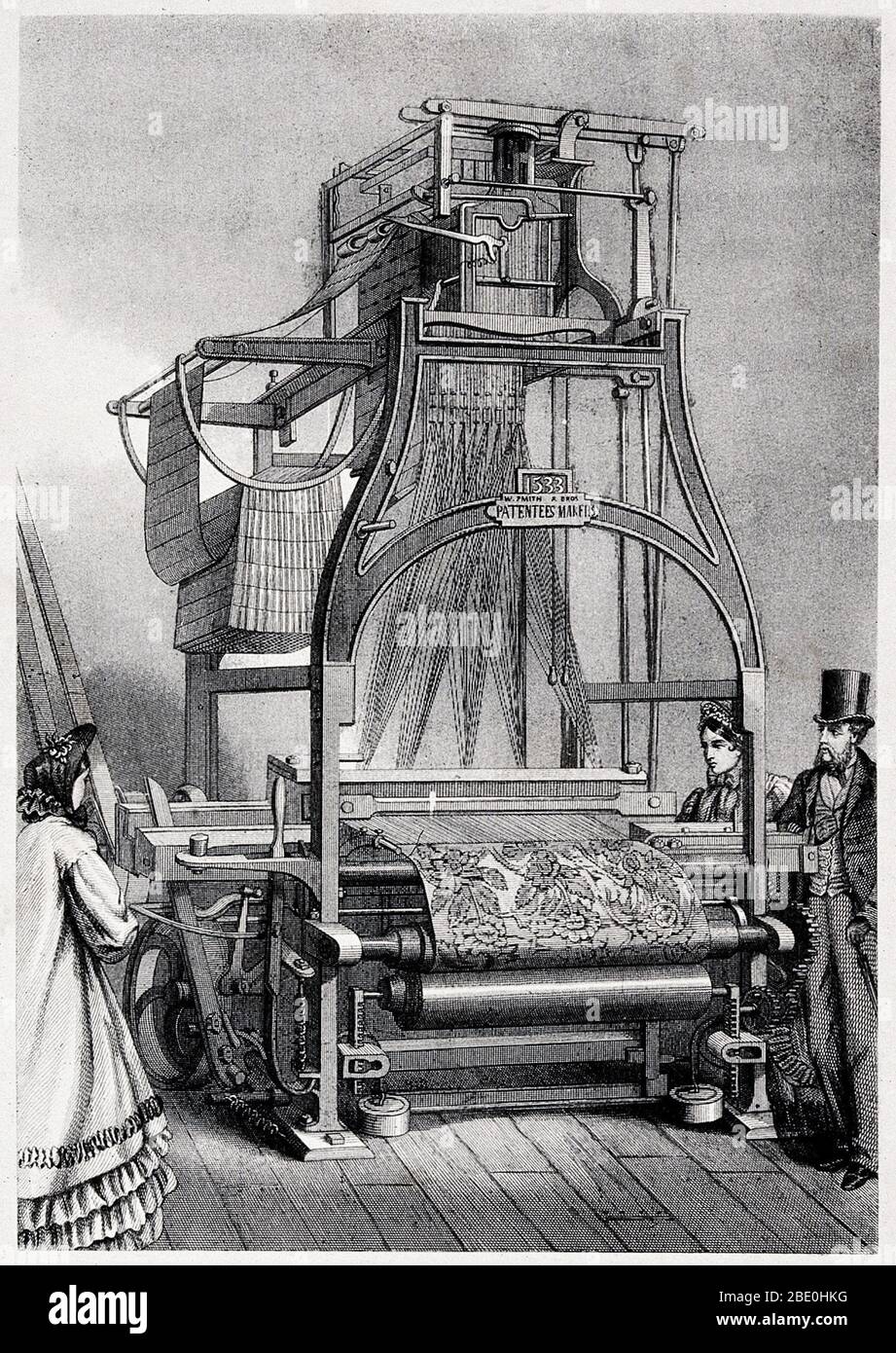 A mechanical Jacquard loom, front and rear elevations. Engraving by Pegard after L. Guiguet. This device for weaving textiles was invented in 1804 by the French weaver and inventor Joseph Marie Jacquard (1752-1834). It had a number of novel design features and was the first to be automatically controlled. It was controlled by a number of perforated cards, the holes corresponding to the weave pattern. When this was introduced into factories, there were riots among workers who feared losing their jobs. Stock Photohttps://www.alamy.com/image-license-details/?v=1https://www.alamy.com/a-mechanical-jacquard-loom-front-and-rear-elevations-engraving-by-pegard-after-l-guiguet-this-device-for-weaving-textiles-was-invented-in-1804-by-the-french-weaver-and-inventor-joseph-marie-jacquard-1752-1834-it-had-a-number-of-novel-design-features-and-was-the-first-to-be-automatically-controlled-it-was-controlled-by-a-number-of-perforated-cards-the-holes-corresponding-to-the-weave-pattern-when-this-was-introduced-into-factories-there-were-riots-among-workers-who-feared-losing-their-jobs-image352826420.html
A mechanical Jacquard loom, front and rear elevations. Engraving by Pegard after L. Guiguet. This device for weaving textiles was invented in 1804 by the French weaver and inventor Joseph Marie Jacquard (1752-1834). It had a number of novel design features and was the first to be automatically controlled. It was controlled by a number of perforated cards, the holes corresponding to the weave pattern. When this was introduced into factories, there were riots among workers who feared losing their jobs. Stock Photohttps://www.alamy.com/image-license-details/?v=1https://www.alamy.com/a-mechanical-jacquard-loom-front-and-rear-elevations-engraving-by-pegard-after-l-guiguet-this-device-for-weaving-textiles-was-invented-in-1804-by-the-french-weaver-and-inventor-joseph-marie-jacquard-1752-1834-it-had-a-number-of-novel-design-features-and-was-the-first-to-be-automatically-controlled-it-was-controlled-by-a-number-of-perforated-cards-the-holes-corresponding-to-the-weave-pattern-when-this-was-introduced-into-factories-there-were-riots-among-workers-who-feared-losing-their-jobs-image352826420.htmlRM2BE0HKG–A mechanical Jacquard loom, front and rear elevations. Engraving by Pegard after L. Guiguet. This device for weaving textiles was invented in 1804 by the French weaver and inventor Joseph Marie Jacquard (1752-1834). It had a number of novel design features and was the first to be automatically controlled. It was controlled by a number of perforated cards, the holes corresponding to the weave pattern. When this was introduced into factories, there were riots among workers who feared losing their jobs.
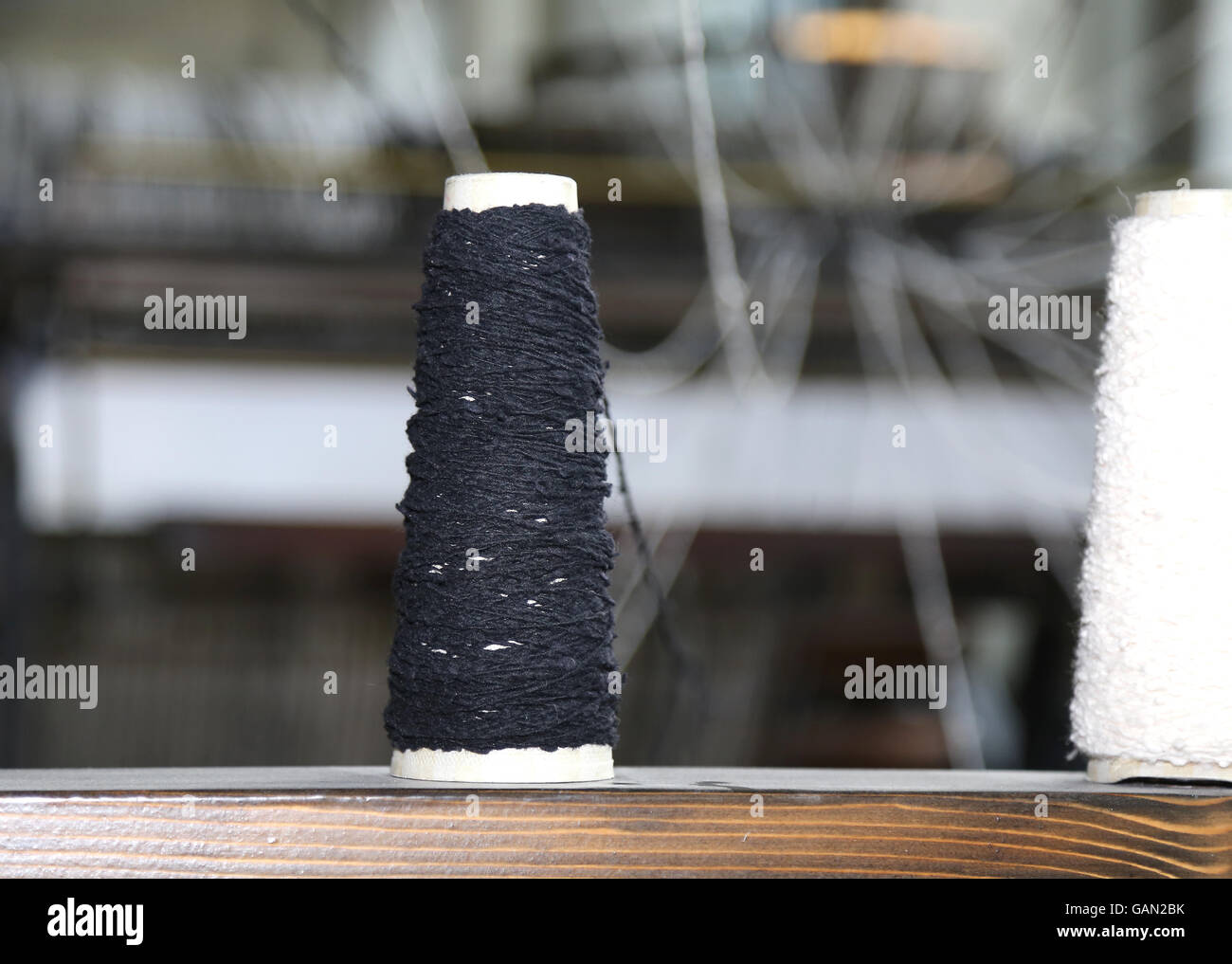 mechanical loom for the production of fabrics with the spool of thread for spinning Stock Photohttps://www.alamy.com/image-license-details/?v=1https://www.alamy.com/stock-photo-mechanical-loom-for-the-production-of-fabrics-with-the-spool-of-thread-109871655.html
mechanical loom for the production of fabrics with the spool of thread for spinning Stock Photohttps://www.alamy.com/image-license-details/?v=1https://www.alamy.com/stock-photo-mechanical-loom-for-the-production-of-fabrics-with-the-spool-of-thread-109871655.htmlRFGAN2BK–mechanical loom for the production of fabrics with the spool of thread for spinning
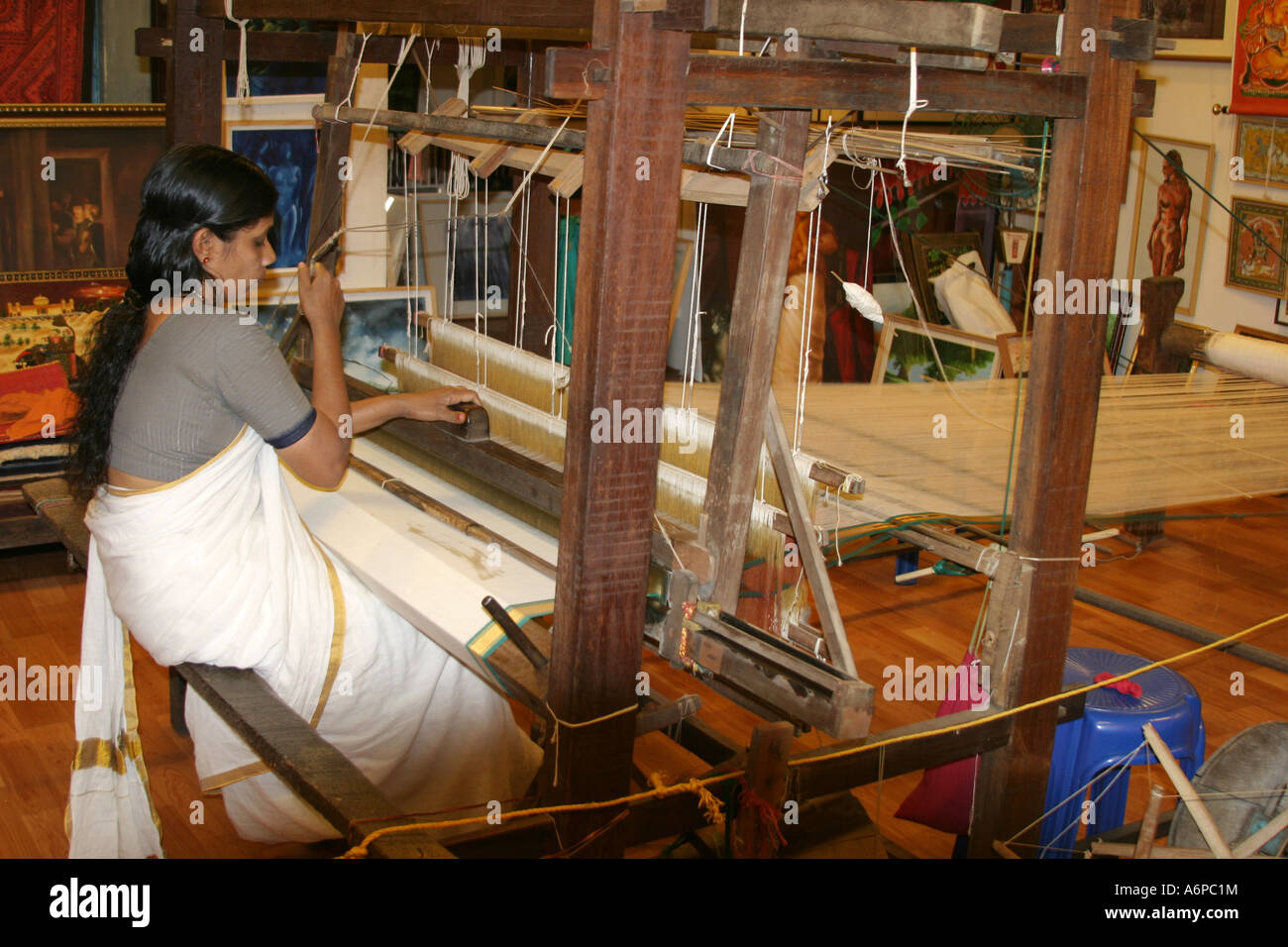 Indian woman using a wooden mechanical loom to weav e in Jew Town ,Cochin,India Stock Photohttps://www.alamy.com/image-license-details/?v=1https://www.alamy.com/stock-photo-indian-woman-using-a-wooden-mechanical-loom-to-weav-e-in-jew-town-11626063.html
Indian woman using a wooden mechanical loom to weav e in Jew Town ,Cochin,India Stock Photohttps://www.alamy.com/image-license-details/?v=1https://www.alamy.com/stock-photo-indian-woman-using-a-wooden-mechanical-loom-to-weav-e-in-jew-town-11626063.htmlRMA6PC1M–Indian woman using a wooden mechanical loom to weav e in Jew Town ,Cochin,India
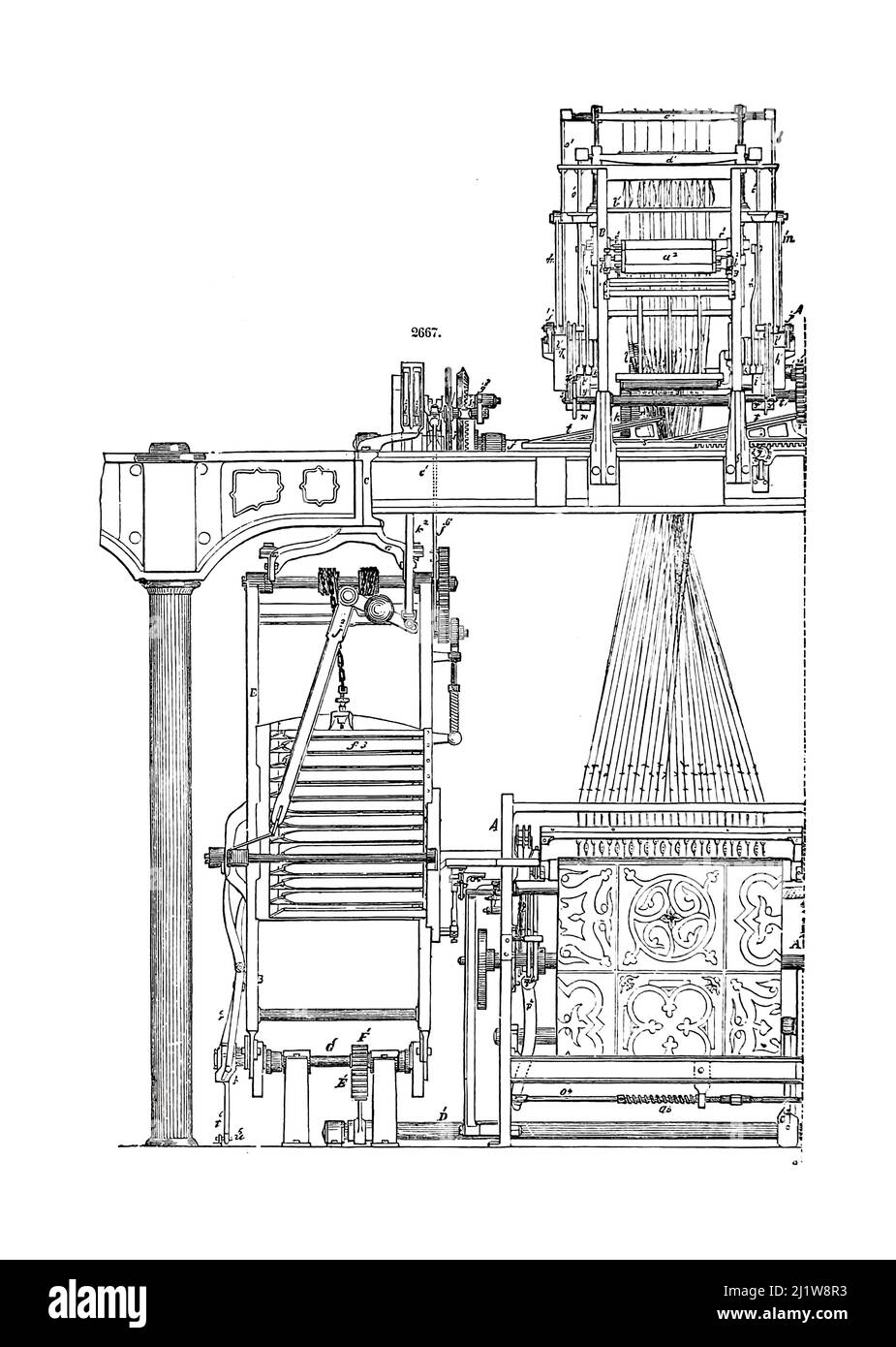 Mechanical Loom from Appleton's dictionary of machines, mechanics, engine-work, and engineering : illustrated with four thousand engravings on wood ; in two volumes by D. Appleton and Company Published New York : D. Appleton and Co 1873 Stock Photohttps://www.alamy.com/image-license-details/?v=1https://www.alamy.com/mechanical-loom-from-appletons-dictionary-of-machines-mechanics-engine-work-and-engineering-illustrated-with-four-thousand-engravings-on-wood-in-two-volumes-by-d-appleton-and-company-published-new-york-d-appleton-and-co-1873-image465850311.html
Mechanical Loom from Appleton's dictionary of machines, mechanics, engine-work, and engineering : illustrated with four thousand engravings on wood ; in two volumes by D. Appleton and Company Published New York : D. Appleton and Co 1873 Stock Photohttps://www.alamy.com/image-license-details/?v=1https://www.alamy.com/mechanical-loom-from-appletons-dictionary-of-machines-mechanics-engine-work-and-engineering-illustrated-with-four-thousand-engravings-on-wood-in-two-volumes-by-d-appleton-and-company-published-new-york-d-appleton-and-co-1873-image465850311.htmlRF2J1W8R3–Mechanical Loom from Appleton's dictionary of machines, mechanics, engine-work, and engineering : illustrated with four thousand engravings on wood ; in two volumes by D. Appleton and Company Published New York : D. Appleton and Co 1873
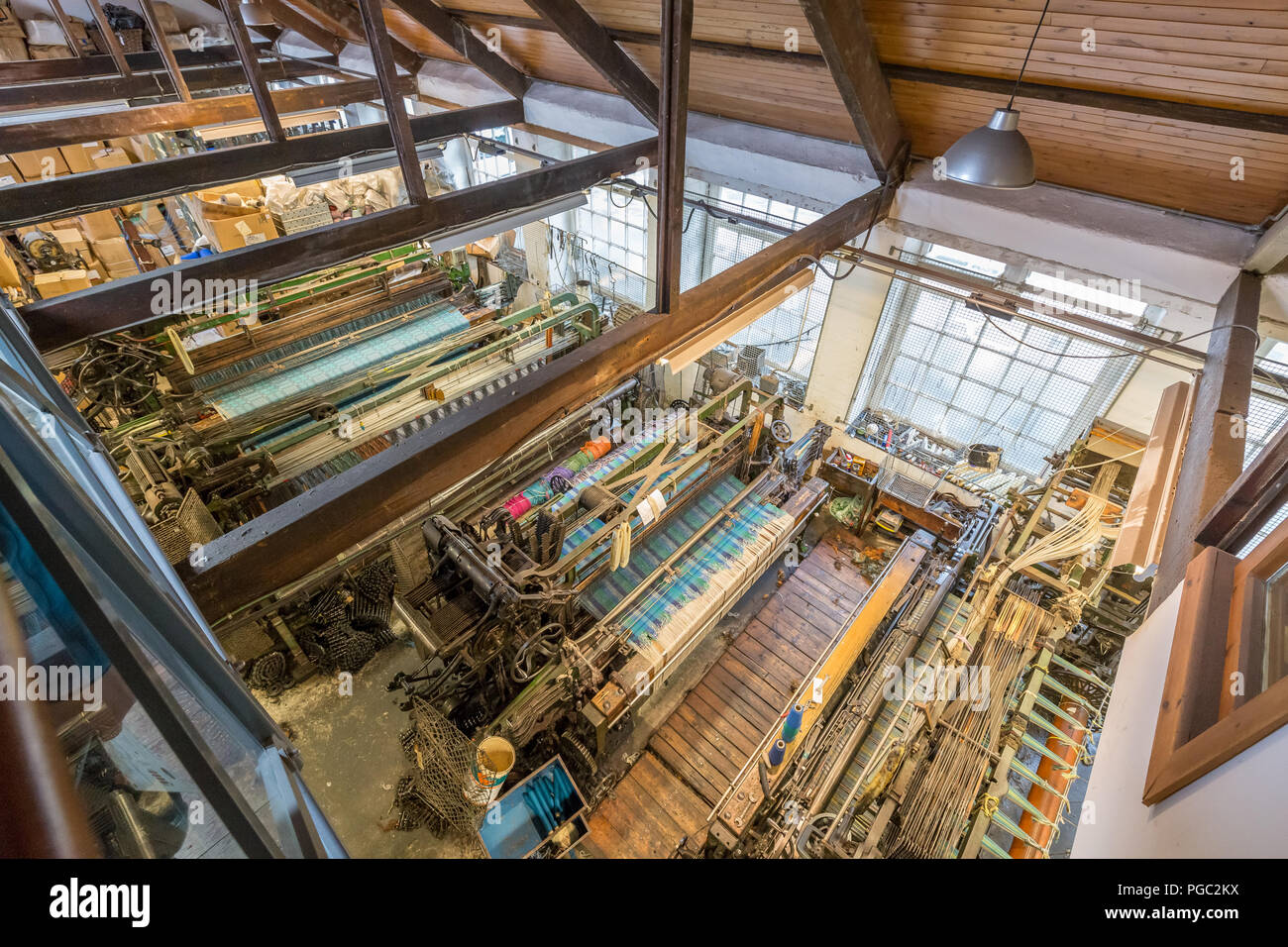 mechanical loom in the National Wool Museum, Drefach Felindre, Llandysul, Carmarthenshire, Wales, UK Stock Photohttps://www.alamy.com/image-license-details/?v=1https://www.alamy.com/mechanical-loom-in-the-national-wool-museum-drefach-felindre-llandysul-carmarthenshire-wales-uk-image216624462.html
mechanical loom in the National Wool Museum, Drefach Felindre, Llandysul, Carmarthenshire, Wales, UK Stock Photohttps://www.alamy.com/image-license-details/?v=1https://www.alamy.com/mechanical-loom-in-the-national-wool-museum-drefach-felindre-llandysul-carmarthenshire-wales-uk-image216624462.htmlRFPGC2KX–mechanical loom in the National Wool Museum, Drefach Felindre, Llandysul, Carmarthenshire, Wales, UK
 Jacquard Loom, 19th Century Stock Photohttps://www.alamy.com/image-license-details/?v=1https://www.alamy.com/stock-photo-jacquard-loom-19th-century-135042685.html
Jacquard Loom, 19th Century Stock Photohttps://www.alamy.com/image-license-details/?v=1https://www.alamy.com/stock-photo-jacquard-loom-19th-century-135042685.htmlRMHRKM91–Jacquard Loom, 19th Century
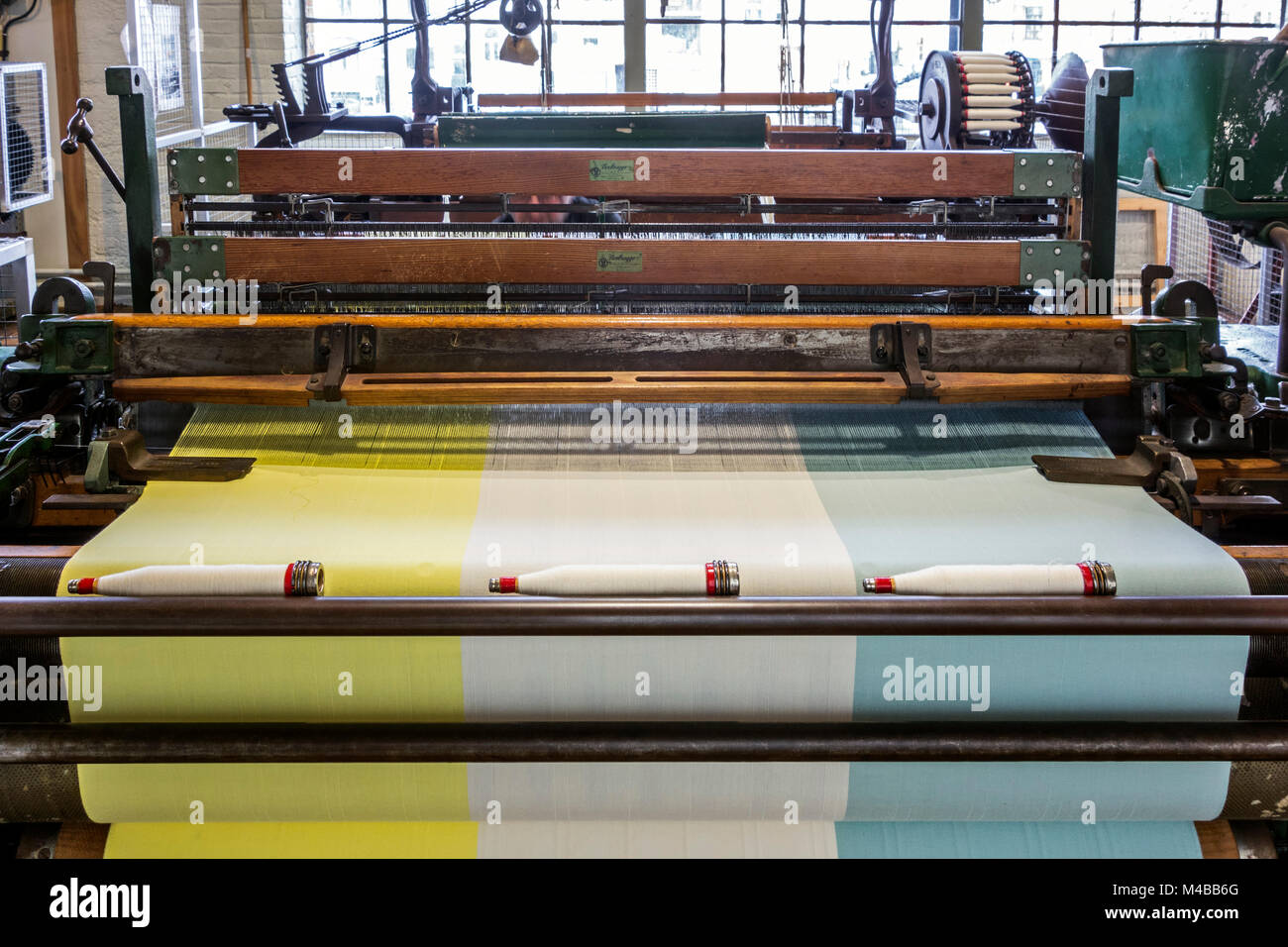 Mechanical flying shuttle loom / shuttle weaving machine in cotton mill / spinning-mill Stock Photohttps://www.alamy.com/image-license-details/?v=1https://www.alamy.com/stock-photo-mechanical-flying-shuttle-loom-shuttle-weaving-machine-in-cotton-mill-174812584.html
Mechanical flying shuttle loom / shuttle weaving machine in cotton mill / spinning-mill Stock Photohttps://www.alamy.com/image-license-details/?v=1https://www.alamy.com/stock-photo-mechanical-flying-shuttle-loom-shuttle-weaving-machine-in-cotton-mill-174812584.htmlRMM4BB6G–Mechanical flying shuttle loom / shuttle weaving machine in cotton mill / spinning-mill
 Colorful Fabric Woven By Vintage Mechanical Loom Stock Photohttps://www.alamy.com/image-license-details/?v=1https://www.alamy.com/colorful-fabric-woven-by-vintage-mechanical-loom-image596269031.html
Colorful Fabric Woven By Vintage Mechanical Loom Stock Photohttps://www.alamy.com/image-license-details/?v=1https://www.alamy.com/colorful-fabric-woven-by-vintage-mechanical-loom-image596269031.htmlRF2WJ2B6F–Colorful Fabric Woven By Vintage Mechanical Loom
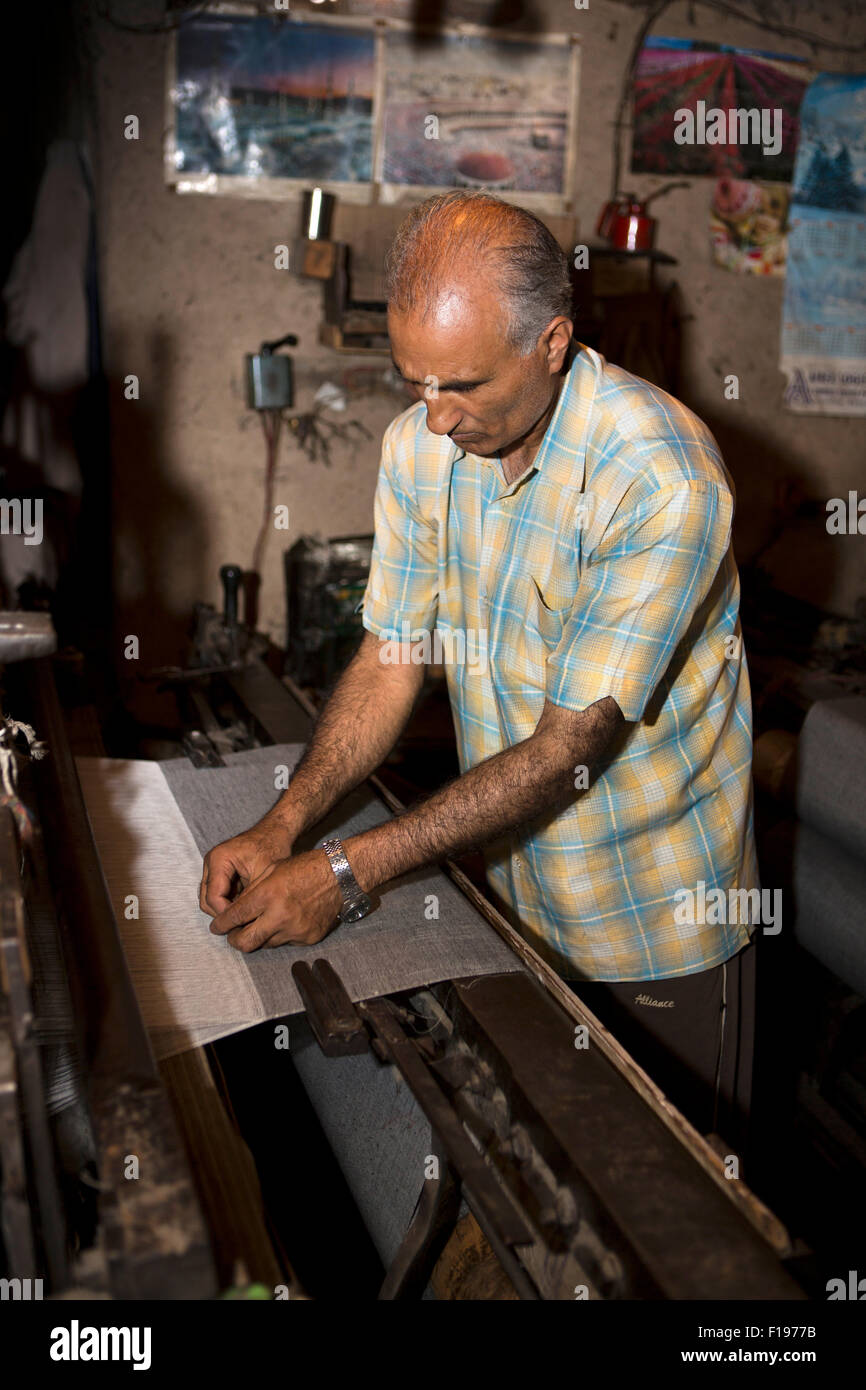 India, Jammu & Kashmir, Srinagar, pashmina production, man weaving pasminas on mechanical loom in dark workshop Stock Photohttps://www.alamy.com/image-license-details/?v=1https://www.alamy.com/stock-photo-india-jammu-kashmir-srinagar-pashmina-production-man-weaving-pasminas-86869759.html
India, Jammu & Kashmir, Srinagar, pashmina production, man weaving pasminas on mechanical loom in dark workshop Stock Photohttps://www.alamy.com/image-license-details/?v=1https://www.alamy.com/stock-photo-india-jammu-kashmir-srinagar-pashmina-production-man-weaving-pasminas-86869759.htmlRMF1977B–India, Jammu & Kashmir, Srinagar, pashmina production, man weaving pasminas on mechanical loom in dark workshop
 Woman works on mechanical loom making Khmer style cotton scarves on Koh Dach Island off central Phnom Penh, Cambodia. Stock Photohttps://www.alamy.com/image-license-details/?v=1https://www.alamy.com/woman-works-on-mechanical-loom-making-khmer-style-cotton-scarves-on-koh-dach-island-off-central-phnom-penh-cambodia-image359299941.html
Woman works on mechanical loom making Khmer style cotton scarves on Koh Dach Island off central Phnom Penh, Cambodia. Stock Photohttps://www.alamy.com/image-license-details/?v=1https://www.alamy.com/woman-works-on-mechanical-loom-making-khmer-style-cotton-scarves-on-koh-dach-island-off-central-phnom-penh-cambodia-image359299941.htmlRF2BTFEMN–Woman works on mechanical loom making Khmer style cotton scarves on Koh Dach Island off central Phnom Penh, Cambodia.
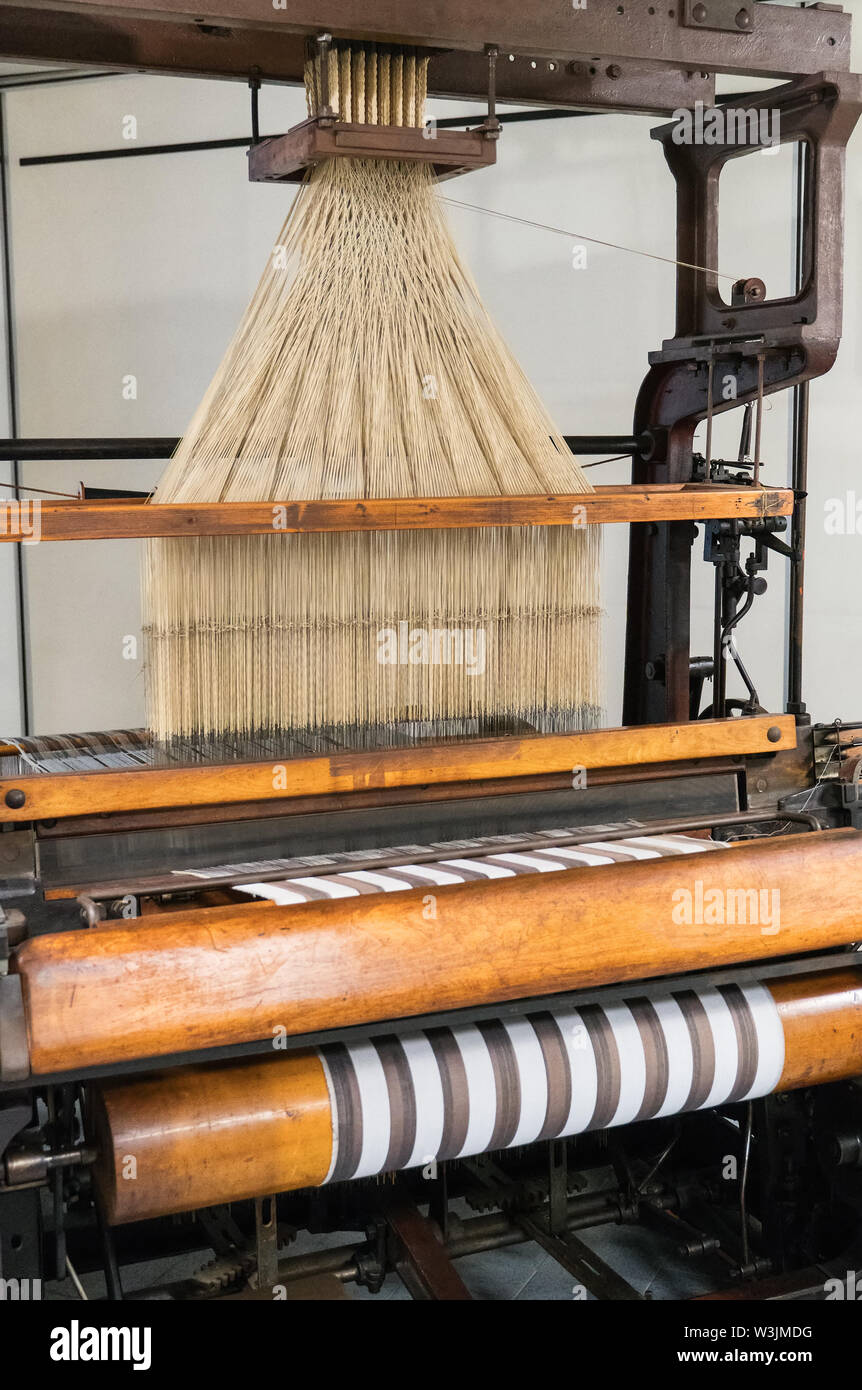 Retro mechanical loom with jacquard harness. Stock Photohttps://www.alamy.com/image-license-details/?v=1https://www.alamy.com/retro-mechanical-loom-with-jacquard-harness-image260410684.html
Retro mechanical loom with jacquard harness. Stock Photohttps://www.alamy.com/image-license-details/?v=1https://www.alamy.com/retro-mechanical-loom-with-jacquard-harness-image260410684.htmlRFW3JMDG–Retro mechanical loom with jacquard harness.
 View of the hands of a weaver arranging cotton threads on a mechanical loom. Stock Photohttps://www.alamy.com/image-license-details/?v=1https://www.alamy.com/view-of-the-hands-of-a-weaver-arranging-cotton-threads-on-a-mechanical-loom-image359517398.html
View of the hands of a weaver arranging cotton threads on a mechanical loom. Stock Photohttps://www.alamy.com/image-license-details/?v=1https://www.alamy.com/view-of-the-hands-of-a-weaver-arranging-cotton-threads-on-a-mechanical-loom-image359517398.htmlRF2BTWC32–View of the hands of a weaver arranging cotton threads on a mechanical loom.
 France, Pas de Calais, Cote d'Opale (Opal Coast), Calais, City of Lace and Fashion (2009), lace woven on a mechanical loom Stock Photohttps://www.alamy.com/image-license-details/?v=1https://www.alamy.com/france-pas-de-calais-cote-dopale-opal-coast-calais-city-of-lace-and-fashion-2009-lace-woven-on-a-mechanical-loom-image499492538.html
France, Pas de Calais, Cote d'Opale (Opal Coast), Calais, City of Lace and Fashion (2009), lace woven on a mechanical loom Stock Photohttps://www.alamy.com/image-license-details/?v=1https://www.alamy.com/france-pas-de-calais-cote-dopale-opal-coast-calais-city-of-lace-and-fashion-2009-lace-woven-on-a-mechanical-loom-image499492538.htmlRM2M0HRR6–France, Pas de Calais, Cote d'Opale (Opal Coast), Calais, City of Lace and Fashion (2009), lace woven on a mechanical loom
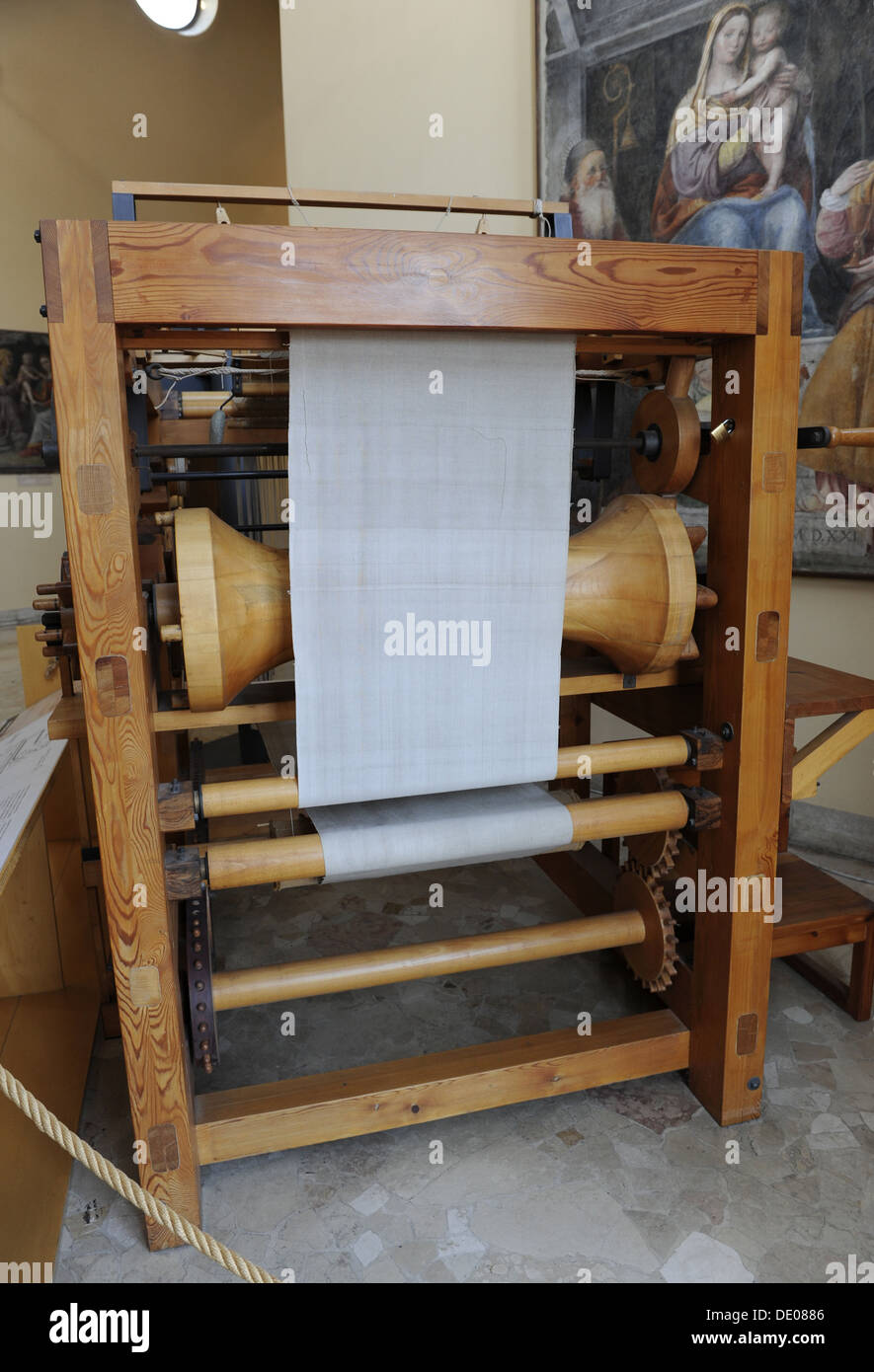 Study of Leonardo da Vinci. Weaving machines. Mechanical loom. 15th century. Model. Stock Photohttps://www.alamy.com/image-license-details/?v=1https://www.alamy.com/study-of-leonardo-da-vinci-weaving-machines-mechanical-loom-15th-century-image60242790.html
Study of Leonardo da Vinci. Weaving machines. Mechanical loom. 15th century. Model. Stock Photohttps://www.alamy.com/image-license-details/?v=1https://www.alamy.com/study-of-leonardo-da-vinci-weaving-machines-mechanical-loom-15th-century-image60242790.htmlRMDE0886–Study of Leonardo da Vinci. Weaving machines. Mechanical loom. 15th century. Model.
 1950s, historical, adult female weaver at work on a large single industrial mechanical weaving loom or electric power loom, Northern Ireland, UK. Stock Photohttps://www.alamy.com/image-license-details/?v=1https://www.alamy.com/1950s-historical-adult-female-weaver-at-work-on-a-large-single-industrial-mechanical-weaving-loom-or-electric-power-loom-northern-ireland-uk-image186879712.html
1950s, historical, adult female weaver at work on a large single industrial mechanical weaving loom or electric power loom, Northern Ireland, UK. Stock Photohttps://www.alamy.com/image-license-details/?v=1https://www.alamy.com/1950s-historical-adult-female-weaver-at-work-on-a-large-single-industrial-mechanical-weaving-loom-or-electric-power-loom-northern-ireland-uk-image186879712.htmlRMMT12YC–1950s, historical, adult female weaver at work on a large single industrial mechanical weaving loom or electric power loom, Northern Ireland, UK.
 Bildnummer: 54035827 Datum: 08.05.2010 Copyright: imago/Xinhua (100509) -- TIANJIN, May 9, 2010 (Xinhua) -- A visitor watches the iron-wood mechanical loom housed in the Tianjin Textile Museum, which opens to the public formally, inside the High- and New Technology Textile Industrial Park of the Tianjin Binhai (Sea shore) New District, in Tianjin, north China, May 8, 2010. Covering over 1,800 square meters, the Tianjin Textile Museum displays well over 7,000 pieces of exhibits, including obsolete spinning wheels, relic photos, certificates, clothing and textile raw materials of various histo Stock Photohttps://www.alamy.com/image-license-details/?v=1https://www.alamy.com/bildnummer-54035827-datum-08052010-copyright-imagoxinhua-100509-tianjin-may-9-2010-xinhua-a-visitor-watches-the-iron-wood-mechanical-loom-housed-in-the-tianjin-textile-museum-which-opens-to-the-public-formally-inside-the-high-and-new-technology-textile-industrial-park-of-the-tianjin-binhai-sea-shore-new-district-in-tianjin-north-china-may-8-2010-covering-over-1800-square-meters-the-tianjin-textile-museum-displays-well-over-7000-pieces-of-exhibits-including-obsolete-spinning-wheels-relic-photos-certificates-clothing-and-textile-raw-materials-of-various-histo-image562598666.html
Bildnummer: 54035827 Datum: 08.05.2010 Copyright: imago/Xinhua (100509) -- TIANJIN, May 9, 2010 (Xinhua) -- A visitor watches the iron-wood mechanical loom housed in the Tianjin Textile Museum, which opens to the public formally, inside the High- and New Technology Textile Industrial Park of the Tianjin Binhai (Sea shore) New District, in Tianjin, north China, May 8, 2010. Covering over 1,800 square meters, the Tianjin Textile Museum displays well over 7,000 pieces of exhibits, including obsolete spinning wheels, relic photos, certificates, clothing and textile raw materials of various histo Stock Photohttps://www.alamy.com/image-license-details/?v=1https://www.alamy.com/bildnummer-54035827-datum-08052010-copyright-imagoxinhua-100509-tianjin-may-9-2010-xinhua-a-visitor-watches-the-iron-wood-mechanical-loom-housed-in-the-tianjin-textile-museum-which-opens-to-the-public-formally-inside-the-high-and-new-technology-textile-industrial-park-of-the-tianjin-binhai-sea-shore-new-district-in-tianjin-north-china-may-8-2010-covering-over-1800-square-meters-the-tianjin-textile-museum-displays-well-over-7000-pieces-of-exhibits-including-obsolete-spinning-wheels-relic-photos-certificates-clothing-and-textile-raw-materials-of-various-histo-image562598666.htmlRM2RK8G9E–Bildnummer: 54035827 Datum: 08.05.2010 Copyright: imago/Xinhua (100509) -- TIANJIN, May 9, 2010 (Xinhua) -- A visitor watches the iron-wood mechanical loom housed in the Tianjin Textile Museum, which opens to the public formally, inside the High- and New Technology Textile Industrial Park of the Tianjin Binhai (Sea shore) New District, in Tianjin, north China, May 8, 2010. Covering over 1,800 square meters, the Tianjin Textile Museum displays well over 7,000 pieces of exhibits, including obsolete spinning wheels, relic photos, certificates, clothing and textile raw materials of various histo
 Vintage weaving loom machine exhibited at the Coir Museum, Cochin, Kerala, southern India Stock Photohttps://www.alamy.com/image-license-details/?v=1https://www.alamy.com/stock-photo-vintage-weaving-loom-machine-exhibited-at-the-coir-museum-cochin-kerala-82856038.html
Vintage weaving loom machine exhibited at the Coir Museum, Cochin, Kerala, southern India Stock Photohttps://www.alamy.com/image-license-details/?v=1https://www.alamy.com/stock-photo-vintage-weaving-loom-machine-exhibited-at-the-coir-museum-cochin-kerala-82856038.htmlRMEPPBM6–Vintage weaving loom machine exhibited at the Coir Museum, Cochin, Kerala, southern India
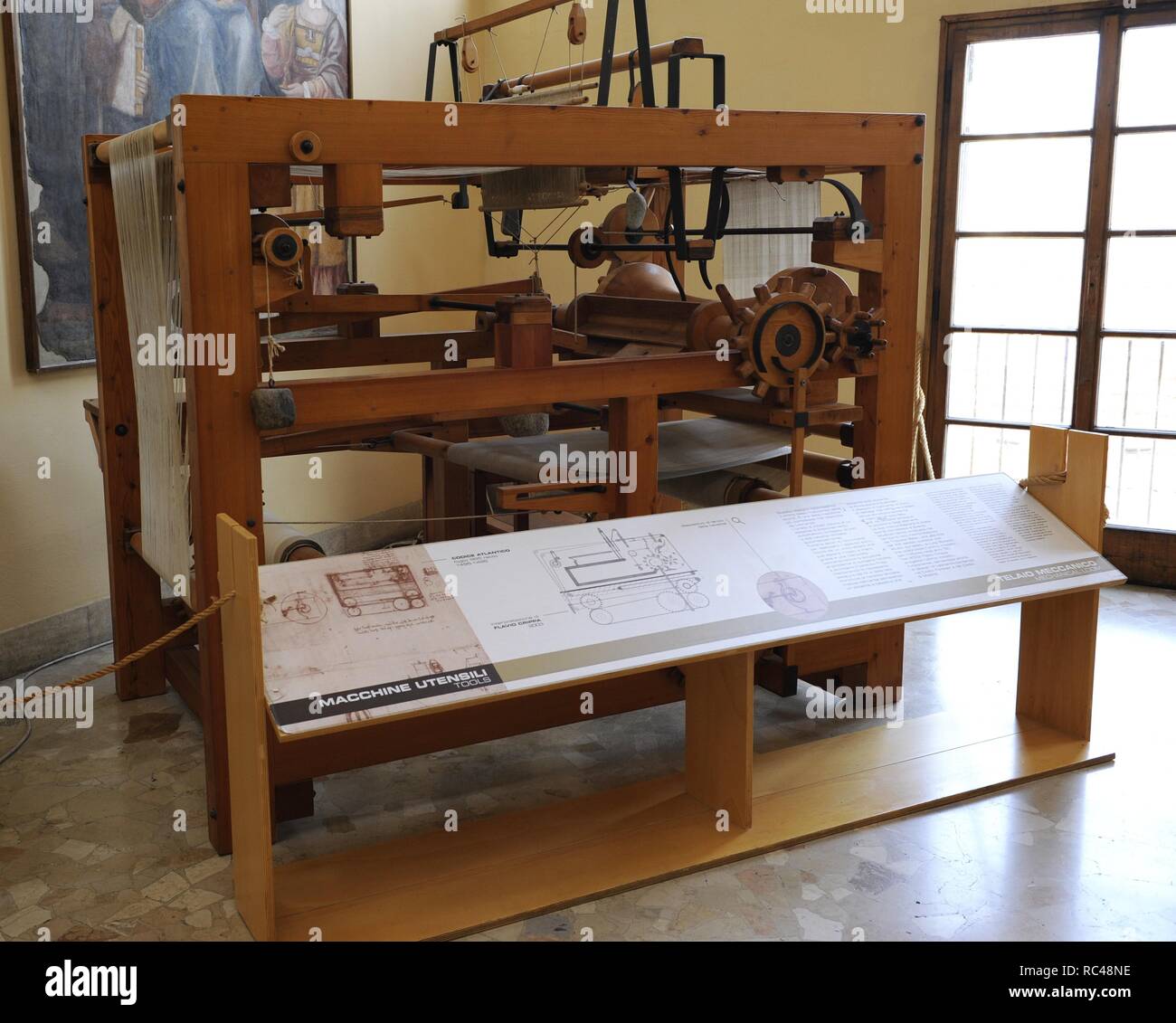 Renaissance. Study of Leonardo da Vinci. Weaving machines. Mechanical loom. 15th century. Model. The Science and Technology Museum Leonardo da Vinci. Milan. Italy. Stock Photohttps://www.alamy.com/image-license-details/?v=1https://www.alamy.com/renaissance-study-of-leonardo-da-vinci-weaving-machines-mechanical-loom-15th-century-model-the-science-and-technology-museum-leonardo-da-vinci-milan-italy-image231205338.html
Renaissance. Study of Leonardo da Vinci. Weaving machines. Mechanical loom. 15th century. Model. The Science and Technology Museum Leonardo da Vinci. Milan. Italy. Stock Photohttps://www.alamy.com/image-license-details/?v=1https://www.alamy.com/renaissance-study-of-leonardo-da-vinci-weaving-machines-mechanical-loom-15th-century-model-the-science-and-technology-museum-leonardo-da-vinci-milan-italy-image231205338.htmlRMRC48NE–Renaissance. Study of Leonardo da Vinci. Weaving machines. Mechanical loom. 15th century. Model. The Science and Technology Museum Leonardo da Vinci. Milan. Italy.
 Abu Sayyah, one of the last brocade weavers in the Syrian capital. Taken on 12.08.1995. Every day Abu Sayyah stands behind his mechanical loom and with great concentration manages to weave around a metre of brocade fabric. Photo: Matthias Tödt | usage worldwide Stock Photohttps://www.alamy.com/image-license-details/?v=1https://www.alamy.com/stock-photo-abu-sayyah-one-of-the-last-brocade-weavers-in-the-syrian-capital-taken-124384737.html
Abu Sayyah, one of the last brocade weavers in the Syrian capital. Taken on 12.08.1995. Every day Abu Sayyah stands behind his mechanical loom and with great concentration manages to weave around a metre of brocade fabric. Photo: Matthias Tödt | usage worldwide Stock Photohttps://www.alamy.com/image-license-details/?v=1https://www.alamy.com/stock-photo-abu-sayyah-one-of-the-last-brocade-weavers-in-the-syrian-capital-taken-124384737.htmlRMH6A601–Abu Sayyah, one of the last brocade weavers in the Syrian capital. Taken on 12.08.1995. Every day Abu Sayyah stands behind his mechanical loom and with great concentration manages to weave around a metre of brocade fabric. Photo: Matthias Tödt | usage worldwide
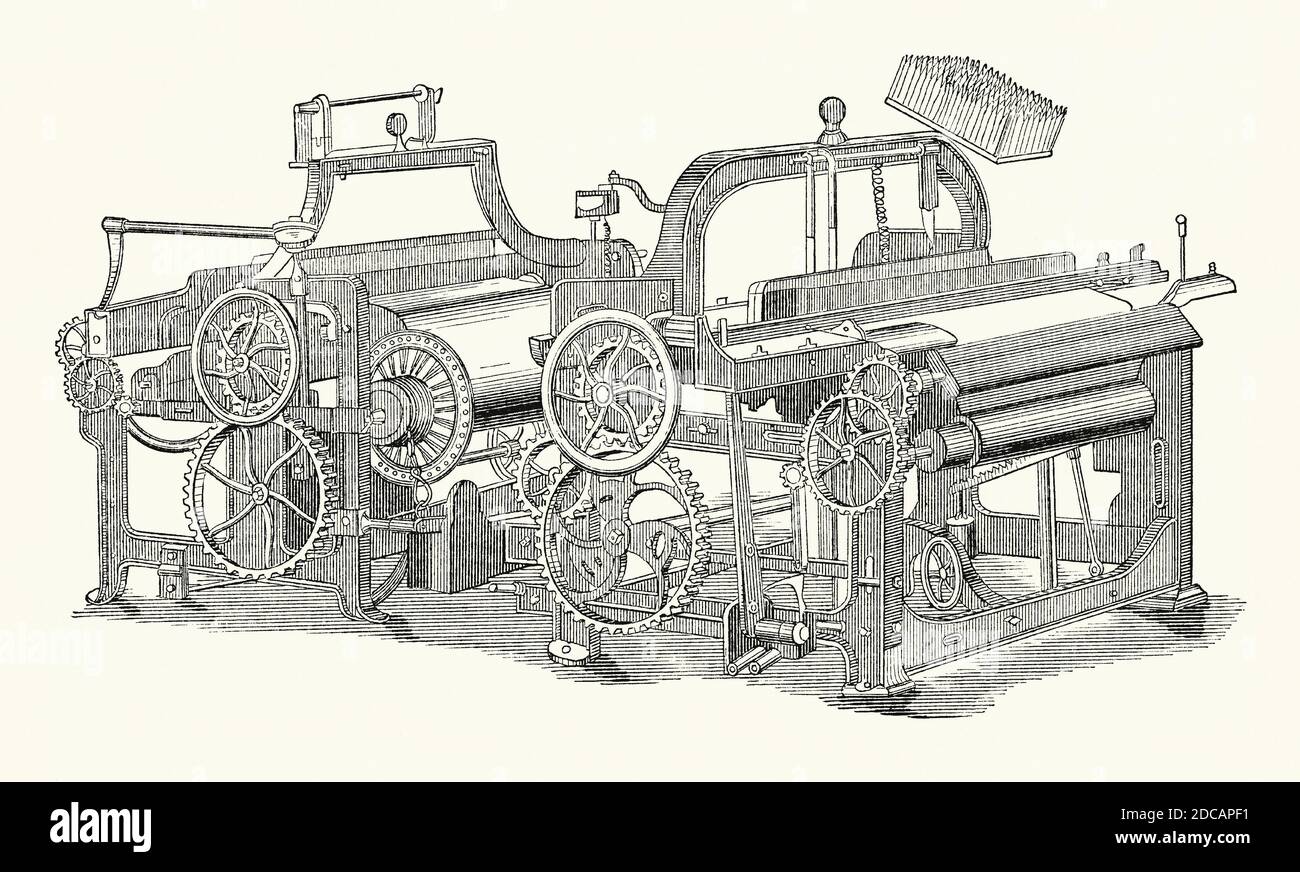 An old engraving of a cotton loom (left) and a linen loom (right). It is from a Victorian mechanical engineering book of the 1880s. A loom is a device used to weave cloth. The basic purpose of any loom is to hold the warp threads under tension to facilitate the interweaving of the weft threads. Englishman Edmund Cartwright built and patented a power loom in 1785, and it was this that was adopted by cotton industry. Water and/or steam provided the power needed to run the looms, usually by belt drives to the individual looms. The loom shape and its mechanics varied enormously. Stock Photohttps://www.alamy.com/image-license-details/?v=1https://www.alamy.com/an-old-engraving-of-a-cotton-loom-left-and-a-linen-loom-right-it-is-from-a-victorian-mechanical-engineering-book-of-the-1880s-a-loom-is-a-device-used-to-weave-cloth-the-basic-purpose-of-any-loom-is-to-hold-the-warp-threads-under-tension-to-facilitate-the-interweaving-of-the-weft-threads-englishman-edmund-cartwright-built-and-patented-a-power-loom-in-1785-and-it-was-this-that-was-adopted-by-cotton-industry-water-andor-steam-provided-the-power-needed-to-run-the-looms-usually-by-belt-drives-to-the-individual-looms-the-loom-shape-and-its-mechanics-varied-enormously-image386241157.html
An old engraving of a cotton loom (left) and a linen loom (right). It is from a Victorian mechanical engineering book of the 1880s. A loom is a device used to weave cloth. The basic purpose of any loom is to hold the warp threads under tension to facilitate the interweaving of the weft threads. Englishman Edmund Cartwright built and patented a power loom in 1785, and it was this that was adopted by cotton industry. Water and/or steam provided the power needed to run the looms, usually by belt drives to the individual looms. The loom shape and its mechanics varied enormously. Stock Photohttps://www.alamy.com/image-license-details/?v=1https://www.alamy.com/an-old-engraving-of-a-cotton-loom-left-and-a-linen-loom-right-it-is-from-a-victorian-mechanical-engineering-book-of-the-1880s-a-loom-is-a-device-used-to-weave-cloth-the-basic-purpose-of-any-loom-is-to-hold-the-warp-threads-under-tension-to-facilitate-the-interweaving-of-the-weft-threads-englishman-edmund-cartwright-built-and-patented-a-power-loom-in-1785-and-it-was-this-that-was-adopted-by-cotton-industry-water-andor-steam-provided-the-power-needed-to-run-the-looms-usually-by-belt-drives-to-the-individual-looms-the-loom-shape-and-its-mechanics-varied-enormously-image386241157.htmlRM2DCAPF1–An old engraving of a cotton loom (left) and a linen loom (right). It is from a Victorian mechanical engineering book of the 1880s. A loom is a device used to weave cloth. The basic purpose of any loom is to hold the warp threads under tension to facilitate the interweaving of the weft threads. Englishman Edmund Cartwright built and patented a power loom in 1785, and it was this that was adopted by cotton industry. Water and/or steam provided the power needed to run the looms, usually by belt drives to the individual looms. The loom shape and its mechanics varied enormously.
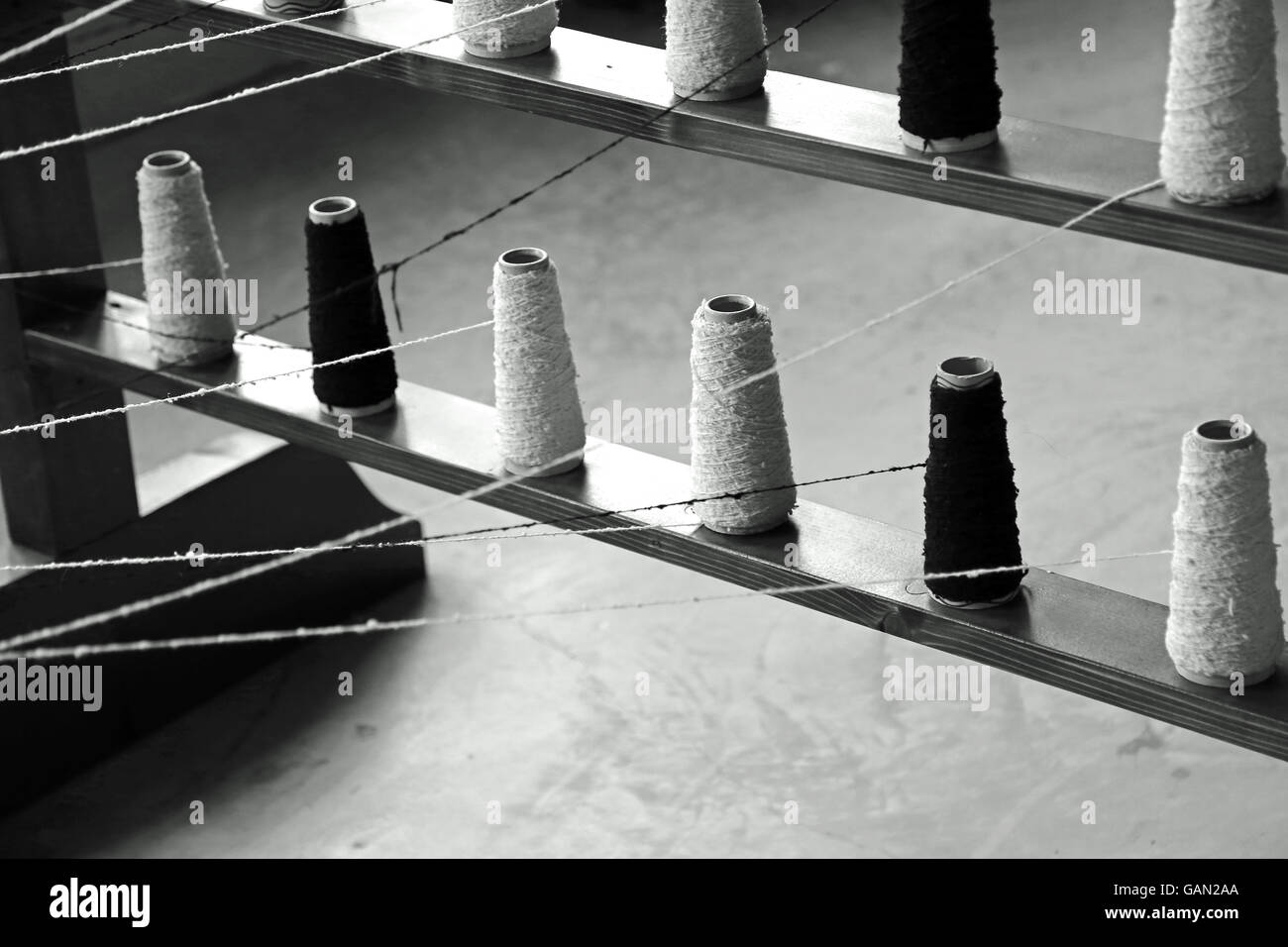 mechanical loom for the production of fabrics with the wire spools for spinning Stock Photohttps://www.alamy.com/image-license-details/?v=1https://www.alamy.com/stock-photo-mechanical-loom-for-the-production-of-fabrics-with-the-wire-spools-109871618.html
mechanical loom for the production of fabrics with the wire spools for spinning Stock Photohttps://www.alamy.com/image-license-details/?v=1https://www.alamy.com/stock-photo-mechanical-loom-for-the-production-of-fabrics-with-the-wire-spools-109871618.htmlRFGAN2AA–mechanical loom for the production of fabrics with the wire spools for spinning
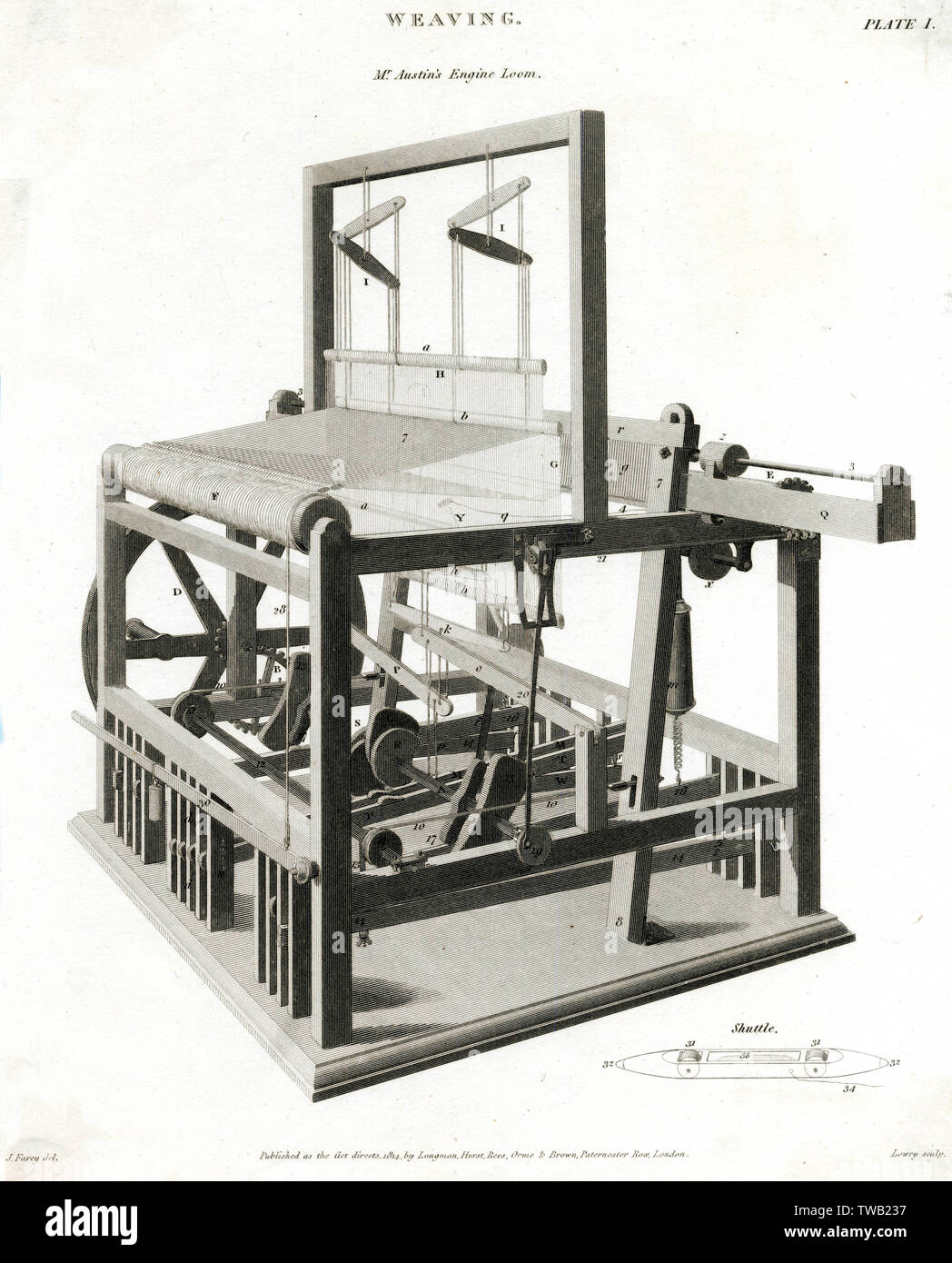 Textile Industry - Weaving - Mr Austin's Engine Loom Stock Photohttps://www.alamy.com/image-license-details/?v=1https://www.alamy.com/textile-industry-weaving-mr-austins-engine-loom-image256554683.html
Textile Industry - Weaving - Mr Austin's Engine Loom Stock Photohttps://www.alamy.com/image-license-details/?v=1https://www.alamy.com/textile-industry-weaving-mr-austins-engine-loom-image256554683.htmlRMTWB237–Textile Industry - Weaving - Mr Austin's Engine Loom
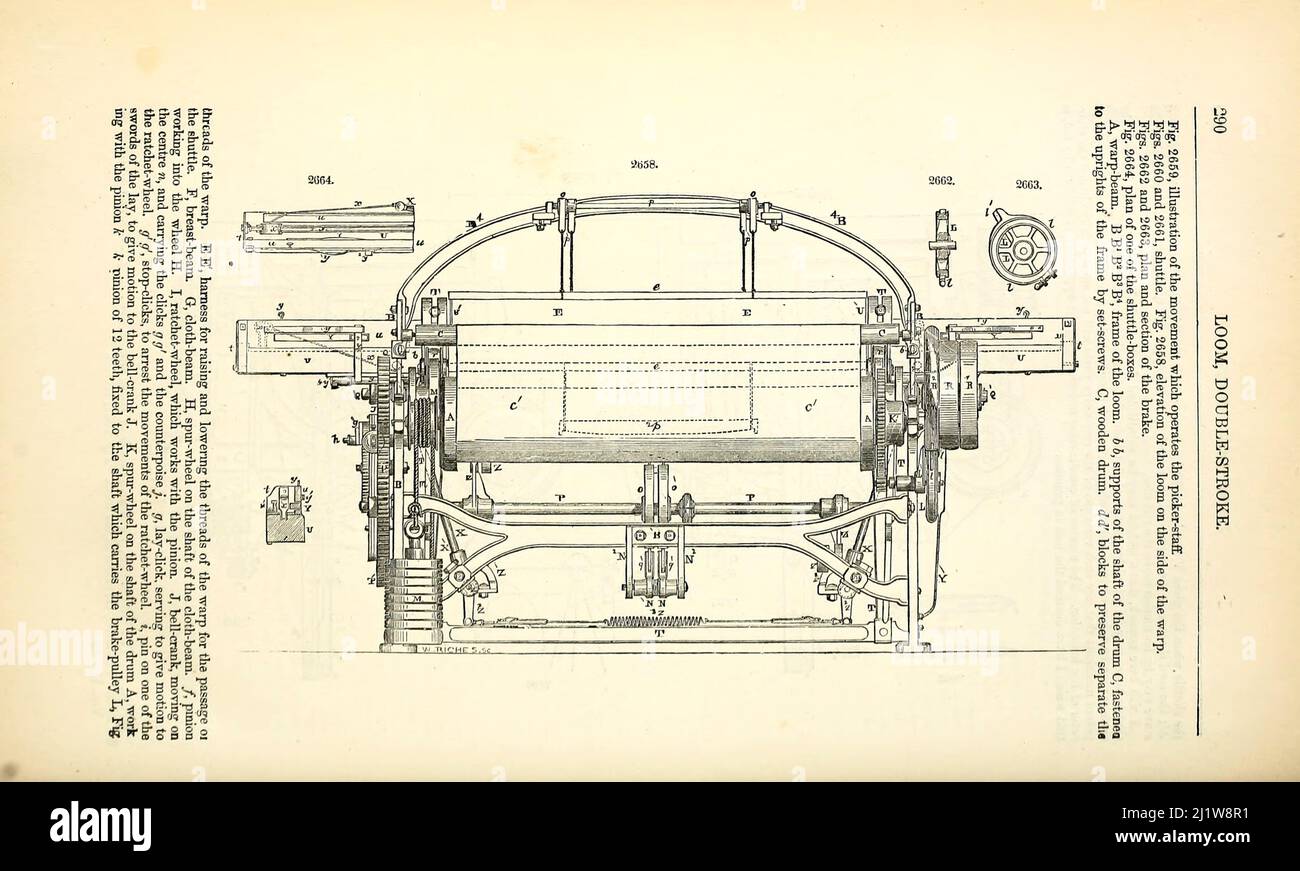 Mechanical Loom from Appleton's dictionary of machines, mechanics, engine-work, and engineering : illustrated with four thousand engravings on wood ; in two volumes by D. Appleton and Company Published New York : D. Appleton and Co 1873 Stock Photohttps://www.alamy.com/image-license-details/?v=1https://www.alamy.com/mechanical-loom-from-appletons-dictionary-of-machines-mechanics-engine-work-and-engineering-illustrated-with-four-thousand-engravings-on-wood-in-two-volumes-by-d-appleton-and-company-published-new-york-d-appleton-and-co-1873-image465850309.html
Mechanical Loom from Appleton's dictionary of machines, mechanics, engine-work, and engineering : illustrated with four thousand engravings on wood ; in two volumes by D. Appleton and Company Published New York : D. Appleton and Co 1873 Stock Photohttps://www.alamy.com/image-license-details/?v=1https://www.alamy.com/mechanical-loom-from-appletons-dictionary-of-machines-mechanics-engine-work-and-engineering-illustrated-with-four-thousand-engravings-on-wood-in-two-volumes-by-d-appleton-and-company-published-new-york-d-appleton-and-co-1873-image465850309.htmlRF2J1W8R1–Mechanical Loom from Appleton's dictionary of machines, mechanics, engine-work, and engineering : illustrated with four thousand engravings on wood ; in two volumes by D. Appleton and Company Published New York : D. Appleton and Co 1873
 mechanical loom in the National Wool Museum, Drefach Felindre, Llandysul, Carmarthenshire, Wales, UK Stock Photohttps://www.alamy.com/image-license-details/?v=1https://www.alamy.com/mechanical-loom-in-the-national-wool-museum-drefach-felindre-llandysul-carmarthenshire-wales-uk-image216624466.html
mechanical loom in the National Wool Museum, Drefach Felindre, Llandysul, Carmarthenshire, Wales, UK Stock Photohttps://www.alamy.com/image-license-details/?v=1https://www.alamy.com/mechanical-loom-in-the-national-wool-museum-drefach-felindre-llandysul-carmarthenshire-wales-uk-image216624466.htmlRFPGC2M2–mechanical loom in the National Wool Museum, Drefach Felindre, Llandysul, Carmarthenshire, Wales, UK
 Jacquard Loom, 19th Century Stock Photohttps://www.alamy.com/image-license-details/?v=1https://www.alamy.com/stock-photo-jacquard-loom-19th-century-135097739.html
Jacquard Loom, 19th Century Stock Photohttps://www.alamy.com/image-license-details/?v=1https://www.alamy.com/stock-photo-jacquard-loom-19th-century-135097739.htmlRMHRP6F7–Jacquard Loom, 19th Century
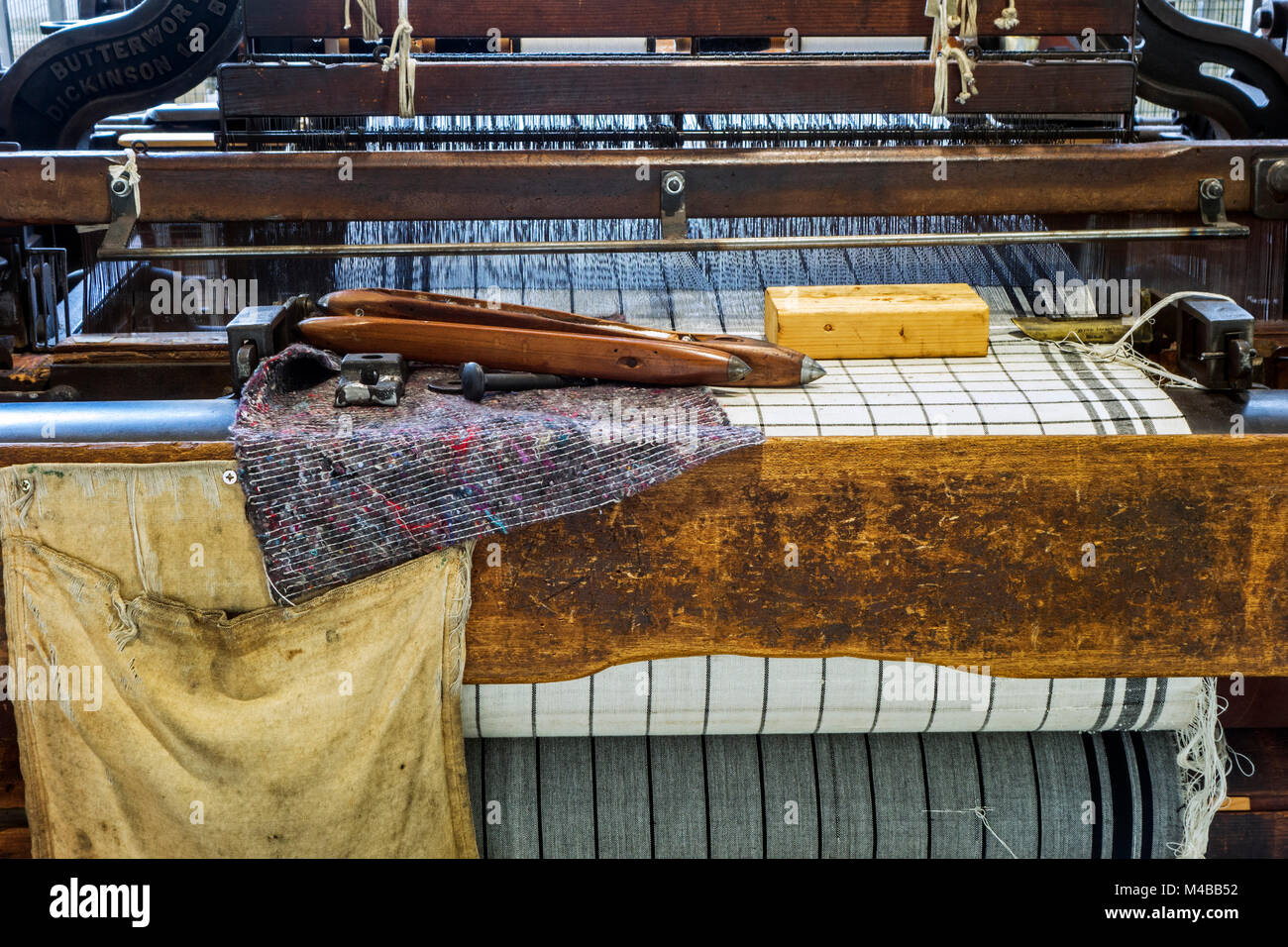 Wooden shuttles on mechanical flying shuttle loom / shuttle weaving machine in cotton mill / spinning-mill Stock Photohttps://www.alamy.com/image-license-details/?v=1https://www.alamy.com/stock-photo-wooden-shuttles-on-mechanical-flying-shuttle-loom-shuttle-weaving-174812542.html
Wooden shuttles on mechanical flying shuttle loom / shuttle weaving machine in cotton mill / spinning-mill Stock Photohttps://www.alamy.com/image-license-details/?v=1https://www.alamy.com/stock-photo-wooden-shuttles-on-mechanical-flying-shuttle-loom-shuttle-weaving-174812542.htmlRMM4BB52–Wooden shuttles on mechanical flying shuttle loom / shuttle weaving machine in cotton mill / spinning-mill
 Colorful Fabric Woven By Vintage Mechanical Loom Stock Photohttps://www.alamy.com/image-license-details/?v=1https://www.alamy.com/colorful-fabric-woven-by-vintage-mechanical-loom-image596269051.html
Colorful Fabric Woven By Vintage Mechanical Loom Stock Photohttps://www.alamy.com/image-license-details/?v=1https://www.alamy.com/colorful-fabric-woven-by-vintage-mechanical-loom-image596269051.htmlRF2WJ2B77–Colorful Fabric Woven By Vintage Mechanical Loom
 India, Jammu & Kashmir, Srinagar, pashmina production, man weaving pasminas on mechanical loom in dark workshop Stock Photohttps://www.alamy.com/image-license-details/?v=1https://www.alamy.com/stock-photo-india-jammu-kashmir-srinagar-pashmina-production-man-weaving-pasminas-86869755.html
India, Jammu & Kashmir, Srinagar, pashmina production, man weaving pasminas on mechanical loom in dark workshop Stock Photohttps://www.alamy.com/image-license-details/?v=1https://www.alamy.com/stock-photo-india-jammu-kashmir-srinagar-pashmina-production-man-weaving-pasminas-86869755.htmlRMF19777–India, Jammu & Kashmir, Srinagar, pashmina production, man weaving pasminas on mechanical loom in dark workshop
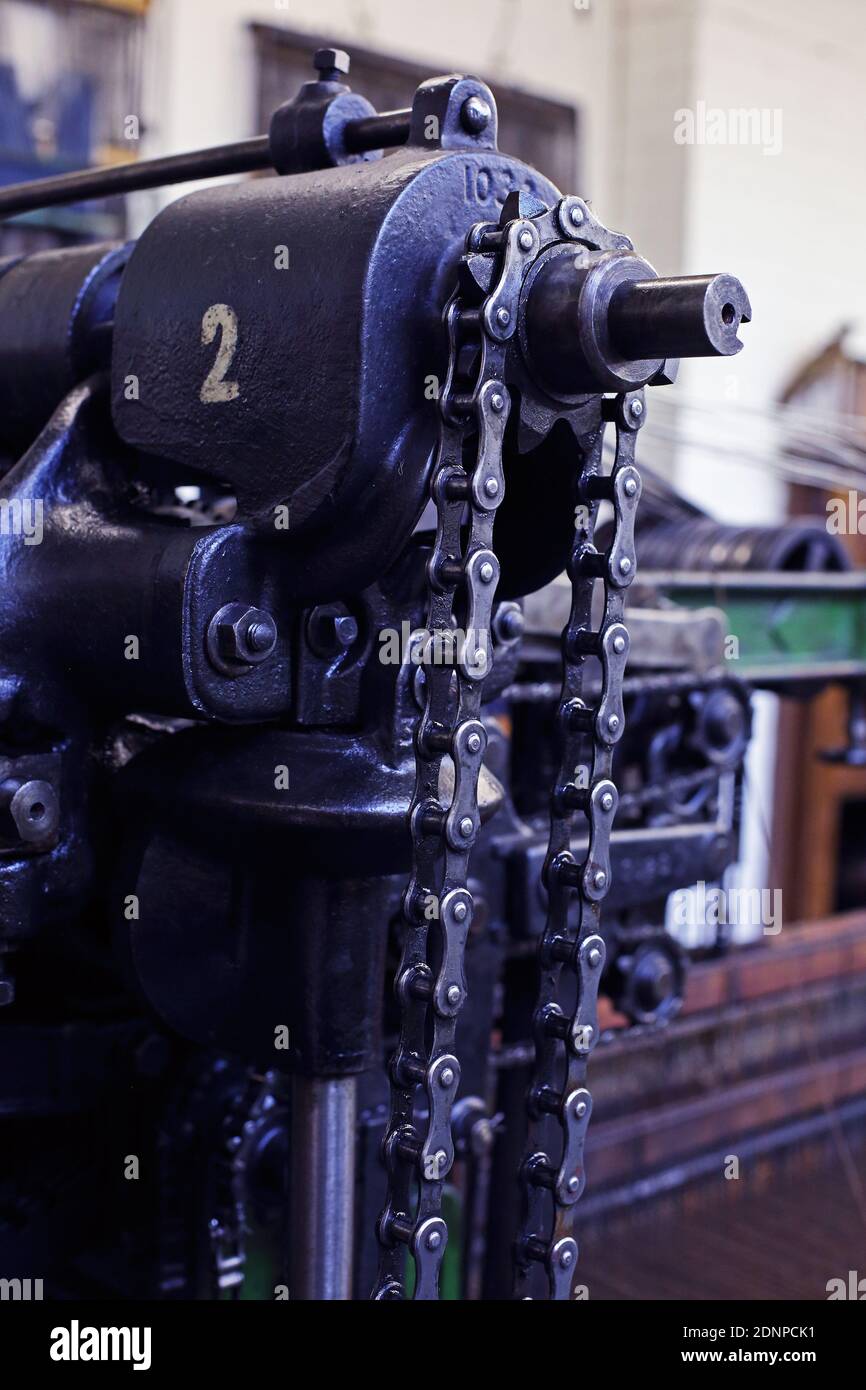 Chain Driven Pulleys On Old Weaving Machine at the micro mill London Cloth Company Stock Photohttps://www.alamy.com/image-license-details/?v=1https://www.alamy.com/chain-driven-pulleys-on-old-weaving-machine-at-the-micro-mill-london-cloth-company-image392028757.html
Chain Driven Pulleys On Old Weaving Machine at the micro mill London Cloth Company Stock Photohttps://www.alamy.com/image-license-details/?v=1https://www.alamy.com/chain-driven-pulleys-on-old-weaving-machine-at-the-micro-mill-london-cloth-company-image392028757.htmlRM2DNPCK1–Chain Driven Pulleys On Old Weaving Machine at the micro mill London Cloth Company
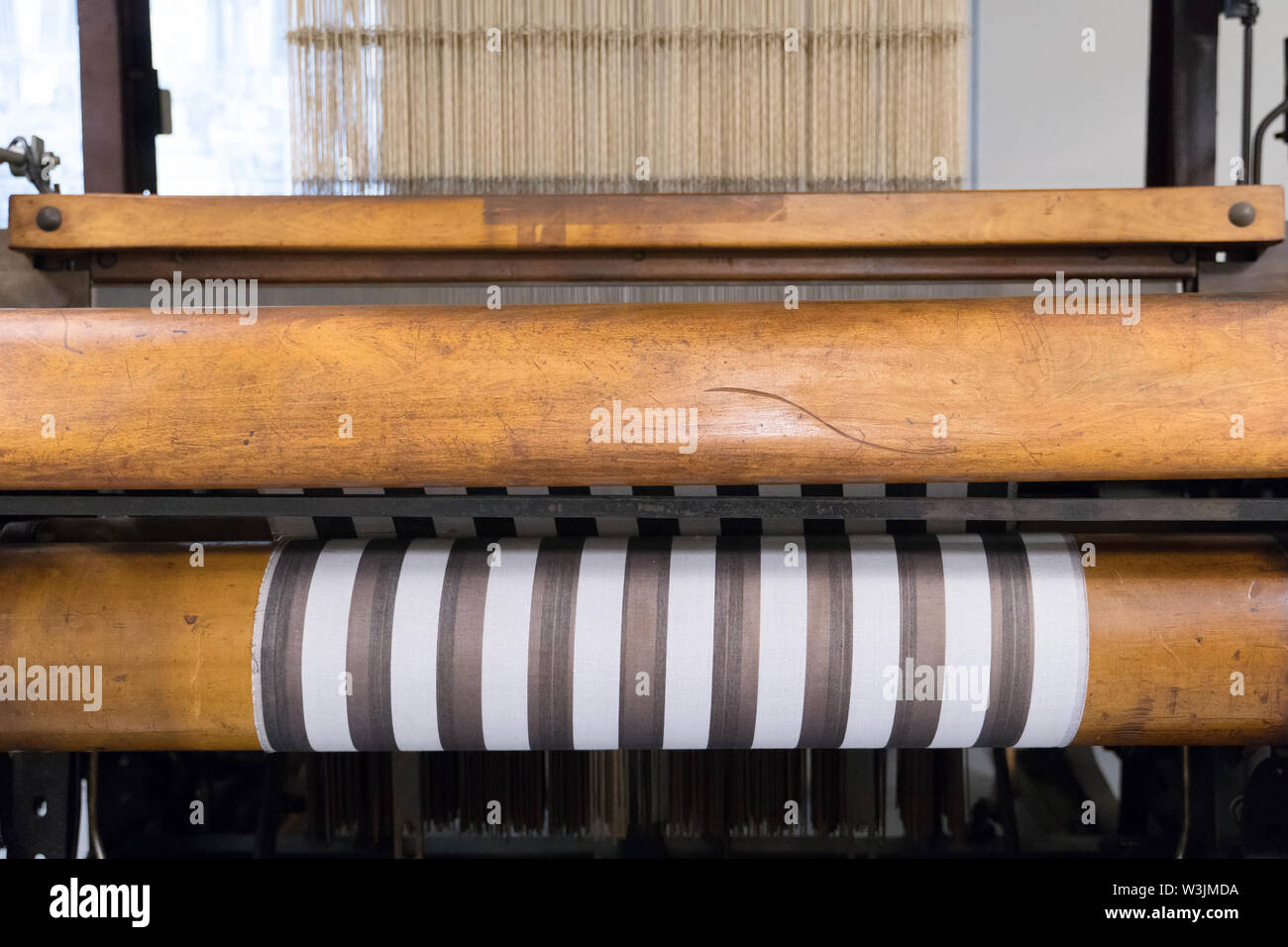 Retro mechanical loom with jacquard harness. Stock Photohttps://www.alamy.com/image-license-details/?v=1https://www.alamy.com/retro-mechanical-loom-with-jacquard-harness-image260410678.html
Retro mechanical loom with jacquard harness. Stock Photohttps://www.alamy.com/image-license-details/?v=1https://www.alamy.com/retro-mechanical-loom-with-jacquard-harness-image260410678.htmlRFW3JMDA–Retro mechanical loom with jacquard harness.
 View of the hands of a weaver arranging cotton threads on a mechanical loom. Stock Photohttps://www.alamy.com/image-license-details/?v=1https://www.alamy.com/view-of-the-hands-of-a-weaver-arranging-cotton-threads-on-a-mechanical-loom-image359517527.html
View of the hands of a weaver arranging cotton threads on a mechanical loom. Stock Photohttps://www.alamy.com/image-license-details/?v=1https://www.alamy.com/view-of-the-hands-of-a-weaver-arranging-cotton-threads-on-a-mechanical-loom-image359517527.htmlRF2BTWC7K–View of the hands of a weaver arranging cotton threads on a mechanical loom.
 France, Pas de Calais, Cote d'Opale (Opal Coast), Calais, City of lace and fashion (2009), preparation of threads for the mechanical loom to weave lace Stock Photohttps://www.alamy.com/image-license-details/?v=1https://www.alamy.com/france-pas-de-calais-cote-dopale-opal-coast-calais-city-of-lace-and-fashion-2009-preparation-of-threads-for-the-mechanical-loom-to-weave-lace-image499492529.html
France, Pas de Calais, Cote d'Opale (Opal Coast), Calais, City of lace and fashion (2009), preparation of threads for the mechanical loom to weave lace Stock Photohttps://www.alamy.com/image-license-details/?v=1https://www.alamy.com/france-pas-de-calais-cote-dopale-opal-coast-calais-city-of-lace-and-fashion-2009-preparation-of-threads-for-the-mechanical-loom-to-weave-lace-image499492529.htmlRM2M0HRPW–France, Pas de Calais, Cote d'Opale (Opal Coast), Calais, City of lace and fashion (2009), preparation of threads for the mechanical loom to weave lace
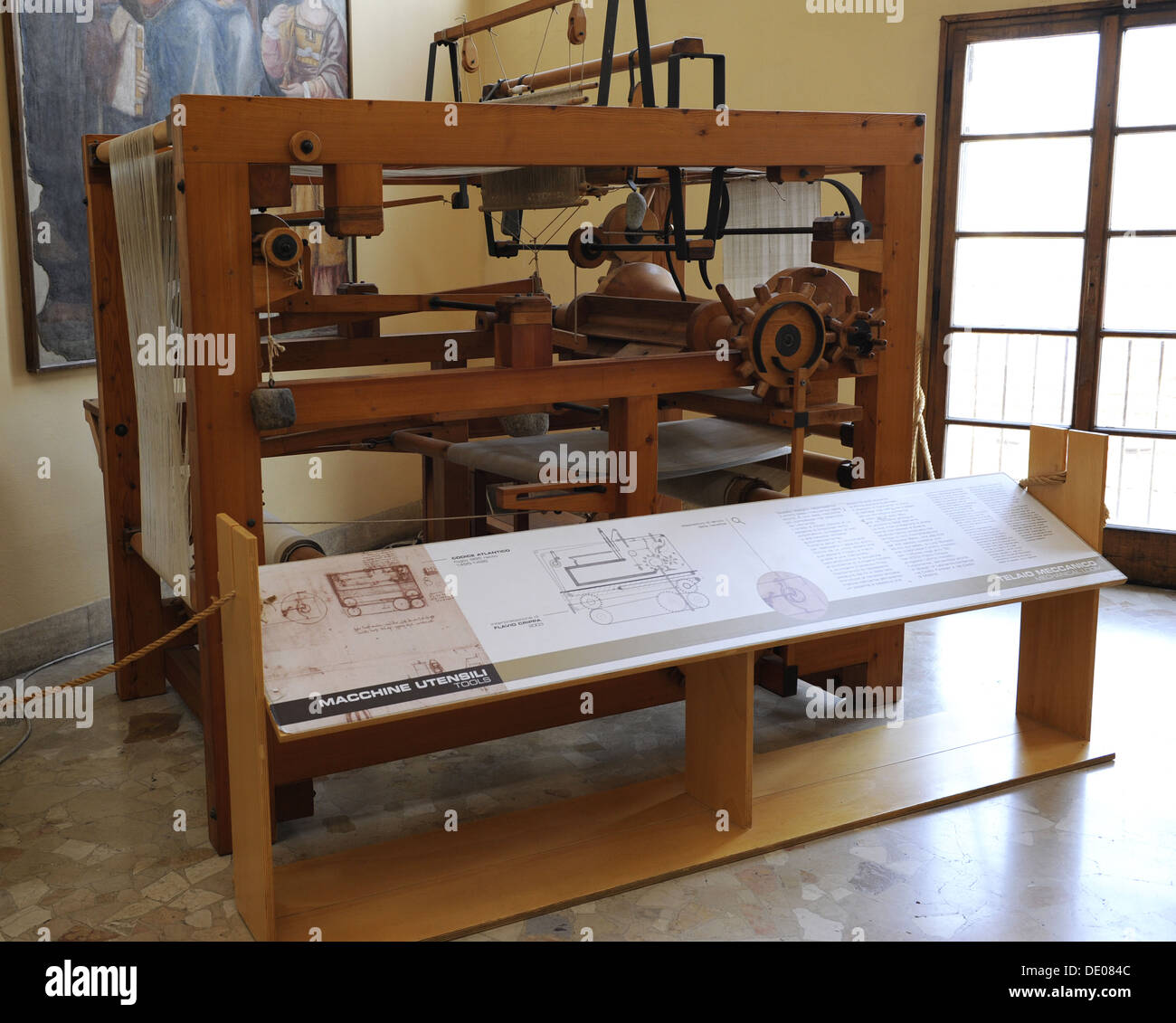 Study of Leonardo da Vinci. Weaving machines. Mechanical loom. 15th century. Model. Stock Photohttps://www.alamy.com/image-license-details/?v=1https://www.alamy.com/study-of-leonardo-da-vinci-weaving-machines-mechanical-loom-15th-century-image60242684.html
Study of Leonardo da Vinci. Weaving machines. Mechanical loom. 15th century. Model. Stock Photohttps://www.alamy.com/image-license-details/?v=1https://www.alamy.com/study-of-leonardo-da-vinci-weaving-machines-mechanical-loom-15th-century-image60242684.htmlRMDE084C–Study of Leonardo da Vinci. Weaving machines. Mechanical loom. 15th century. Model.
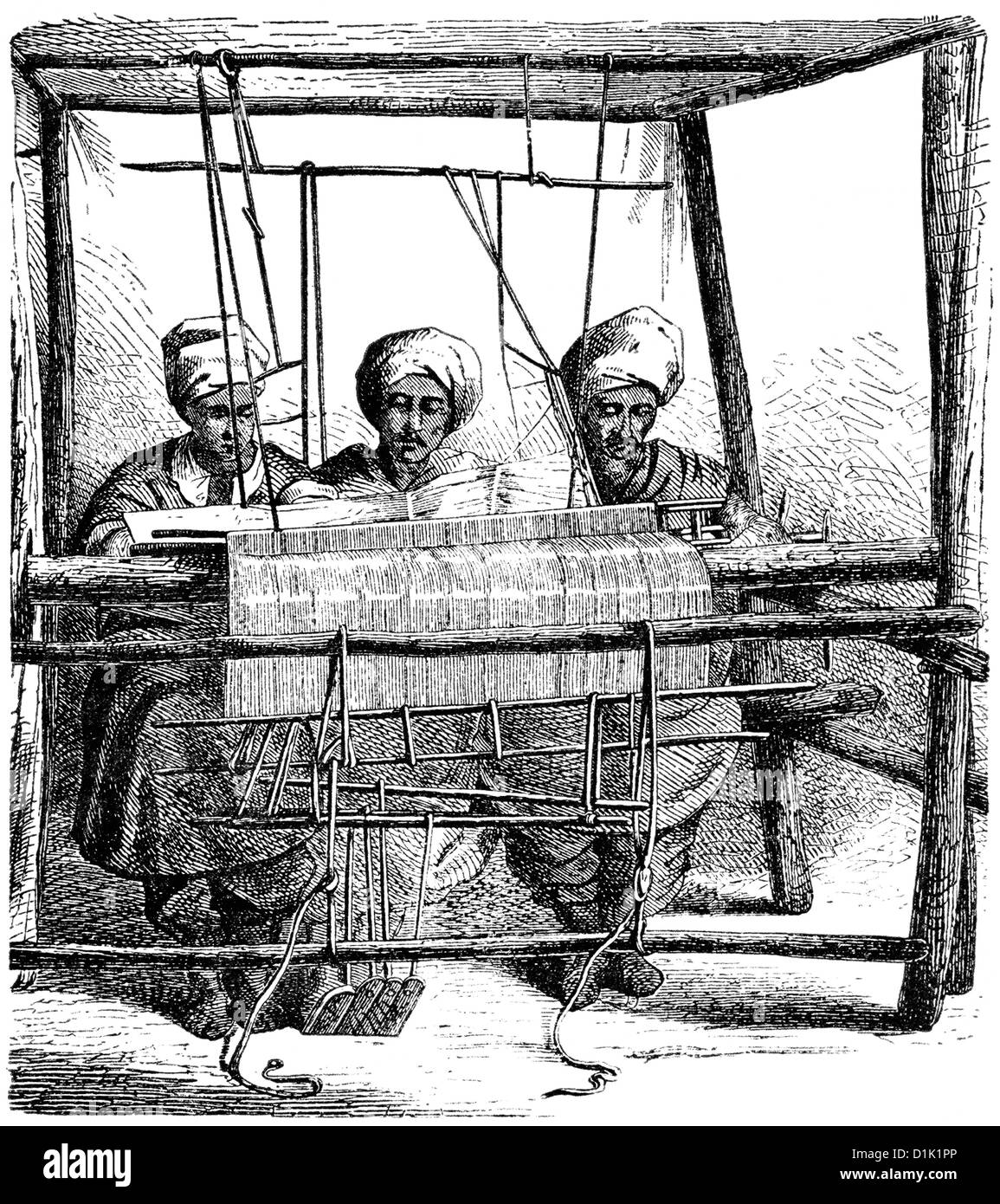 Indian weavers working on a mechanical weaving loom, 18th century Stock Photohttps://www.alamy.com/image-license-details/?v=1https://www.alamy.com/stock-photo-indian-weavers-working-on-a-mechanical-weaving-loom-18th-century-52664270.html
Indian weavers working on a mechanical weaving loom, 18th century Stock Photohttps://www.alamy.com/image-license-details/?v=1https://www.alamy.com/stock-photo-indian-weavers-working-on-a-mechanical-weaving-loom-18th-century-52664270.htmlRMD1K1PP–Indian weavers working on a mechanical weaving loom, 18th century
 Bildnummer: 54035828 Datum: 08.05.2010 Copyright: imago/Xinhua (100509) -- TIANJIN, May 9, 2010 (Xinhua) -- Two visitors watch the obsolete iron-wood mechanical loom housed in the Tianjin Textile Museum, which opens to the public formally, inside the High- and New Technology Textile Industrial Park of the Tianjin Binhai (Sea shore) New District, in Tianjin, north China, May 8, 2010. Covering over 1,800 square meters, the Tianjin Textile Museum displays well over 7,000 pieces of exhibits, including obsolete spinning wheels, relic photos, certificates, clothing and textile raw materials of var Stock Photohttps://www.alamy.com/image-license-details/?v=1https://www.alamy.com/bildnummer-54035828-datum-08052010-copyright-imagoxinhua-100509-tianjin-may-9-2010-xinhua-two-visitors-watch-the-obsolete-iron-wood-mechanical-loom-housed-in-the-tianjin-textile-museum-which-opens-to-the-public-formally-inside-the-high-and-new-technology-textile-industrial-park-of-the-tianjin-binhai-sea-shore-new-district-in-tianjin-north-china-may-8-2010-covering-over-1800-square-meters-the-tianjin-textile-museum-displays-well-over-7000-pieces-of-exhibits-including-obsolete-spinning-wheels-relic-photos-certificates-clothing-and-textile-raw-materials-of-var-image562598669.html
Bildnummer: 54035828 Datum: 08.05.2010 Copyright: imago/Xinhua (100509) -- TIANJIN, May 9, 2010 (Xinhua) -- Two visitors watch the obsolete iron-wood mechanical loom housed in the Tianjin Textile Museum, which opens to the public formally, inside the High- and New Technology Textile Industrial Park of the Tianjin Binhai (Sea shore) New District, in Tianjin, north China, May 8, 2010. Covering over 1,800 square meters, the Tianjin Textile Museum displays well over 7,000 pieces of exhibits, including obsolete spinning wheels, relic photos, certificates, clothing and textile raw materials of var Stock Photohttps://www.alamy.com/image-license-details/?v=1https://www.alamy.com/bildnummer-54035828-datum-08052010-copyright-imagoxinhua-100509-tianjin-may-9-2010-xinhua-two-visitors-watch-the-obsolete-iron-wood-mechanical-loom-housed-in-the-tianjin-textile-museum-which-opens-to-the-public-formally-inside-the-high-and-new-technology-textile-industrial-park-of-the-tianjin-binhai-sea-shore-new-district-in-tianjin-north-china-may-8-2010-covering-over-1800-square-meters-the-tianjin-textile-museum-displays-well-over-7000-pieces-of-exhibits-including-obsolete-spinning-wheels-relic-photos-certificates-clothing-and-textile-raw-materials-of-var-image562598669.htmlRM2RK8G9H–Bildnummer: 54035828 Datum: 08.05.2010 Copyright: imago/Xinhua (100509) -- TIANJIN, May 9, 2010 (Xinhua) -- Two visitors watch the obsolete iron-wood mechanical loom housed in the Tianjin Textile Museum, which opens to the public formally, inside the High- and New Technology Textile Industrial Park of the Tianjin Binhai (Sea shore) New District, in Tianjin, north China, May 8, 2010. Covering over 1,800 square meters, the Tianjin Textile Museum displays well over 7,000 pieces of exhibits, including obsolete spinning wheels, relic photos, certificates, clothing and textile raw materials of var
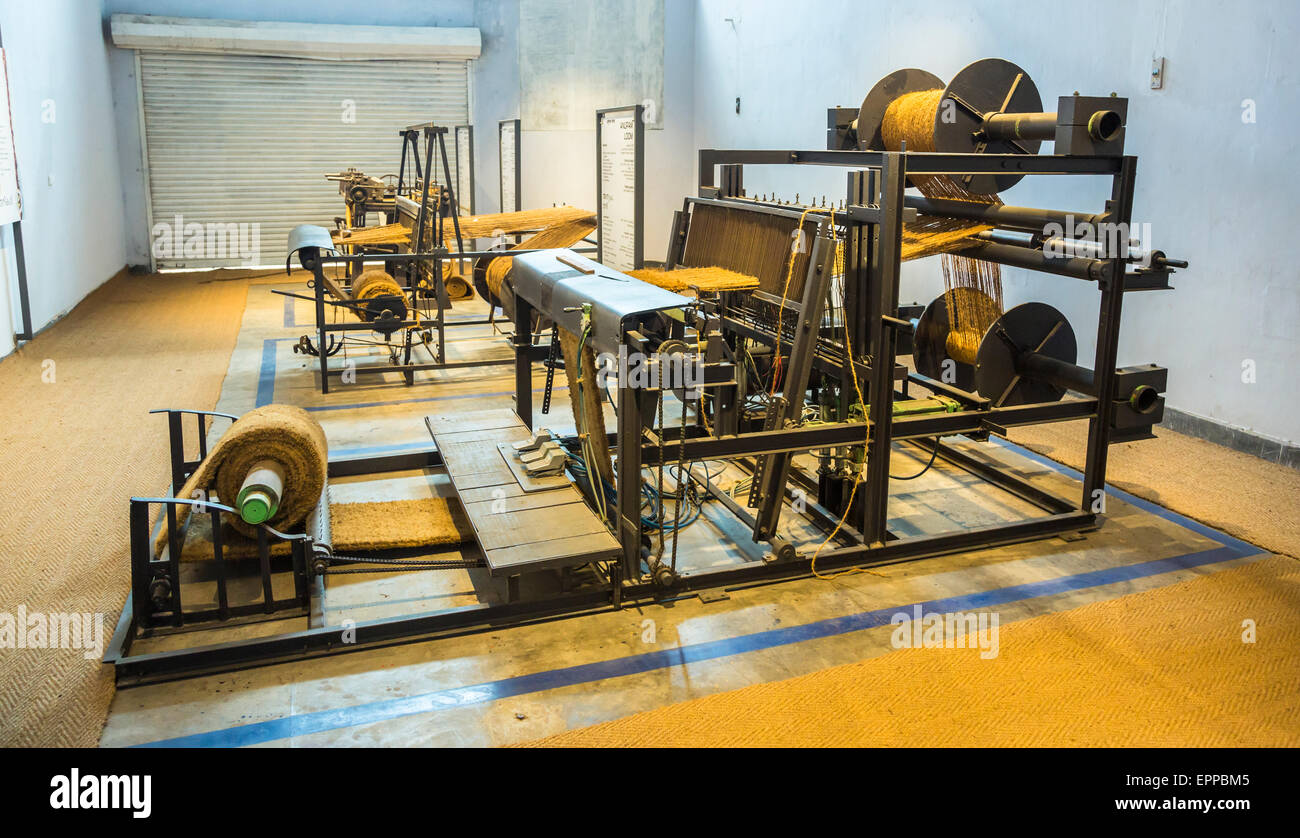 Vintage weaving loom machines exhibited at the Coir Museum, Cochin, Kerala, southern India Stock Photohttps://www.alamy.com/image-license-details/?v=1https://www.alamy.com/stock-photo-vintage-weaving-loom-machines-exhibited-at-the-coir-museum-cochin-82856037.html
Vintage weaving loom machines exhibited at the Coir Museum, Cochin, Kerala, southern India Stock Photohttps://www.alamy.com/image-license-details/?v=1https://www.alamy.com/stock-photo-vintage-weaving-loom-machines-exhibited-at-the-coir-museum-cochin-82856037.htmlRMEPPBM5–Vintage weaving loom machines exhibited at the Coir Museum, Cochin, Kerala, southern India
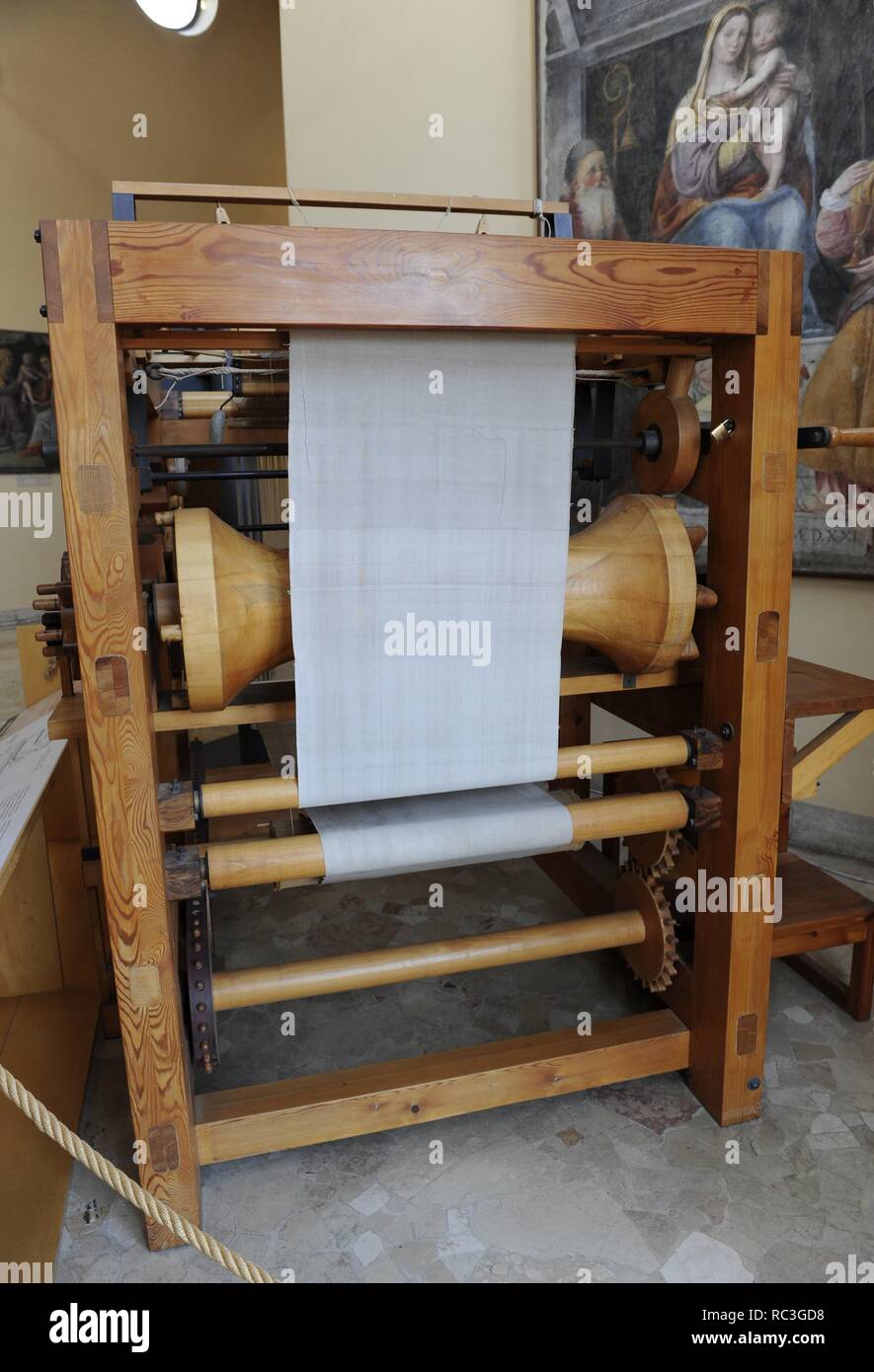 Renaissance. Study of Leonardo da Vinci. Weaving machines. Mechanical loom. 15th century. Model. The Science and Technology Museum Leonardo da Vinci. Milan. Italy.. Italy. Stock Photohttps://www.alamy.com/image-license-details/?v=1https://www.alamy.com/renaissance-study-of-leonardo-da-vinci-weaving-machines-mechanical-loom-15th-century-model-the-science-and-technology-museum-leonardo-da-vinci-milan-italy-italy-image231189428.html
Renaissance. Study of Leonardo da Vinci. Weaving machines. Mechanical loom. 15th century. Model. The Science and Technology Museum Leonardo da Vinci. Milan. Italy.. Italy. Stock Photohttps://www.alamy.com/image-license-details/?v=1https://www.alamy.com/renaissance-study-of-leonardo-da-vinci-weaving-machines-mechanical-loom-15th-century-model-the-science-and-technology-museum-leonardo-da-vinci-milan-italy-italy-image231189428.htmlRMRC3GD8–Renaissance. Study of Leonardo da Vinci. Weaving machines. Mechanical loom. 15th century. Model. The Science and Technology Museum Leonardo da Vinci. Milan. Italy.. Italy.
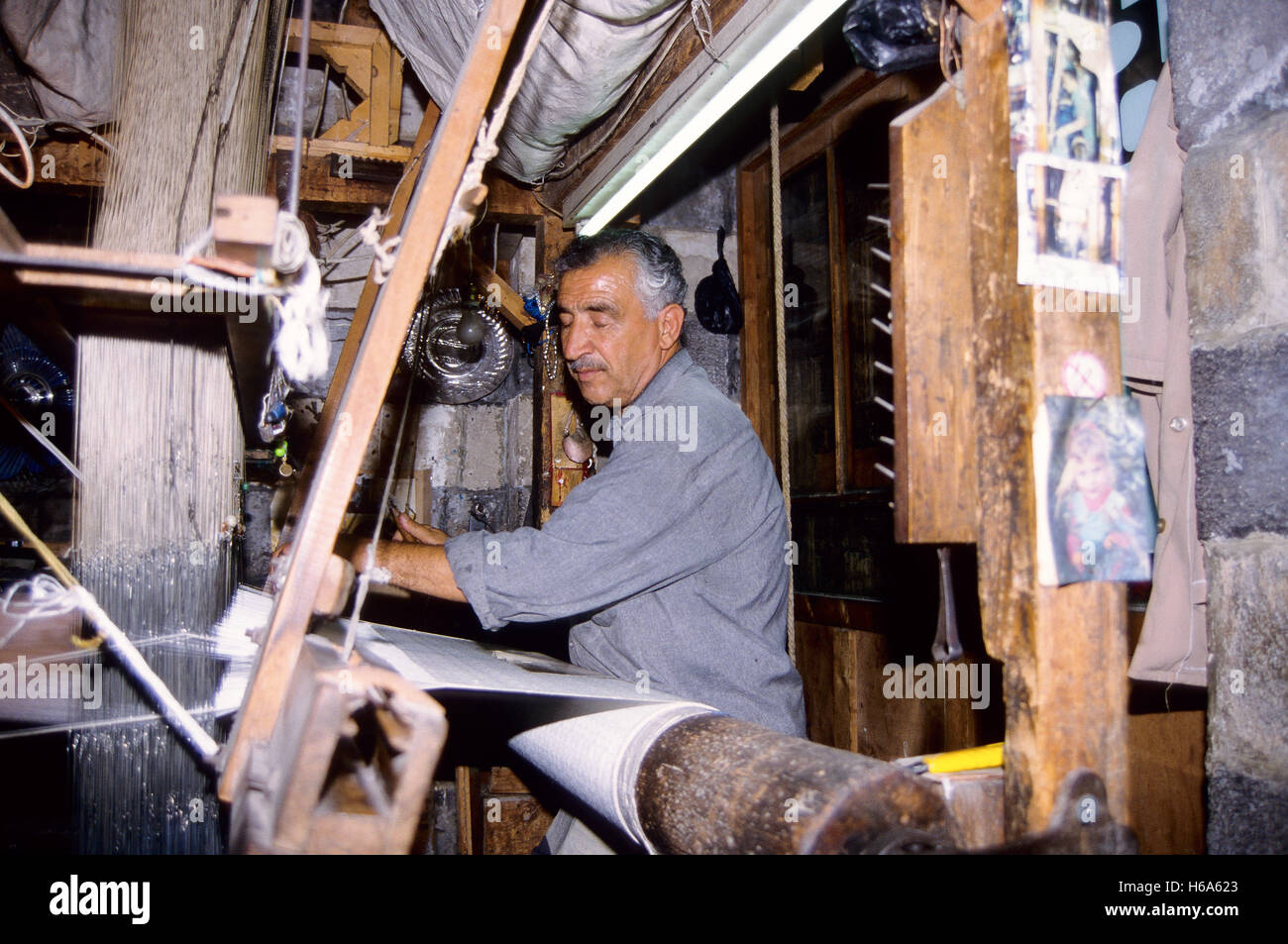 Abu Sayyah, one of the last brocade weavers in the Syrian capital. Taken on 12.08.1995. Every day Abu Sayyah stands behind his mechanical loom and with great concentration manages to weave around a metre of brocade fabric. Photo: Matthias Tödt | usage worldwide Stock Photohttps://www.alamy.com/image-license-details/?v=1https://www.alamy.com/stock-photo-abu-sayyah-one-of-the-last-brocade-weavers-in-the-syrian-capital-taken-124384795.html
Abu Sayyah, one of the last brocade weavers in the Syrian capital. Taken on 12.08.1995. Every day Abu Sayyah stands behind his mechanical loom and with great concentration manages to weave around a metre of brocade fabric. Photo: Matthias Tödt | usage worldwide Stock Photohttps://www.alamy.com/image-license-details/?v=1https://www.alamy.com/stock-photo-abu-sayyah-one-of-the-last-brocade-weavers-in-the-syrian-capital-taken-124384795.htmlRMH6A623–Abu Sayyah, one of the last brocade weavers in the Syrian capital. Taken on 12.08.1995. Every day Abu Sayyah stands behind his mechanical loom and with great concentration manages to weave around a metre of brocade fabric. Photo: Matthias Tödt | usage worldwide
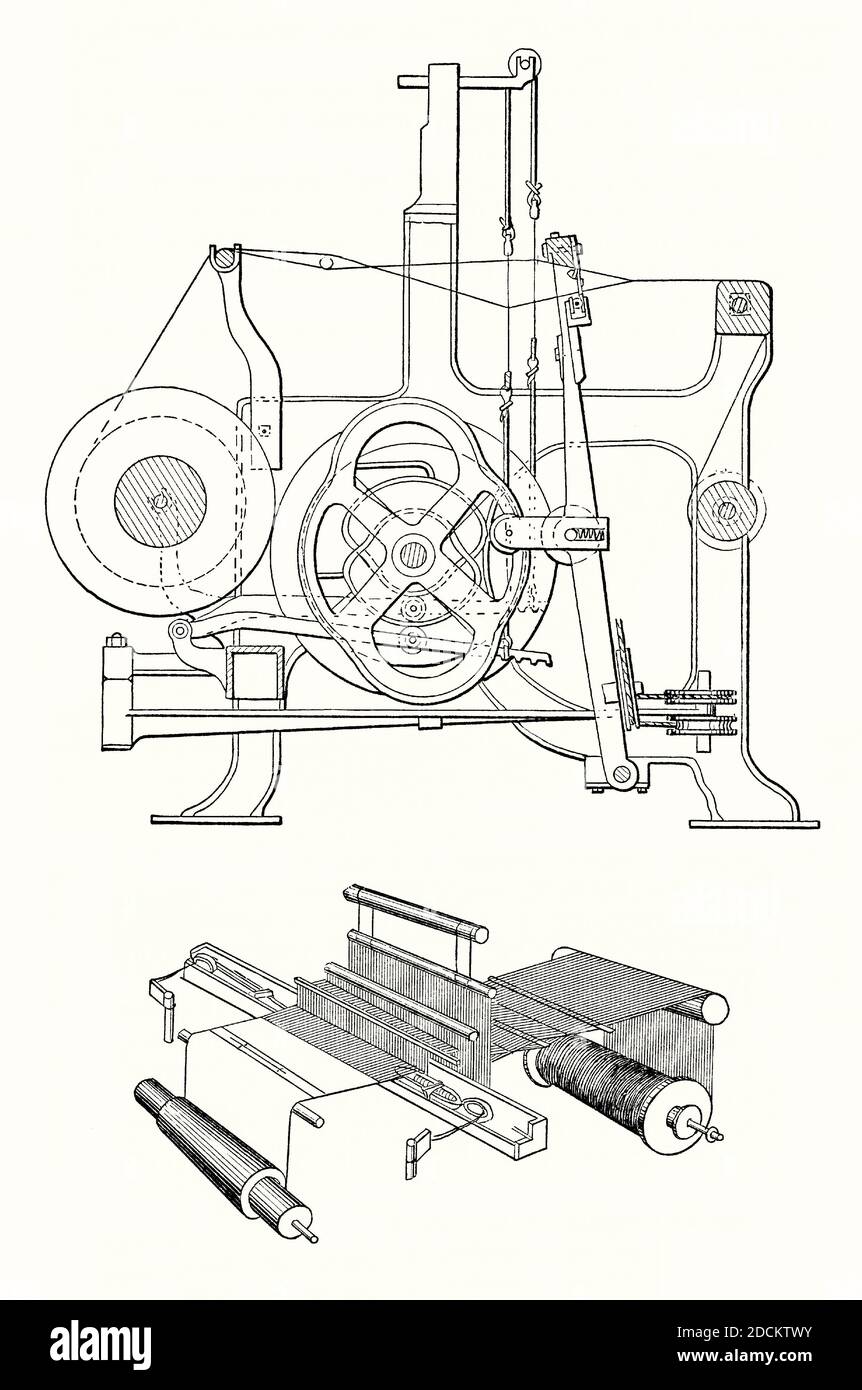 An old engraving of two views of the workings of a power loom. It is from a Victorian mechanical engineering book of the 1880s. A loom is a device used to weave cloth. The basic purpose of any loom is to hold the warp threads under tension to facilitate the interweaving of the weft threads. Englishman Edmund Cartwright built and patented a power loom in 1785, and it was this that was adopted by cotton industry. Water and/or steam provided the power needed to run the looms, usually by belt drives to the individual looms. The loom shape and its mechanics varied enormously Stock Photohttps://www.alamy.com/image-license-details/?v=1https://www.alamy.com/an-old-engraving-of-two-views-of-the-workings-of-a-power-loom-it-is-from-a-victorian-mechanical-engineering-book-of-the-1880s-a-loom-is-a-device-used-to-weave-cloth-the-basic-purpose-of-any-loom-is-to-hold-the-warp-threads-under-tension-to-facilitate-the-interweaving-of-the-weft-threads-englishman-edmund-cartwright-built-and-patented-a-power-loom-in-1785-and-it-was-this-that-was-adopted-by-cotton-industry-water-andor-steam-provided-the-power-needed-to-run-the-looms-usually-by-belt-drives-to-the-individual-looms-the-loom-shape-and-its-mechanics-varied-enormously-image386440599.html
An old engraving of two views of the workings of a power loom. It is from a Victorian mechanical engineering book of the 1880s. A loom is a device used to weave cloth. The basic purpose of any loom is to hold the warp threads under tension to facilitate the interweaving of the weft threads. Englishman Edmund Cartwright built and patented a power loom in 1785, and it was this that was adopted by cotton industry. Water and/or steam provided the power needed to run the looms, usually by belt drives to the individual looms. The loom shape and its mechanics varied enormously Stock Photohttps://www.alamy.com/image-license-details/?v=1https://www.alamy.com/an-old-engraving-of-two-views-of-the-workings-of-a-power-loom-it-is-from-a-victorian-mechanical-engineering-book-of-the-1880s-a-loom-is-a-device-used-to-weave-cloth-the-basic-purpose-of-any-loom-is-to-hold-the-warp-threads-under-tension-to-facilitate-the-interweaving-of-the-weft-threads-englishman-edmund-cartwright-built-and-patented-a-power-loom-in-1785-and-it-was-this-that-was-adopted-by-cotton-industry-water-andor-steam-provided-the-power-needed-to-run-the-looms-usually-by-belt-drives-to-the-individual-looms-the-loom-shape-and-its-mechanics-varied-enormously-image386440599.htmlRM2DCKTWY–An old engraving of two views of the workings of a power loom. It is from a Victorian mechanical engineering book of the 1880s. A loom is a device used to weave cloth. The basic purpose of any loom is to hold the warp threads under tension to facilitate the interweaving of the weft threads. Englishman Edmund Cartwright built and patented a power loom in 1785, and it was this that was adopted by cotton industry. Water and/or steam provided the power needed to run the looms, usually by belt drives to the individual looms. The loom shape and its mechanics varied enormously
 mechanical loom for the production of fabrics with the three wire splolette for spinning Stock Photohttps://www.alamy.com/image-license-details/?v=1https://www.alamy.com/stock-photo-mechanical-loom-for-the-production-of-fabrics-with-the-three-wire-109871625.html
mechanical loom for the production of fabrics with the three wire splolette for spinning Stock Photohttps://www.alamy.com/image-license-details/?v=1https://www.alamy.com/stock-photo-mechanical-loom-for-the-production-of-fabrics-with-the-three-wire-109871625.htmlRFGAN2AH–mechanical loom for the production of fabrics with the three wire splolette for spinning
 Duesseldorf, Germany. 26th Aug, 2021. A mechanical loom from the textile industry is on display in the exhibition. The anniversary exhibition 'OUR COUNTRY. 75 Years of North Rhine-Westphalia' from 27 August 2021 to 23 MAi 2022 highlights the history of North Rhine-Westphalia. Credit: Federico Gambarini/dpa/Alamy Live News Stock Photohttps://www.alamy.com/image-license-details/?v=1https://www.alamy.com/duesseldorf-germany-26th-aug-2021-a-mechanical-loom-from-the-textile-industry-is-on-display-in-the-exhibition-the-anniversary-exhibition-our-country-75-years-of-north-rhine-westphalia-from-27-august-2021-to-23-mai-2022-highlights-the-history-of-north-rhine-westphalia-credit-federico-gambarinidpaalamy-live-news-image439889305.html
Duesseldorf, Germany. 26th Aug, 2021. A mechanical loom from the textile industry is on display in the exhibition. The anniversary exhibition 'OUR COUNTRY. 75 Years of North Rhine-Westphalia' from 27 August 2021 to 23 MAi 2022 highlights the history of North Rhine-Westphalia. Credit: Federico Gambarini/dpa/Alamy Live News Stock Photohttps://www.alamy.com/image-license-details/?v=1https://www.alamy.com/duesseldorf-germany-26th-aug-2021-a-mechanical-loom-from-the-textile-industry-is-on-display-in-the-exhibition-the-anniversary-exhibition-our-country-75-years-of-north-rhine-westphalia-from-27-august-2021-to-23-mai-2022-highlights-the-history-of-north-rhine-westphalia-credit-federico-gambarinidpaalamy-live-news-image439889305.htmlRM2GFJK89–Duesseldorf, Germany. 26th Aug, 2021. A mechanical loom from the textile industry is on display in the exhibition. The anniversary exhibition 'OUR COUNTRY. 75 Years of North Rhine-Westphalia' from 27 August 2021 to 23 MAi 2022 highlights the history of North Rhine-Westphalia. Credit: Federico Gambarini/dpa/Alamy Live News
 An old engraving of a warping mill (left), a winding machine (centre) and a power loom (right) used in producing cotton in the 1800s. It is from a Victorian mechanical engineering book of the 1880s. A loom is a device used to weave cloth. The basic purpose of any loom is to hold the warp threads under tension to facilitate the interweaving of the weft threads. Englishman Edmund Cartwright built and patented a power loom in 1785, and it was this that was adopted by cotton industry. Water and/or steam provided the power needed to run the looms, usually by belt drives to the individual looms. Stock Photohttps://www.alamy.com/image-license-details/?v=1https://www.alamy.com/an-old-engraving-of-a-warping-mill-left-a-winding-machine-centre-and-a-power-loom-right-used-in-producing-cotton-in-the-1800s-it-is-from-a-victorian-mechanical-engineering-book-of-the-1880s-a-loom-is-a-device-used-to-weave-cloth-the-basic-purpose-of-any-loom-is-to-hold-the-warp-threads-under-tension-to-facilitate-the-interweaving-of-the-weft-threads-englishman-edmund-cartwright-built-and-patented-a-power-loom-in-1785-and-it-was-this-that-was-adopted-by-cotton-industry-water-andor-steam-provided-the-power-needed-to-run-the-looms-usually-by-belt-drives-to-the-individual-looms-image559321655.html
An old engraving of a warping mill (left), a winding machine (centre) and a power loom (right) used in producing cotton in the 1800s. It is from a Victorian mechanical engineering book of the 1880s. A loom is a device used to weave cloth. The basic purpose of any loom is to hold the warp threads under tension to facilitate the interweaving of the weft threads. Englishman Edmund Cartwright built and patented a power loom in 1785, and it was this that was adopted by cotton industry. Water and/or steam provided the power needed to run the looms, usually by belt drives to the individual looms. Stock Photohttps://www.alamy.com/image-license-details/?v=1https://www.alamy.com/an-old-engraving-of-a-warping-mill-left-a-winding-machine-centre-and-a-power-loom-right-used-in-producing-cotton-in-the-1800s-it-is-from-a-victorian-mechanical-engineering-book-of-the-1880s-a-loom-is-a-device-used-to-weave-cloth-the-basic-purpose-of-any-loom-is-to-hold-the-warp-threads-under-tension-to-facilitate-the-interweaving-of-the-weft-threads-englishman-edmund-cartwright-built-and-patented-a-power-loom-in-1785-and-it-was-this-that-was-adopted-by-cotton-industry-water-andor-steam-provided-the-power-needed-to-run-the-looms-usually-by-belt-drives-to-the-individual-looms-image559321655.htmlRM2RDY8DB–An old engraving of a warping mill (left), a winding machine (centre) and a power loom (right) used in producing cotton in the 1800s. It is from a Victorian mechanical engineering book of the 1880s. A loom is a device used to weave cloth. The basic purpose of any loom is to hold the warp threads under tension to facilitate the interweaving of the weft threads. Englishman Edmund Cartwright built and patented a power loom in 1785, and it was this that was adopted by cotton industry. Water and/or steam provided the power needed to run the looms, usually by belt drives to the individual looms.
 mechanical loom in the National Wool Museum, Drefach Felindre, Llandysul, Carmarthenshire, Wales, UK Stock Photohttps://www.alamy.com/image-license-details/?v=1https://www.alamy.com/mechanical-loom-in-the-national-wool-museum-drefach-felindre-llandysul-carmarthenshire-wales-uk-image216624463.html
mechanical loom in the National Wool Museum, Drefach Felindre, Llandysul, Carmarthenshire, Wales, UK Stock Photohttps://www.alamy.com/image-license-details/?v=1https://www.alamy.com/mechanical-loom-in-the-national-wool-museum-drefach-felindre-llandysul-carmarthenshire-wales-uk-image216624463.htmlRFPGC2KY–mechanical loom in the National Wool Museum, Drefach Felindre, Llandysul, Carmarthenshire, Wales, UK
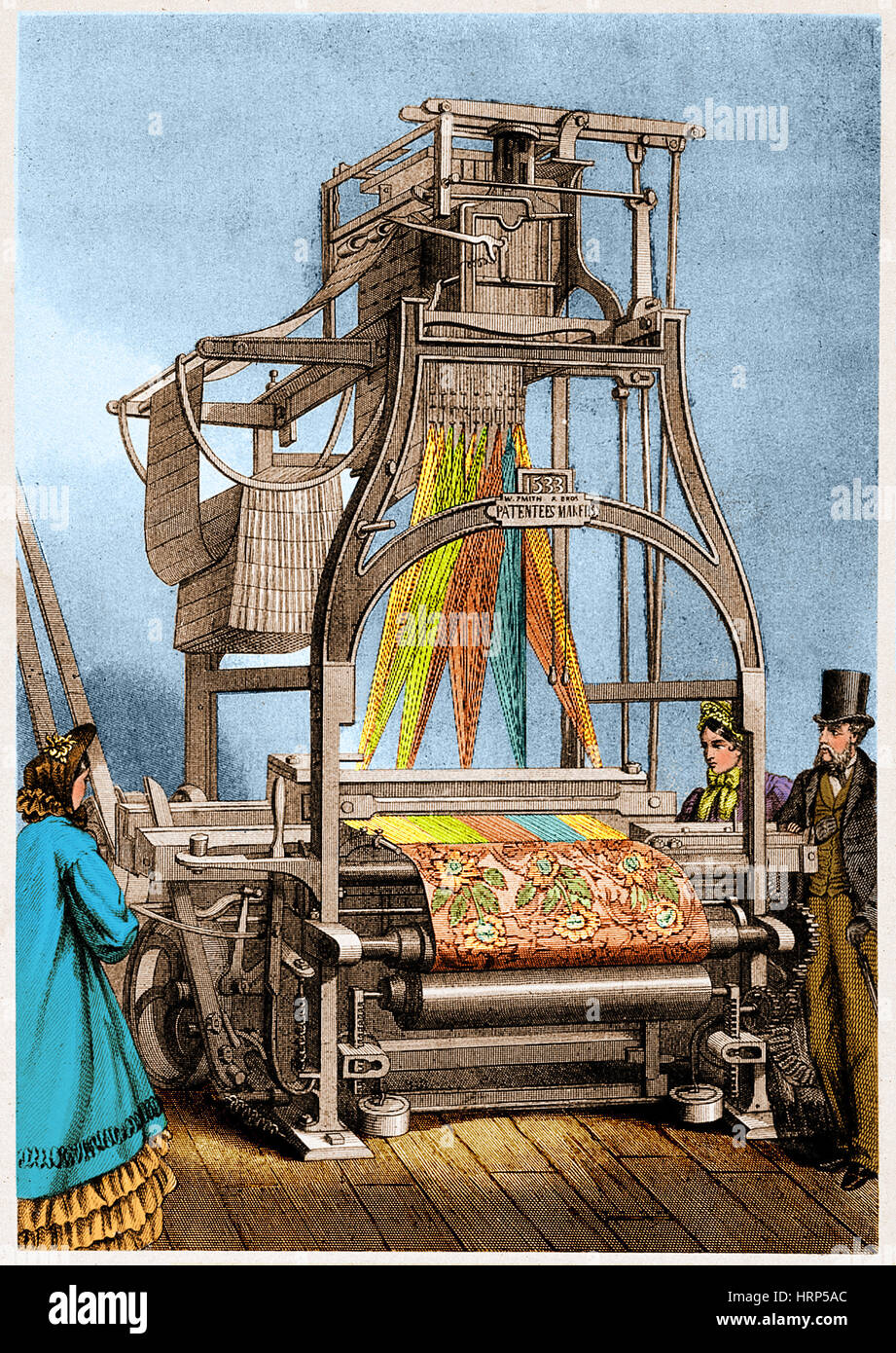 Jacquard Loom for Weaving Textiles Stock Photohttps://www.alamy.com/image-license-details/?v=1https://www.alamy.com/stock-photo-jacquard-loom-for-weaving-textiles-135096820.html
Jacquard Loom for Weaving Textiles Stock Photohttps://www.alamy.com/image-license-details/?v=1https://www.alamy.com/stock-photo-jacquard-loom-for-weaving-textiles-135096820.htmlRMHRP5AC–Jacquard Loom for Weaving Textiles
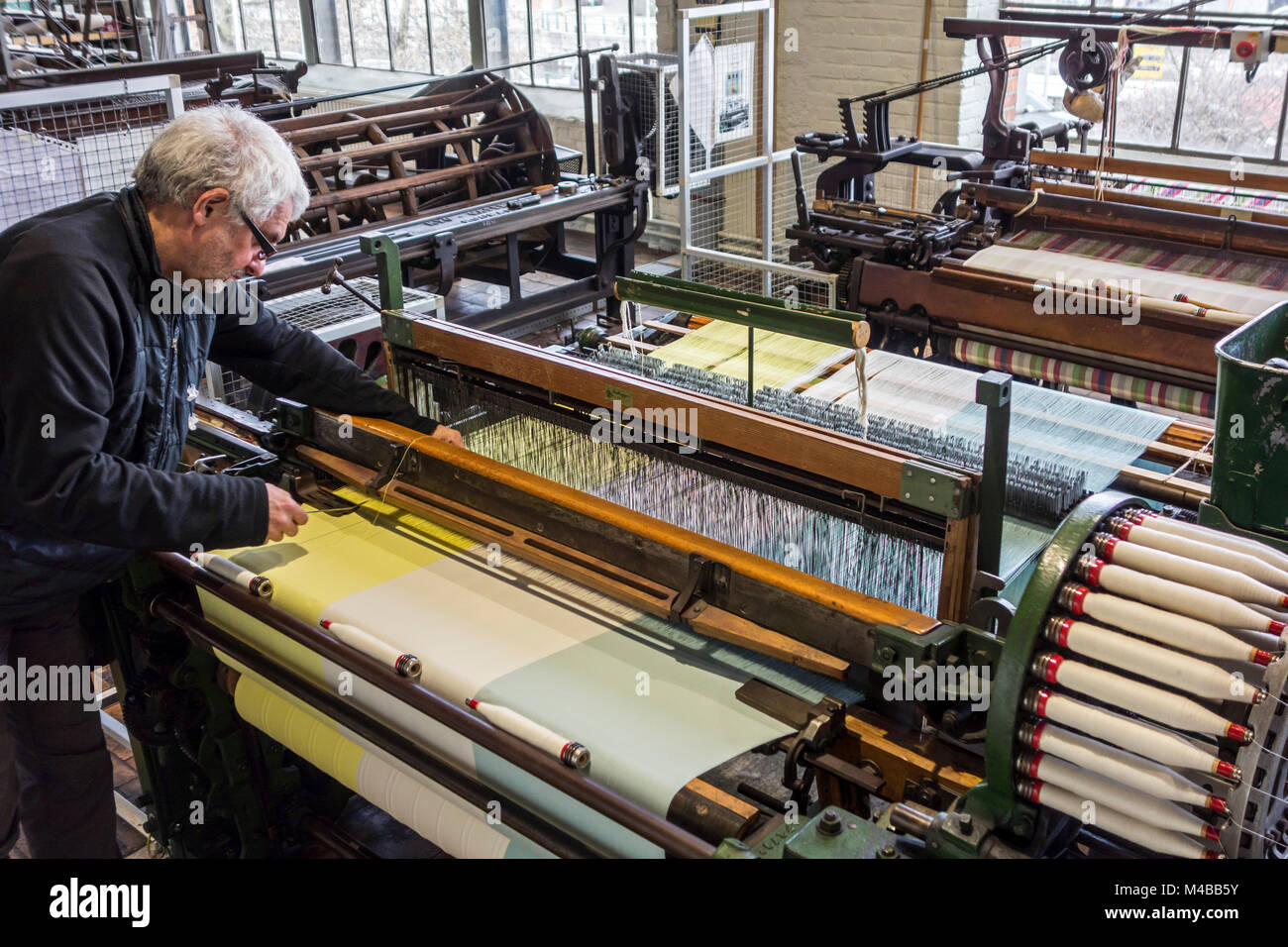 Fabric weaver operating mechanical flying shuttle loom / shuttle weaving machine in cotton mill / spinning-mill Stock Photohttps://www.alamy.com/image-license-details/?v=1https://www.alamy.com/stock-photo-fabric-weaver-operating-mechanical-flying-shuttle-loom-shuttle-weaving-174812567.html
Fabric weaver operating mechanical flying shuttle loom / shuttle weaving machine in cotton mill / spinning-mill Stock Photohttps://www.alamy.com/image-license-details/?v=1https://www.alamy.com/stock-photo-fabric-weaver-operating-mechanical-flying-shuttle-loom-shuttle-weaving-174812567.htmlRMM4BB5Y–Fabric weaver operating mechanical flying shuttle loom / shuttle weaving machine in cotton mill / spinning-mill
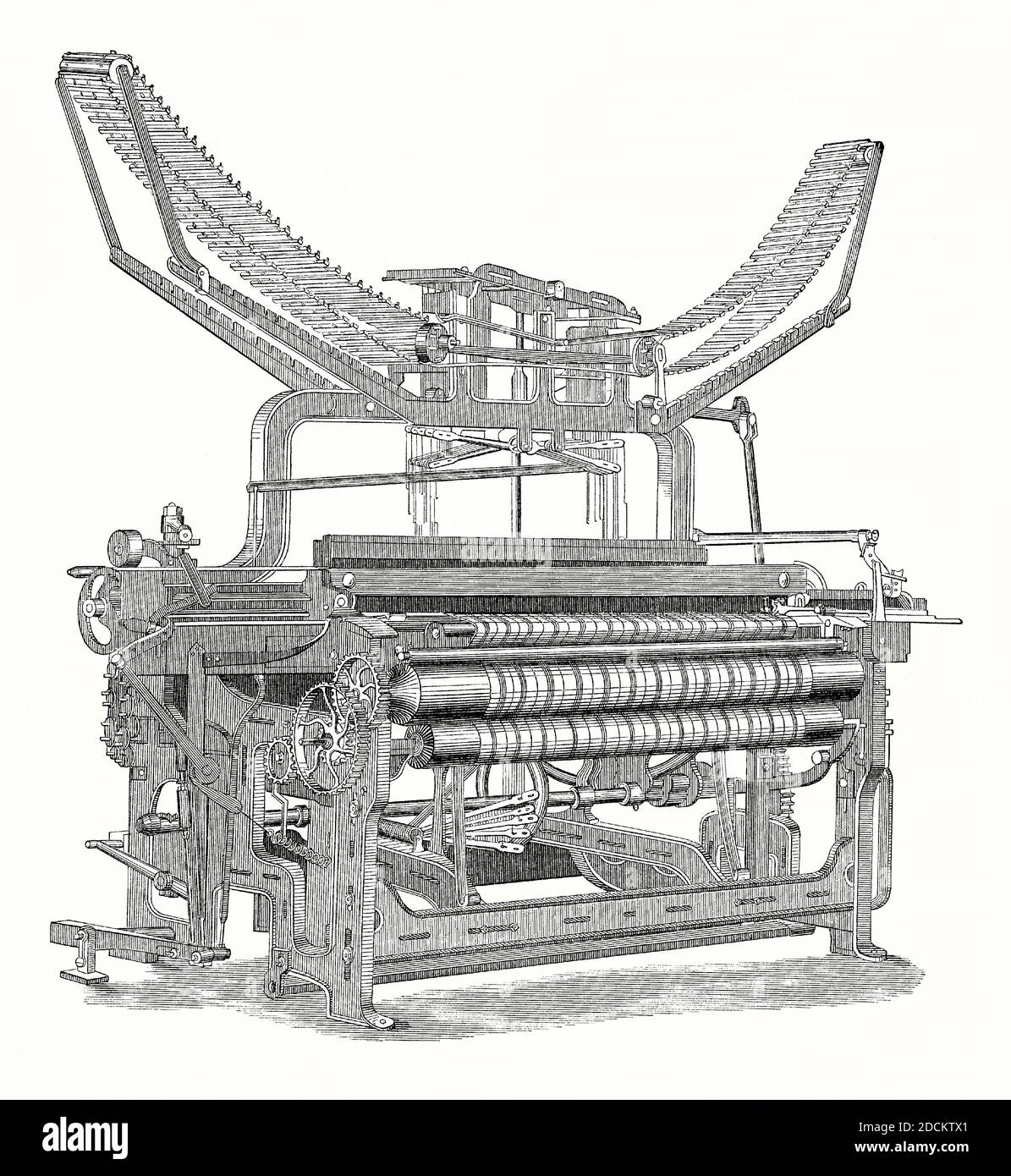 An old engraving of a figure loom, using a ‘dobby’ in the manufacture of patterned cloth in the 1800s. It is from a Victorian mechanical engineering book of the 1880s. Dobby (or dobbie) is a woven fabric produced on the dobby loom. The fabric produced is characterised by small geometric patterns and extra texture in the cloth. The warp and weft threads may of different colours. A harness-controlling mechanism is located at the centre of the loom. This connects to pattern chains that are mounted at the top of the loom. Englishman Edmund Cartwright built and patented a power loom in 1785. Stock Photohttps://www.alamy.com/image-license-details/?v=1https://www.alamy.com/an-old-engraving-of-a-figure-loom-using-a-dobby-in-the-manufacture-of-patterned-cloth-in-the-1800s-it-is-from-a-victorian-mechanical-engineering-book-of-the-1880s-dobby-or-dobbie-is-a-woven-fabric-produced-on-the-dobby-loom-the-fabric-produced-is-characterised-by-small-geometric-patterns-and-extra-texture-in-the-cloth-the-warp-and-weft-threads-may-of-different-colours-a-harness-controlling-mechanism-is-located-at-the-centre-of-the-loom-this-connects-to-pattern-chains-that-are-mounted-at-the-top-of-the-loom-englishman-edmund-cartwright-built-and-patented-a-power-loom-in-1785-image386440601.html
An old engraving of a figure loom, using a ‘dobby’ in the manufacture of patterned cloth in the 1800s. It is from a Victorian mechanical engineering book of the 1880s. Dobby (or dobbie) is a woven fabric produced on the dobby loom. The fabric produced is characterised by small geometric patterns and extra texture in the cloth. The warp and weft threads may of different colours. A harness-controlling mechanism is located at the centre of the loom. This connects to pattern chains that are mounted at the top of the loom. Englishman Edmund Cartwright built and patented a power loom in 1785. Stock Photohttps://www.alamy.com/image-license-details/?v=1https://www.alamy.com/an-old-engraving-of-a-figure-loom-using-a-dobby-in-the-manufacture-of-patterned-cloth-in-the-1800s-it-is-from-a-victorian-mechanical-engineering-book-of-the-1880s-dobby-or-dobbie-is-a-woven-fabric-produced-on-the-dobby-loom-the-fabric-produced-is-characterised-by-small-geometric-patterns-and-extra-texture-in-the-cloth-the-warp-and-weft-threads-may-of-different-colours-a-harness-controlling-mechanism-is-located-at-the-centre-of-the-loom-this-connects-to-pattern-chains-that-are-mounted-at-the-top-of-the-loom-englishman-edmund-cartwright-built-and-patented-a-power-loom-in-1785-image386440601.htmlRM2DCKTX1–An old engraving of a figure loom, using a ‘dobby’ in the manufacture of patterned cloth in the 1800s. It is from a Victorian mechanical engineering book of the 1880s. Dobby (or dobbie) is a woven fabric produced on the dobby loom. The fabric produced is characterised by small geometric patterns and extra texture in the cloth. The warp and weft threads may of different colours. A harness-controlling mechanism is located at the centre of the loom. This connects to pattern chains that are mounted at the top of the loom. Englishman Edmund Cartwright built and patented a power loom in 1785.
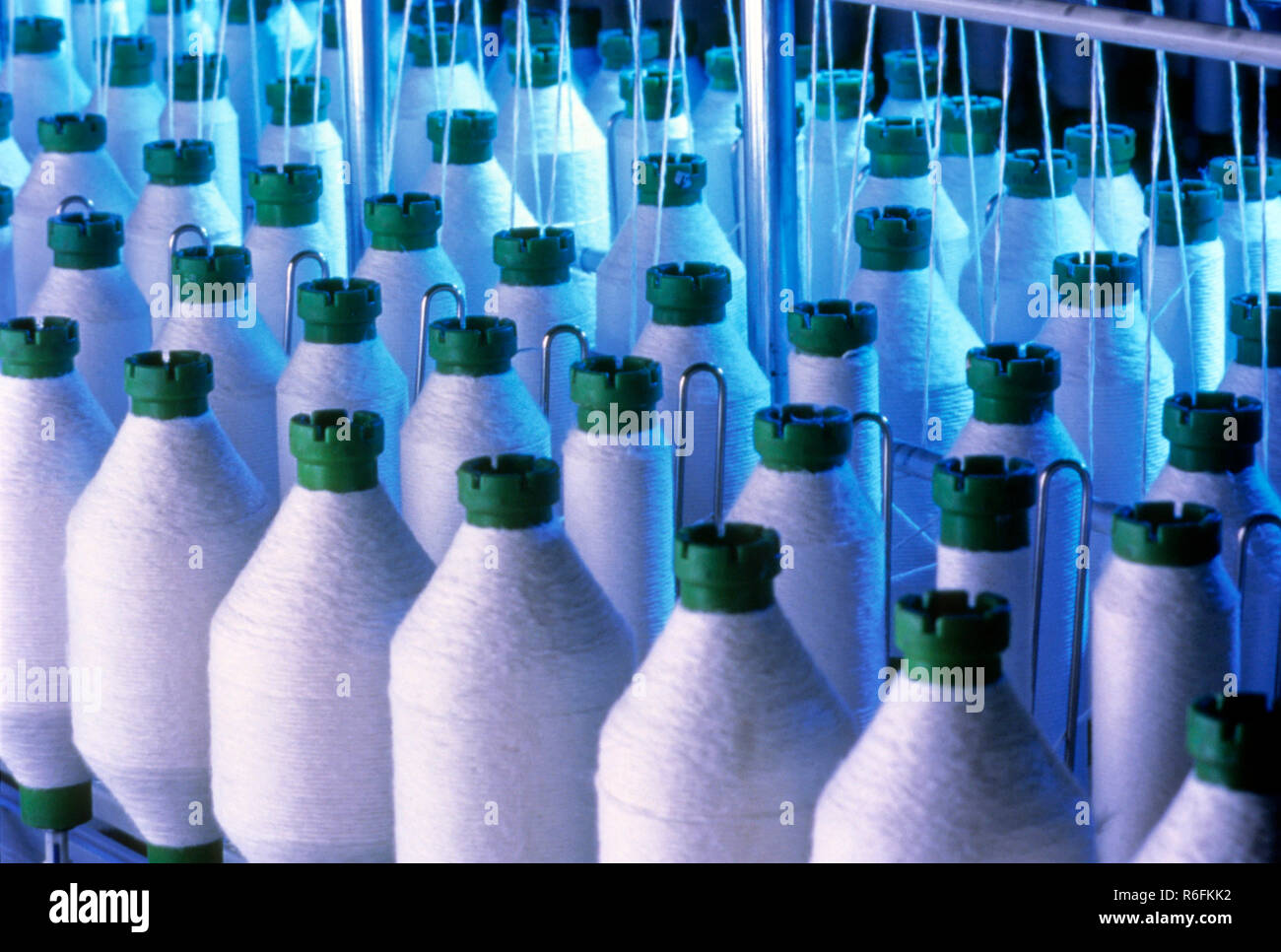 bobbin thread ball in loom factory Stock Photohttps://www.alamy.com/image-license-details/?v=1https://www.alamy.com/bobbin-thread-ball-in-loom-factory-image227767430.html
bobbin thread ball in loom factory Stock Photohttps://www.alamy.com/image-license-details/?v=1https://www.alamy.com/bobbin-thread-ball-in-loom-factory-image227767430.htmlRMR6FKK2–bobbin thread ball in loom factory
 Chain Driven Pulleys On Old Weaving Machine at the micro mill London Cloth Company Stock Photohttps://www.alamy.com/image-license-details/?v=1https://www.alamy.com/chain-driven-pulleys-on-old-weaving-machine-at-the-micro-mill-london-cloth-company-image392030461.html
Chain Driven Pulleys On Old Weaving Machine at the micro mill London Cloth Company Stock Photohttps://www.alamy.com/image-license-details/?v=1https://www.alamy.com/chain-driven-pulleys-on-old-weaving-machine-at-the-micro-mill-london-cloth-company-image392030461.htmlRM2DNPERW–Chain Driven Pulleys On Old Weaving Machine at the micro mill London Cloth Company
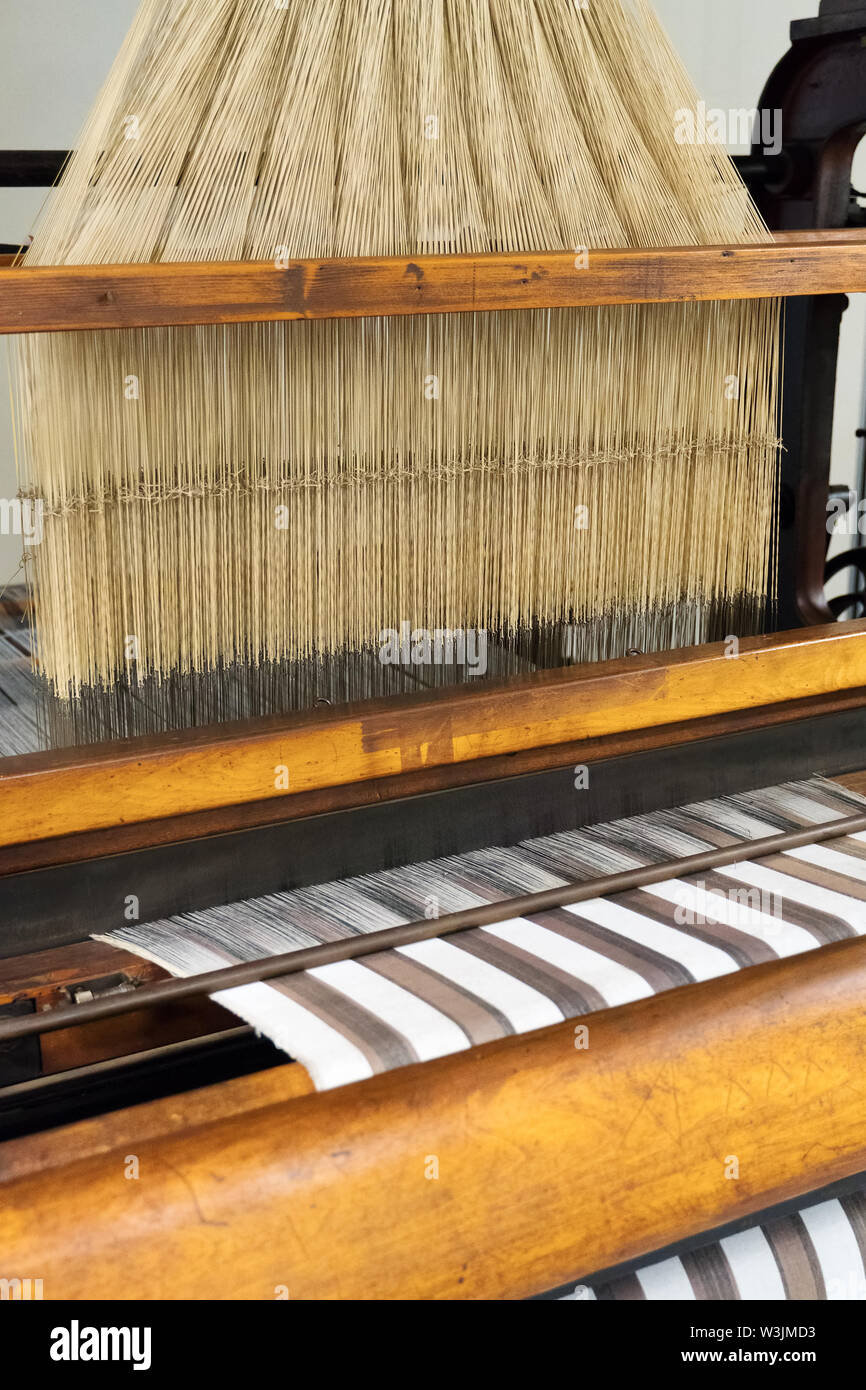 Retro mechanical loom with jacquard harness. Stock Photohttps://www.alamy.com/image-license-details/?v=1https://www.alamy.com/retro-mechanical-loom-with-jacquard-harness-image260410671.html
Retro mechanical loom with jacquard harness. Stock Photohttps://www.alamy.com/image-license-details/?v=1https://www.alamy.com/retro-mechanical-loom-with-jacquard-harness-image260410671.htmlRFW3JMD3–Retro mechanical loom with jacquard harness.
 View of the hands of a weaver arranging cotton threads on a mechanical loom. Stock Photohttps://www.alamy.com/image-license-details/?v=1https://www.alamy.com/view-of-the-hands-of-a-weaver-arranging-cotton-threads-on-a-mechanical-loom-image359517460.html
View of the hands of a weaver arranging cotton threads on a mechanical loom. Stock Photohttps://www.alamy.com/image-license-details/?v=1https://www.alamy.com/view-of-the-hands-of-a-weaver-arranging-cotton-threads-on-a-mechanical-loom-image359517460.htmlRF2BTWC58–View of the hands of a weaver arranging cotton threads on a mechanical loom.
 France, Pas de Calais, Cote d'Opale (Opal Coast), Calais, City of lace and fashion (2009), retouching on a lace woven on a mechanical loom Stock Photohttps://www.alamy.com/image-license-details/?v=1https://www.alamy.com/france-pas-de-calais-cote-dopale-opal-coast-calais-city-of-lace-and-fashion-2009-retouching-on-a-lace-woven-on-a-mechanical-loom-image499492543.html
France, Pas de Calais, Cote d'Opale (Opal Coast), Calais, City of lace and fashion (2009), retouching on a lace woven on a mechanical loom Stock Photohttps://www.alamy.com/image-license-details/?v=1https://www.alamy.com/france-pas-de-calais-cote-dopale-opal-coast-calais-city-of-lace-and-fashion-2009-retouching-on-a-lace-woven-on-a-mechanical-loom-image499492543.htmlRM2M0HRRB–France, Pas de Calais, Cote d'Opale (Opal Coast), Calais, City of lace and fashion (2009), retouching on a lace woven on a mechanical loom
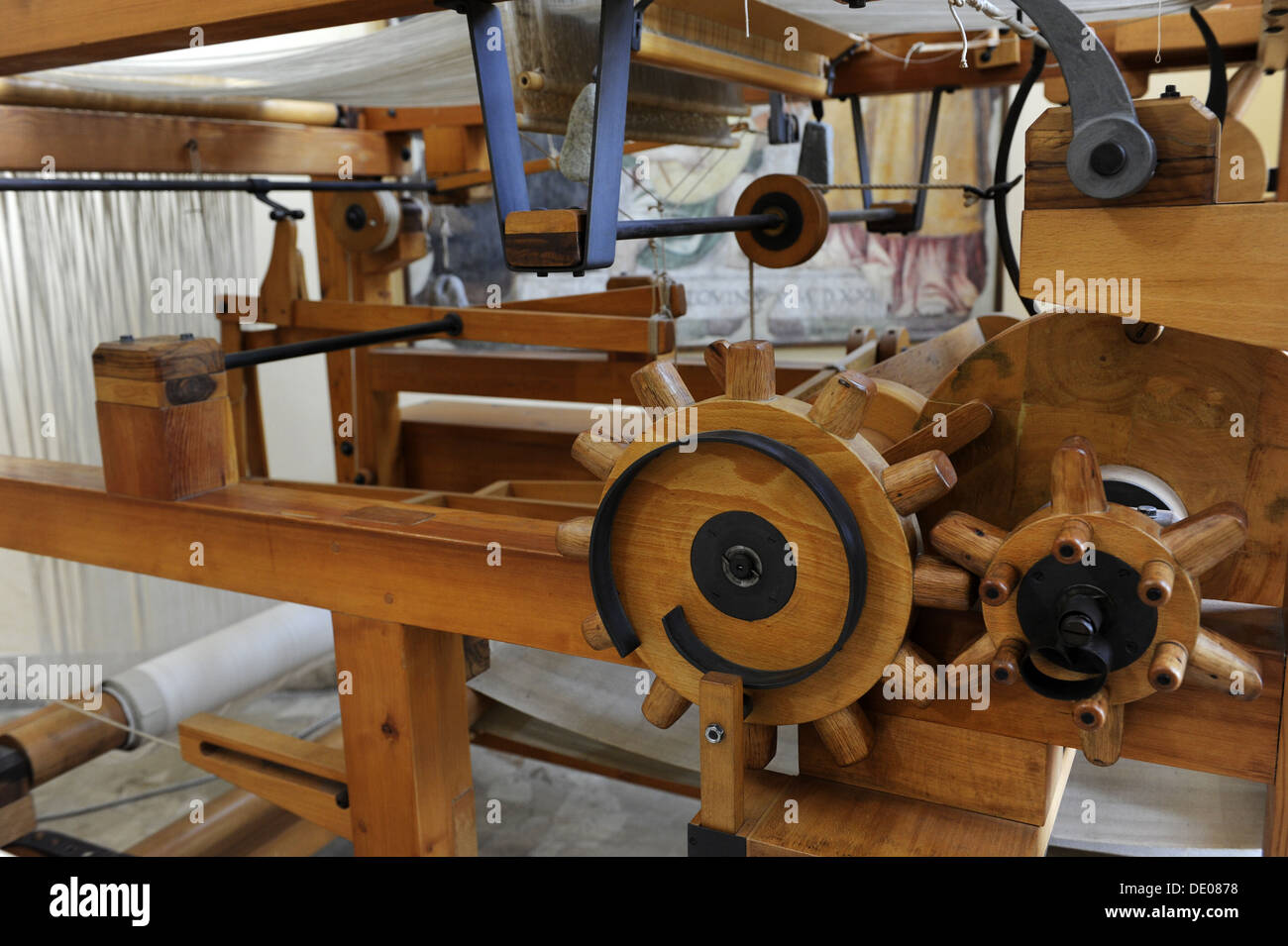 Study of Leonardo da Vinci. Weaving machines. Mechanical loom. 15th century. Model. Detail. Stock Photohttps://www.alamy.com/image-license-details/?v=1https://www.alamy.com/study-of-leonardo-da-vinci-weaving-machines-mechanical-loom-15th-century-image60242764.html
Study of Leonardo da Vinci. Weaving machines. Mechanical loom. 15th century. Model. Detail. Stock Photohttps://www.alamy.com/image-license-details/?v=1https://www.alamy.com/study-of-leonardo-da-vinci-weaving-machines-mechanical-loom-15th-century-image60242764.htmlRMDE0878–Study of Leonardo da Vinci. Weaving machines. Mechanical loom. 15th century. Model. Detail.
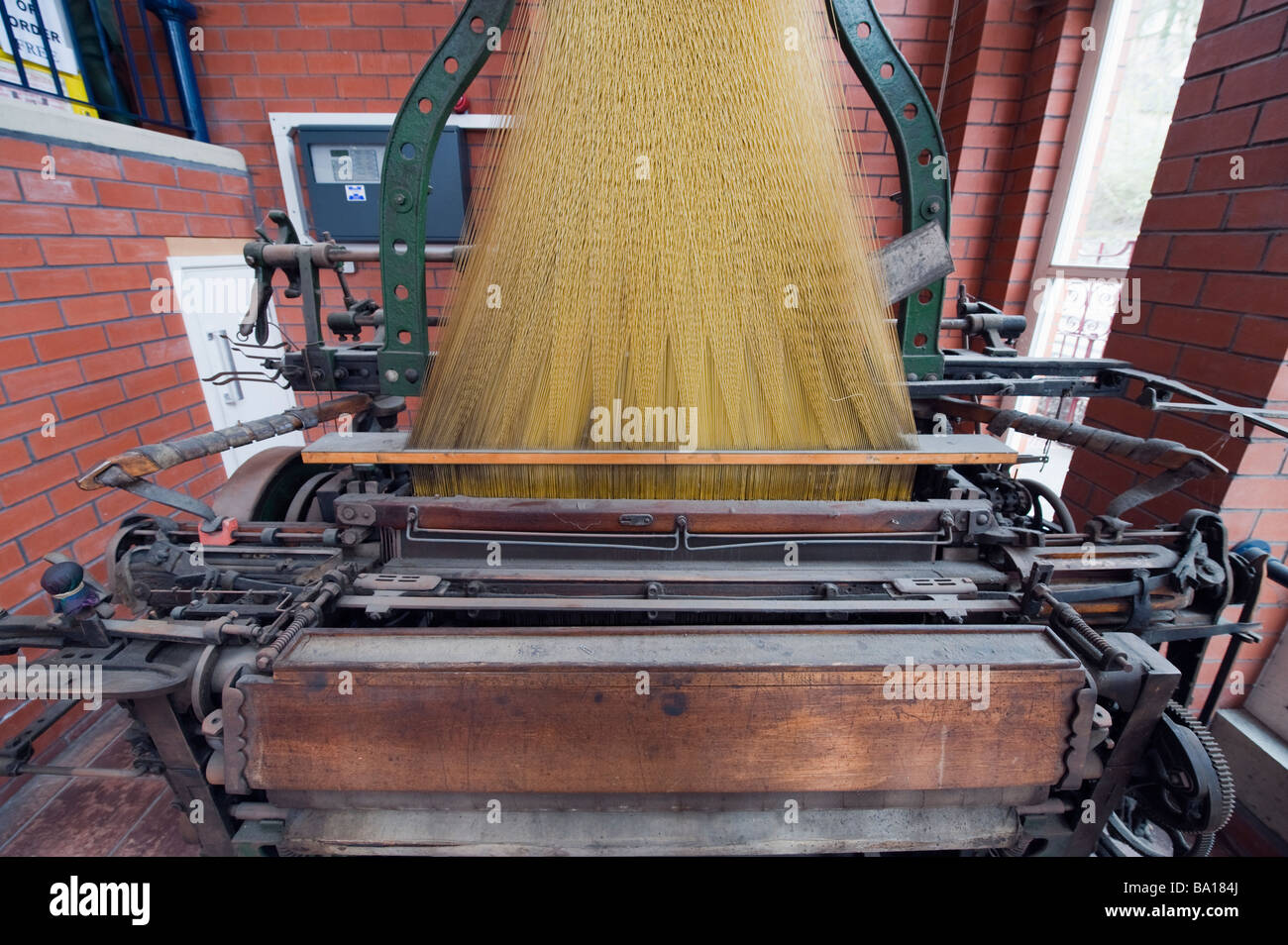 Loom 'Masson Mills', 'Matlock Bath',Derbyshire, England, 'Great Britain', 'United Kingdom' Stock Photohttps://www.alamy.com/image-license-details/?v=1https://www.alamy.com/stock-photo-loom-masson-mills-matlock-bathderbyshire-england-great-britain-united-23385282.html
Loom 'Masson Mills', 'Matlock Bath',Derbyshire, England, 'Great Britain', 'United Kingdom' Stock Photohttps://www.alamy.com/image-license-details/?v=1https://www.alamy.com/stock-photo-loom-masson-mills-matlock-bathderbyshire-england-great-britain-united-23385282.htmlRMBA184J–Loom 'Masson Mills', 'Matlock Bath',Derbyshire, England, 'Great Britain', 'United Kingdom'
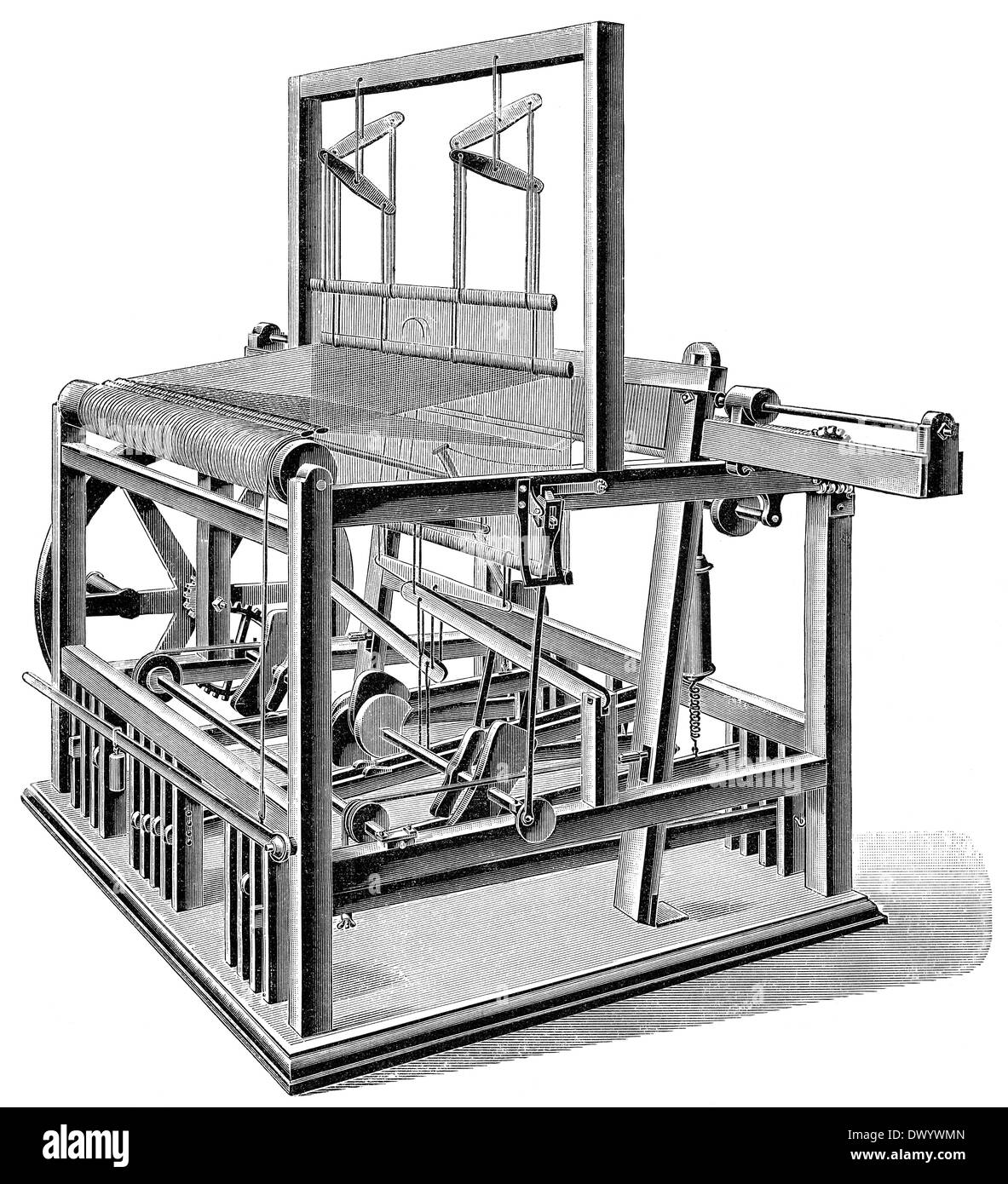 mechanical weaving loom, 19th century, Stock Photohttps://www.alamy.com/image-license-details/?v=1https://www.alamy.com/mechanical-weaving-loom-19th-century-image67610389.html
mechanical weaving loom, 19th century, Stock Photohttps://www.alamy.com/image-license-details/?v=1https://www.alamy.com/mechanical-weaving-loom-19th-century-image67610389.htmlRMDWYWMN–mechanical weaving loom, 19th century,
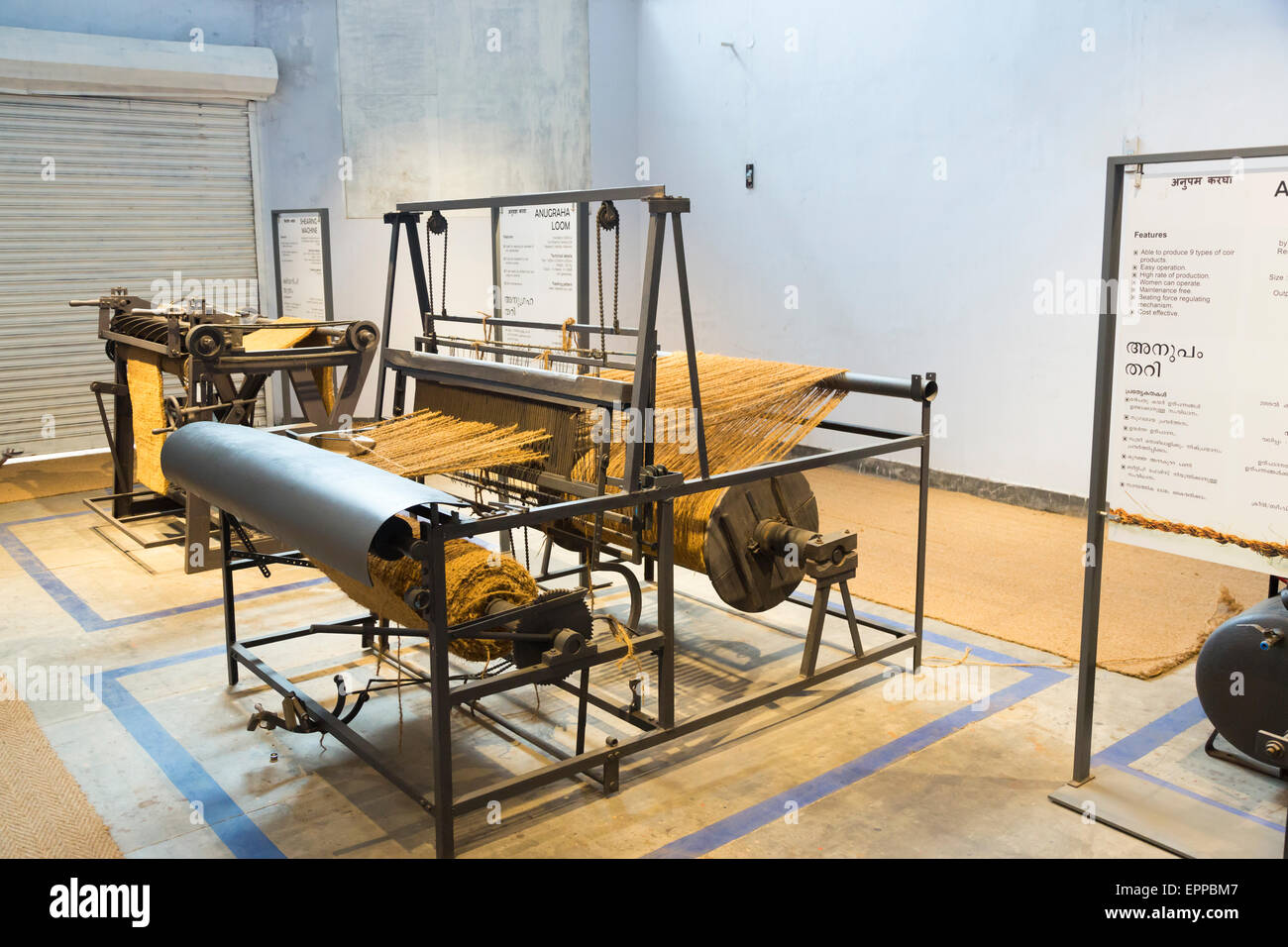 Vintage weaving loom machine exhibited at the Coir Museum, Cochin, Kerala, southern India Stock Photohttps://www.alamy.com/image-license-details/?v=1https://www.alamy.com/stock-photo-vintage-weaving-loom-machine-exhibited-at-the-coir-museum-cochin-kerala-82856039.html
Vintage weaving loom machine exhibited at the Coir Museum, Cochin, Kerala, southern India Stock Photohttps://www.alamy.com/image-license-details/?v=1https://www.alamy.com/stock-photo-vintage-weaving-loom-machine-exhibited-at-the-coir-museum-cochin-kerala-82856039.htmlRMEPPBM7–Vintage weaving loom machine exhibited at the Coir Museum, Cochin, Kerala, southern India
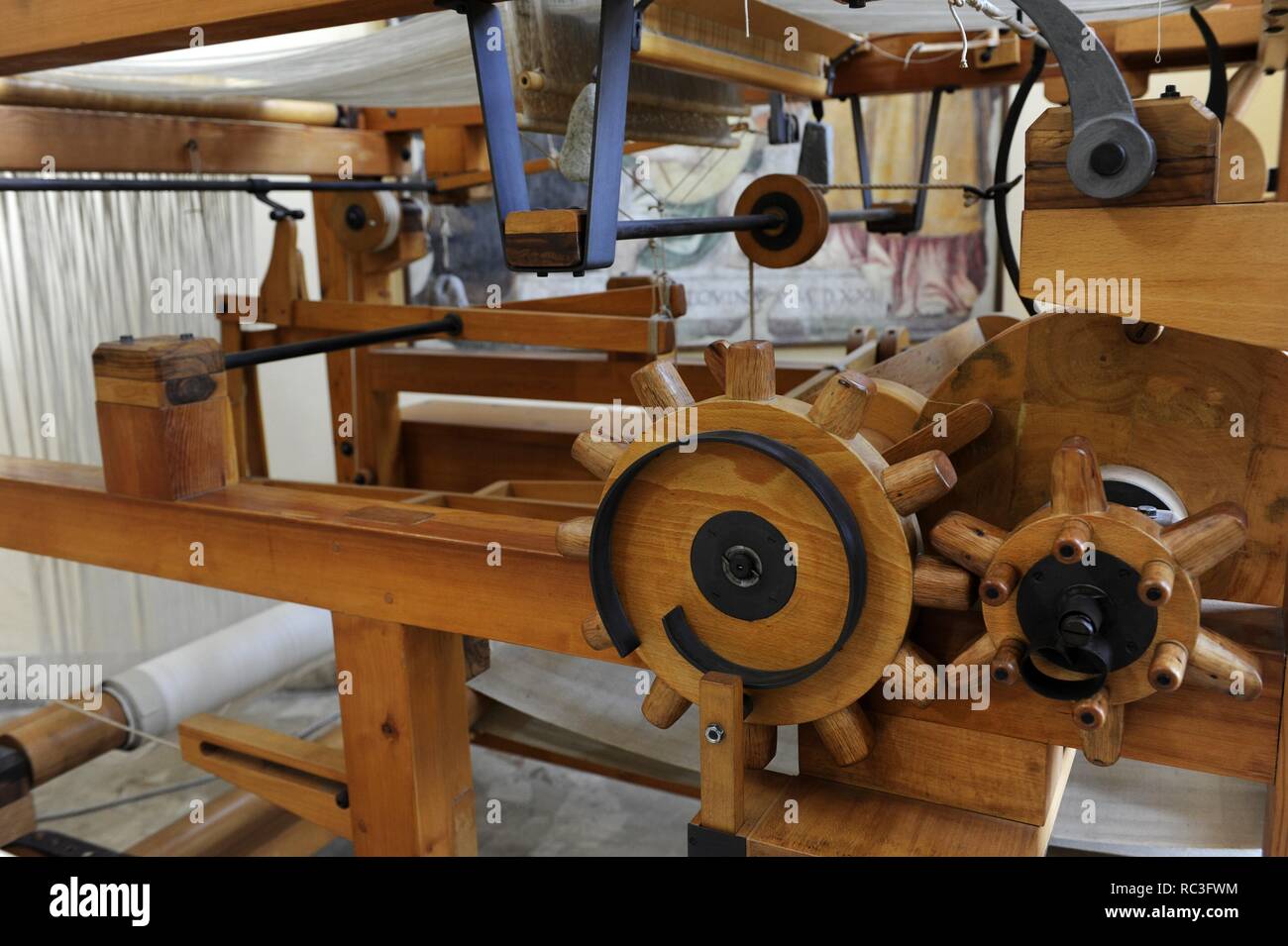 Renaissance. Study of Leonardo da Vinci. Weaving machines. Mechanical loom. 15th century. Model. Detail. The Science and Technology Museum Leonardo da Vinci. Milan. Italy. Stock Photohttps://www.alamy.com/image-license-details/?v=1https://www.alamy.com/renaissance-study-of-leonardo-da-vinci-weaving-machines-mechanical-loom-15th-century-model-detail-the-science-and-technology-museum-leonardo-da-vinci-milan-italy-image231188992.html
Renaissance. Study of Leonardo da Vinci. Weaving machines. Mechanical loom. 15th century. Model. Detail. The Science and Technology Museum Leonardo da Vinci. Milan. Italy. Stock Photohttps://www.alamy.com/image-license-details/?v=1https://www.alamy.com/renaissance-study-of-leonardo-da-vinci-weaving-machines-mechanical-loom-15th-century-model-detail-the-science-and-technology-museum-leonardo-da-vinci-milan-italy-image231188992.htmlRMRC3FWM–Renaissance. Study of Leonardo da Vinci. Weaving machines. Mechanical loom. 15th century. Model. Detail. The Science and Technology Museum Leonardo da Vinci. Milan. Italy.
 Mechanische Webstuhle - Mechanical weaving van Delden , Gronau,1937 German weaving industry 1920 -1950 Germany Stock Photohttps://www.alamy.com/image-license-details/?v=1https://www.alamy.com/stock-photo-mechanische-webstuhle-mechanical-weaving-van-delden-gronau1937-german-139100766.html
Mechanische Webstuhle - Mechanical weaving van Delden , Gronau,1937 German weaving industry 1920 -1950 Germany Stock Photohttps://www.alamy.com/image-license-details/?v=1https://www.alamy.com/stock-photo-mechanische-webstuhle-mechanical-weaving-van-delden-gronau1937-german-139100766.htmlRMJ28GCE–Mechanische Webstuhle - Mechanical weaving van Delden , Gronau,1937 German weaving industry 1920 -1950 Germany
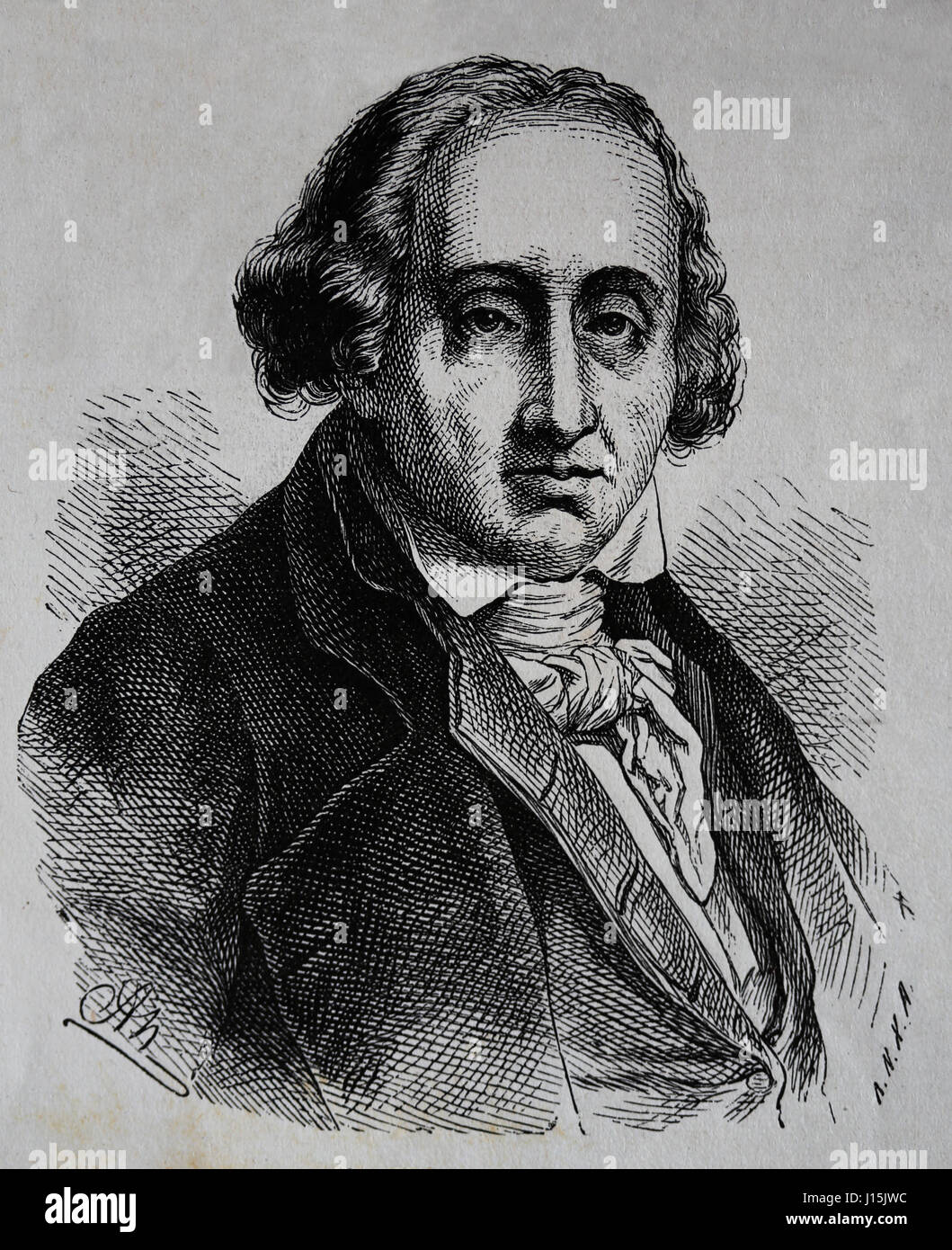 Joseph Maria Jacquard (1752-1834). French merchant. Inventor of programmable loom. Engraving, Nuestro Siglo, 1883. Stock Photohttps://www.alamy.com/image-license-details/?v=1https://www.alamy.com/stock-photo-joseph-maria-jacquard-1752-1834-french-merchant-inventor-of-programmable-138422184.html
Joseph Maria Jacquard (1752-1834). French merchant. Inventor of programmable loom. Engraving, Nuestro Siglo, 1883. Stock Photohttps://www.alamy.com/image-license-details/?v=1https://www.alamy.com/stock-photo-joseph-maria-jacquard-1752-1834-french-merchant-inventor-of-programmable-138422184.htmlRMJ15JWC–Joseph Maria Jacquard (1752-1834). French merchant. Inventor of programmable loom. Engraving, Nuestro Siglo, 1883.
 mechanical loom for the production of fabrics with wire splolette for spinning in the textile industry Stock Photohttps://www.alamy.com/image-license-details/?v=1https://www.alamy.com/stock-photo-mechanical-loom-for-the-production-of-fabrics-with-wire-splolette-109274608.html
mechanical loom for the production of fabrics with wire splolette for spinning in the textile industry Stock Photohttps://www.alamy.com/image-license-details/?v=1https://www.alamy.com/stock-photo-mechanical-loom-for-the-production-of-fabrics-with-wire-splolette-109274608.htmlRFG9NTTG–mechanical loom for the production of fabrics with wire splolette for spinning in the textile industry
 1950s, textile mill or factory, workers on the production line using mechanical weaving looms, Northern Ireland. In this era, the textile industry was a big employer and nearly every village and town in Northern Ireland had a mill or factory involved in the industry. Stock Photohttps://www.alamy.com/image-license-details/?v=1https://www.alamy.com/1950s-textile-mill-or-factory-workers-on-the-production-line-using-mechanical-weaving-looms-northern-ireland-in-this-era-the-textile-industry-was-a-big-employer-and-nearly-every-village-and-town-in-northern-ireland-had-a-mill-or-factory-involved-in-the-industry-image230578939.html
1950s, textile mill or factory, workers on the production line using mechanical weaving looms, Northern Ireland. In this era, the textile industry was a big employer and nearly every village and town in Northern Ireland had a mill or factory involved in the industry. Stock Photohttps://www.alamy.com/image-license-details/?v=1https://www.alamy.com/1950s-textile-mill-or-factory-workers-on-the-production-line-using-mechanical-weaving-looms-northern-ireland-in-this-era-the-textile-industry-was-a-big-employer-and-nearly-every-village-and-town-in-northern-ireland-had-a-mill-or-factory-involved-in-the-industry-image230578939.htmlRMRB3NP3–1950s, textile mill or factory, workers on the production line using mechanical weaving looms, Northern Ireland. In this era, the textile industry was a big employer and nearly every village and town in Northern Ireland had a mill or factory involved in the industry.
 Boy working on a loom in the village of Rhumsiki, Cameroon, Central Africa, Africa Stock Photohttps://www.alamy.com/image-license-details/?v=1https://www.alamy.com/stock-photo-boy-working-on-a-loom-in-the-village-of-rhumsiki-cameroon-central-50997748.html
Boy working on a loom in the village of Rhumsiki, Cameroon, Central Africa, Africa Stock Photohttps://www.alamy.com/image-license-details/?v=1https://www.alamy.com/stock-photo-boy-working-on-a-loom-in-the-village-of-rhumsiki-cameroon-central-50997748.htmlRMCXY444–Boy working on a loom in the village of Rhumsiki, Cameroon, Central Africa, Africa
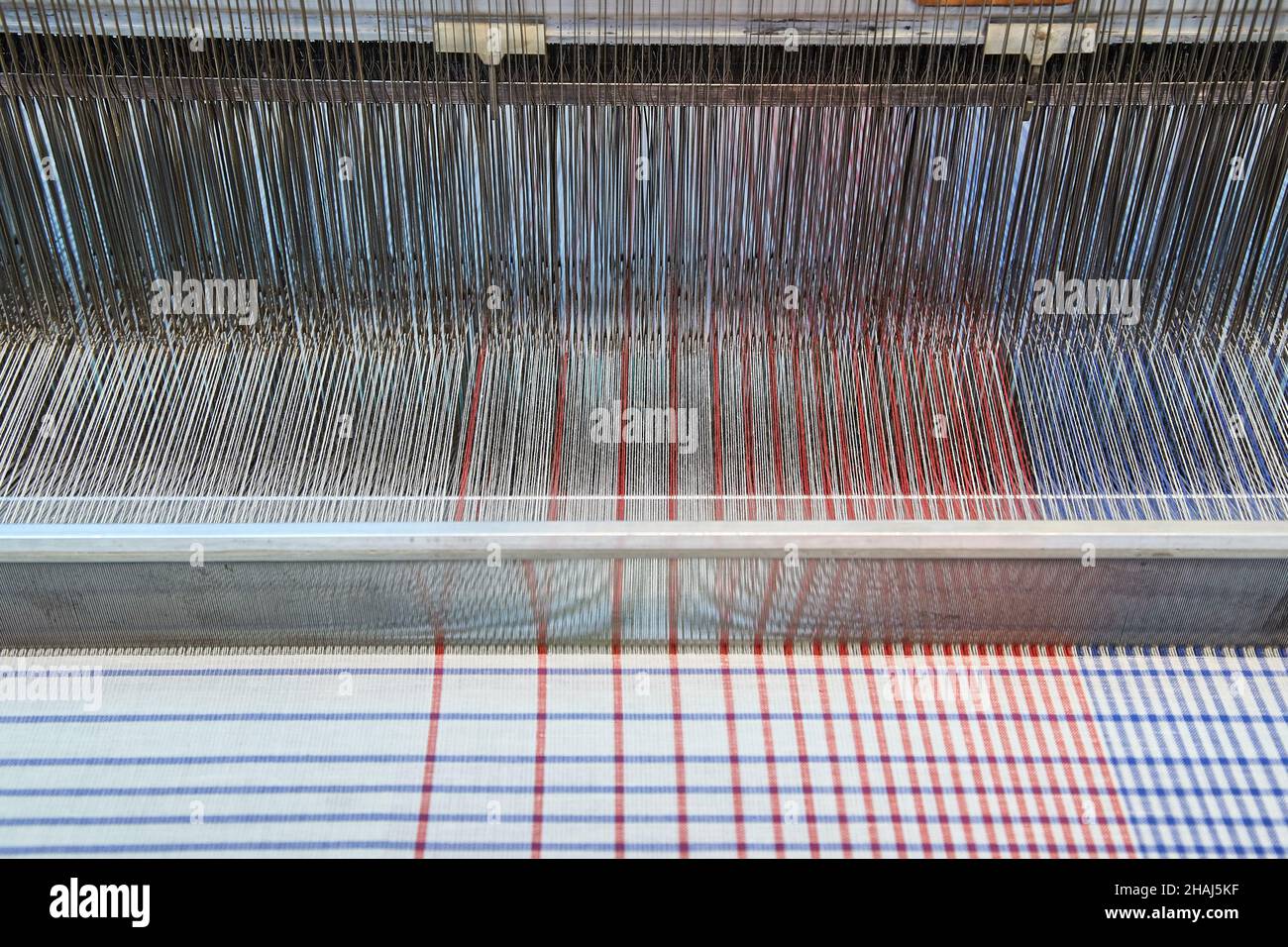 Industrial loom operating Stock Photohttps://www.alamy.com/image-license-details/?v=1https://www.alamy.com/industrial-loom-operating-image454015731.html
Industrial loom operating Stock Photohttps://www.alamy.com/image-license-details/?v=1https://www.alamy.com/industrial-loom-operating-image454015731.htmlRF2HAJ5KF–Industrial loom operating
 Woman working on a wooden hand loom, Flachsmarkt historical crafts market, Krefeld-Linn, North Rhine-Westphalia, Germany, Europe Stock Photohttps://www.alamy.com/image-license-details/?v=1https://www.alamy.com/stock-photo-woman-working-on-a-wooden-hand-loom-flachsmarkt-historical-crafts-48750345.html
Woman working on a wooden hand loom, Flachsmarkt historical crafts market, Krefeld-Linn, North Rhine-Westphalia, Germany, Europe Stock Photohttps://www.alamy.com/image-license-details/?v=1https://www.alamy.com/stock-photo-woman-working-on-a-wooden-hand-loom-flachsmarkt-historical-crafts-48750345.htmlRMCR8NFN–Woman working on a wooden hand loom, Flachsmarkt historical crafts market, Krefeld-Linn, North Rhine-Westphalia, Germany, Europe
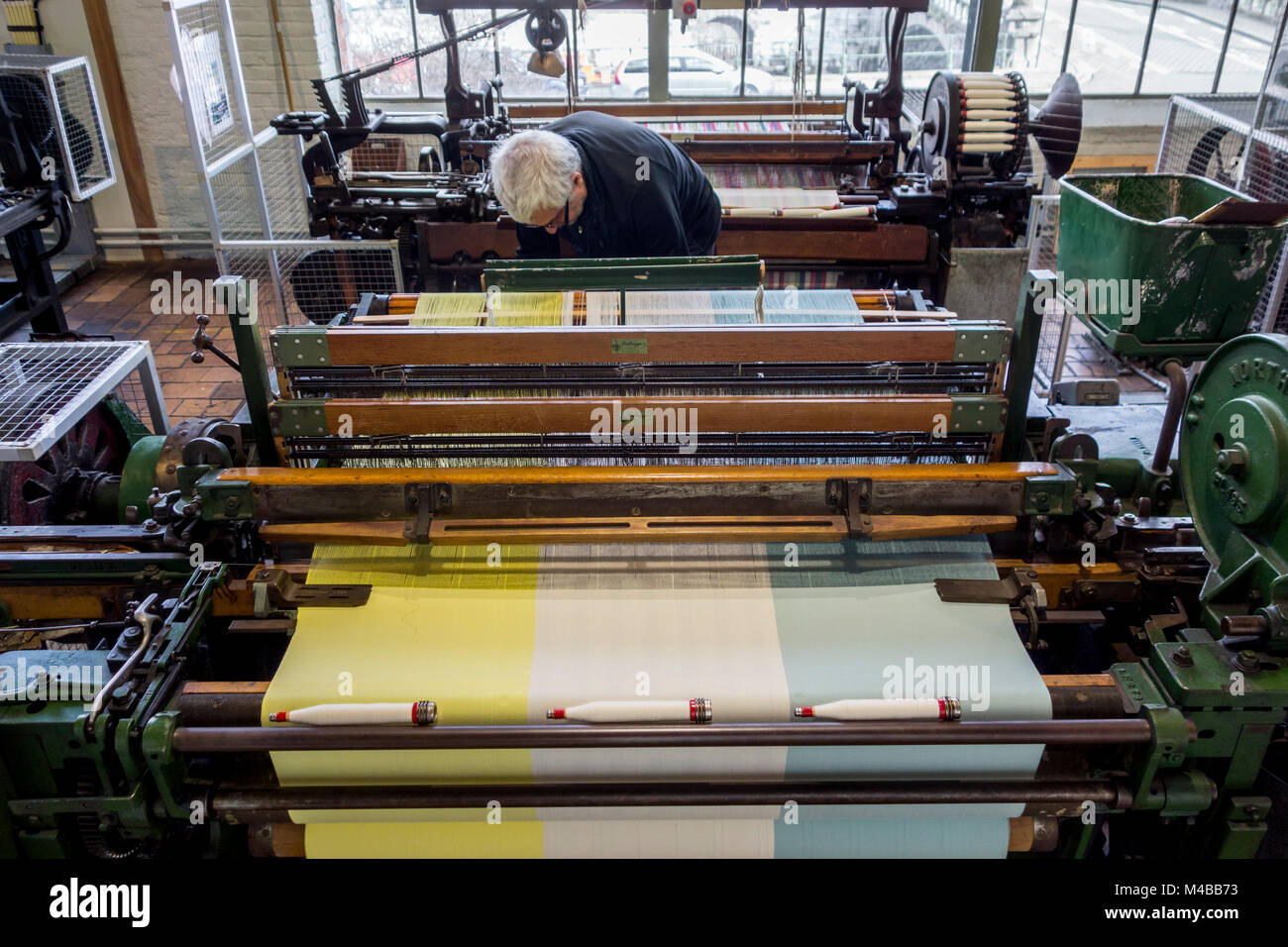 Fabric weaver operating mechanical flying shuttle loom / shuttle weaving machine in cotton mill / spinning-mill Stock Photohttps://www.alamy.com/image-license-details/?v=1https://www.alamy.com/stock-photo-fabric-weaver-operating-mechanical-flying-shuttle-loom-shuttle-weaving-174812599.html
Fabric weaver operating mechanical flying shuttle loom / shuttle weaving machine in cotton mill / spinning-mill Stock Photohttps://www.alamy.com/image-license-details/?v=1https://www.alamy.com/stock-photo-fabric-weaver-operating-mechanical-flying-shuttle-loom-shuttle-weaving-174812599.htmlRMM4BB73–Fabric weaver operating mechanical flying shuttle loom / shuttle weaving machine in cotton mill / spinning-mill
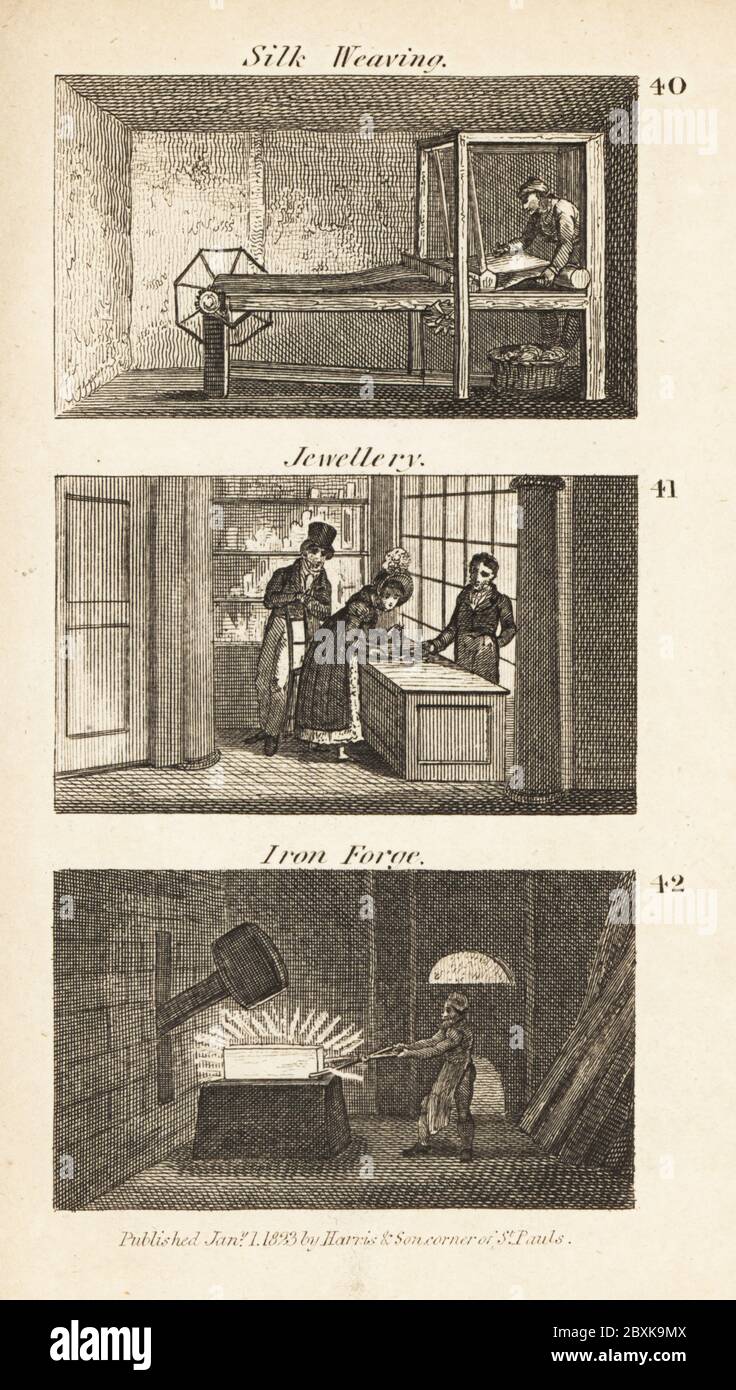 Trades in Regency England: silk weaving, jewellery and iron forge. Man weaving silk cloth on a loom in Coventry 40, customers in a fancy jewellery shop in Birmingham 41, and blacksmith working with a mechanical hammer in a mill-forge in Colebrook Dale 42. Woodcut engraving from Rev. Isaac Taylor’s Scenes of British Wealth, in Produce, Manufacture and Commerce, John Harris, London, 1823. Isaac Taylor was an English writer, artist, engraver and inventor 1787-1865. Stock Photohttps://www.alamy.com/image-license-details/?v=1https://www.alamy.com/trades-in-regency-england-silk-weaving-jewellery-and-iron-forge-man-weaving-silk-cloth-on-a-loom-in-coventry-40-customers-in-a-fancy-jewellery-shop-in-birmingham-41-and-blacksmith-working-with-a-mechanical-hammer-in-a-mill-forge-in-colebrook-dale-42-woodcut-engraving-from-rev-isaac-taylors-scenes-of-british-wealth-in-produce-manufacture-and-commerce-john-harris-london-1823-isaac-taylor-was-an-english-writer-artist-engraver-and-inventor-1787-1865-image360613146.html
Trades in Regency England: silk weaving, jewellery and iron forge. Man weaving silk cloth on a loom in Coventry 40, customers in a fancy jewellery shop in Birmingham 41, and blacksmith working with a mechanical hammer in a mill-forge in Colebrook Dale 42. Woodcut engraving from Rev. Isaac Taylor’s Scenes of British Wealth, in Produce, Manufacture and Commerce, John Harris, London, 1823. Isaac Taylor was an English writer, artist, engraver and inventor 1787-1865. Stock Photohttps://www.alamy.com/image-license-details/?v=1https://www.alamy.com/trades-in-regency-england-silk-weaving-jewellery-and-iron-forge-man-weaving-silk-cloth-on-a-loom-in-coventry-40-customers-in-a-fancy-jewellery-shop-in-birmingham-41-and-blacksmith-working-with-a-mechanical-hammer-in-a-mill-forge-in-colebrook-dale-42-woodcut-engraving-from-rev-isaac-taylors-scenes-of-british-wealth-in-produce-manufacture-and-commerce-john-harris-london-1823-isaac-taylor-was-an-english-writer-artist-engraver-and-inventor-1787-1865-image360613146.htmlRM2BXK9MX–Trades in Regency England: silk weaving, jewellery and iron forge. Man weaving silk cloth on a loom in Coventry 40, customers in a fancy jewellery shop in Birmingham 41, and blacksmith working with a mechanical hammer in a mill-forge in Colebrook Dale 42. Woodcut engraving from Rev. Isaac Taylor’s Scenes of British Wealth, in Produce, Manufacture and Commerce, John Harris, London, 1823. Isaac Taylor was an English writer, artist, engraver and inventor 1787-1865.
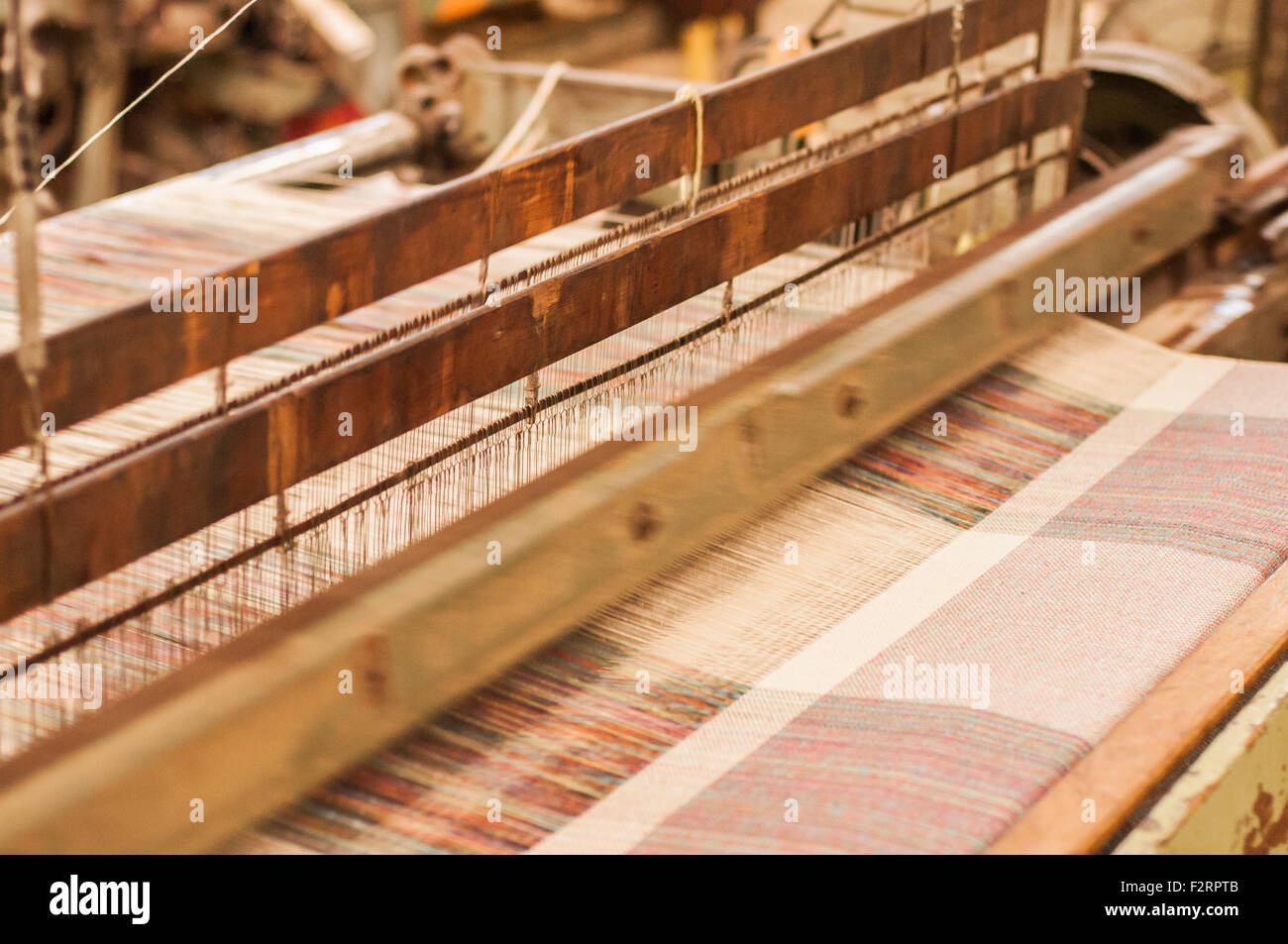 The workings of a flying shuttle loom. The loom is making cloth for blankets. Stock Photohttps://www.alamy.com/image-license-details/?v=1https://www.alamy.com/stock-photo-the-workings-of-a-flying-shuttle-loom-the-loom-is-making-cloth-for-87803979.html
The workings of a flying shuttle loom. The loom is making cloth for blankets. Stock Photohttps://www.alamy.com/image-license-details/?v=1https://www.alamy.com/stock-photo-the-workings-of-a-flying-shuttle-loom-the-loom-is-making-cloth-for-87803979.htmlRFF2RPTB–The workings of a flying shuttle loom. The loom is making cloth for blankets.
 Group of yarn cones Stock Photohttps://www.alamy.com/image-license-details/?v=1https://www.alamy.com/group-of-yarn-cones-image392032041.html
Group of yarn cones Stock Photohttps://www.alamy.com/image-license-details/?v=1https://www.alamy.com/group-of-yarn-cones-image392032041.htmlRM2DNPGT9–Group of yarn cones
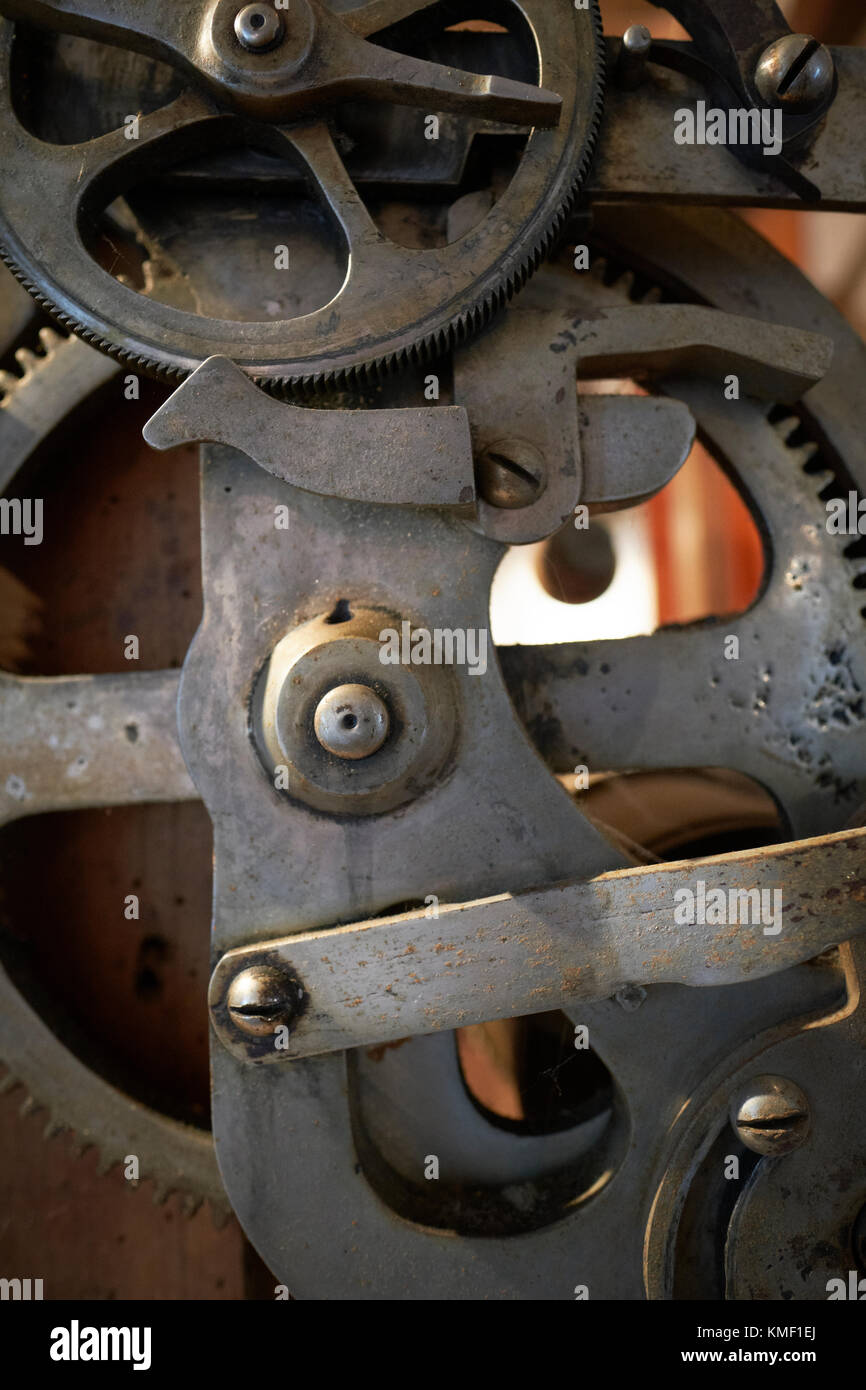 An 19th century Jacquard loom detail showing the mechanical parts Stock Photohttps://www.alamy.com/image-license-details/?v=1https://www.alamy.com/stock-image-an-19th-century-jacquard-loom-detail-showing-the-mechanical-parts-167516906.html
An 19th century Jacquard loom detail showing the mechanical parts Stock Photohttps://www.alamy.com/image-license-details/?v=1https://www.alamy.com/stock-image-an-19th-century-jacquard-loom-detail-showing-the-mechanical-parts-167516906.htmlRFKMF1EJ–An 19th century Jacquard loom detail showing the mechanical parts
 View of the hands of a weaver arranging cotton threads on a mechanical loom. Stock Photohttps://www.alamy.com/image-license-details/?v=1https://www.alamy.com/view-of-the-hands-of-a-weaver-arranging-cotton-threads-on-a-mechanical-loom-image359517530.html
View of the hands of a weaver arranging cotton threads on a mechanical loom. Stock Photohttps://www.alamy.com/image-license-details/?v=1https://www.alamy.com/view-of-the-hands-of-a-weaver-arranging-cotton-threads-on-a-mechanical-loom-image359517530.htmlRF2BTWC7P–View of the hands of a weaver arranging cotton threads on a mechanical loom.
 France, Pas de Calais, Cote d'Opale (Opal Coast), Calais, City of lace and fashion (2009), mending with a sewing machine to repair the tears on the lace woven by a mechanical loom Stock Photohttps://www.alamy.com/image-license-details/?v=1https://www.alamy.com/france-pas-de-calais-cote-dopale-opal-coast-calais-city-of-lace-and-fashion-2009-mending-with-a-sewing-machine-to-repair-the-tears-on-the-lace-woven-by-a-mechanical-loom-image499492505.html
France, Pas de Calais, Cote d'Opale (Opal Coast), Calais, City of lace and fashion (2009), mending with a sewing machine to repair the tears on the lace woven by a mechanical loom Stock Photohttps://www.alamy.com/image-license-details/?v=1https://www.alamy.com/france-pas-de-calais-cote-dopale-opal-coast-calais-city-of-lace-and-fashion-2009-mending-with-a-sewing-machine-to-repair-the-tears-on-the-lace-woven-by-a-mechanical-loom-image499492505.htmlRM2M0HRP1–France, Pas de Calais, Cote d'Opale (Opal Coast), Calais, City of lace and fashion (2009), mending with a sewing machine to repair the tears on the lace woven by a mechanical loom
 Handicraft, young woman weaving silk on a loom, Phonsavan, Xieng Khuang Province, Laos, Southeast Asia Stock Photohttps://www.alamy.com/image-license-details/?v=1https://www.alamy.com/stock-photo-handicraft-young-woman-weaving-silk-on-a-loom-phonsavan-xieng-khuang-20952098.html
Handicraft, young woman weaving silk on a loom, Phonsavan, Xieng Khuang Province, Laos, Southeast Asia Stock Photohttps://www.alamy.com/image-license-details/?v=1https://www.alamy.com/stock-photo-handicraft-young-woman-weaving-silk-on-a-loom-phonsavan-xieng-khuang-20952098.htmlRMB62CH6–Handicraft, young woman weaving silk on a loom, Phonsavan, Xieng Khuang Province, Laos, Southeast Asia
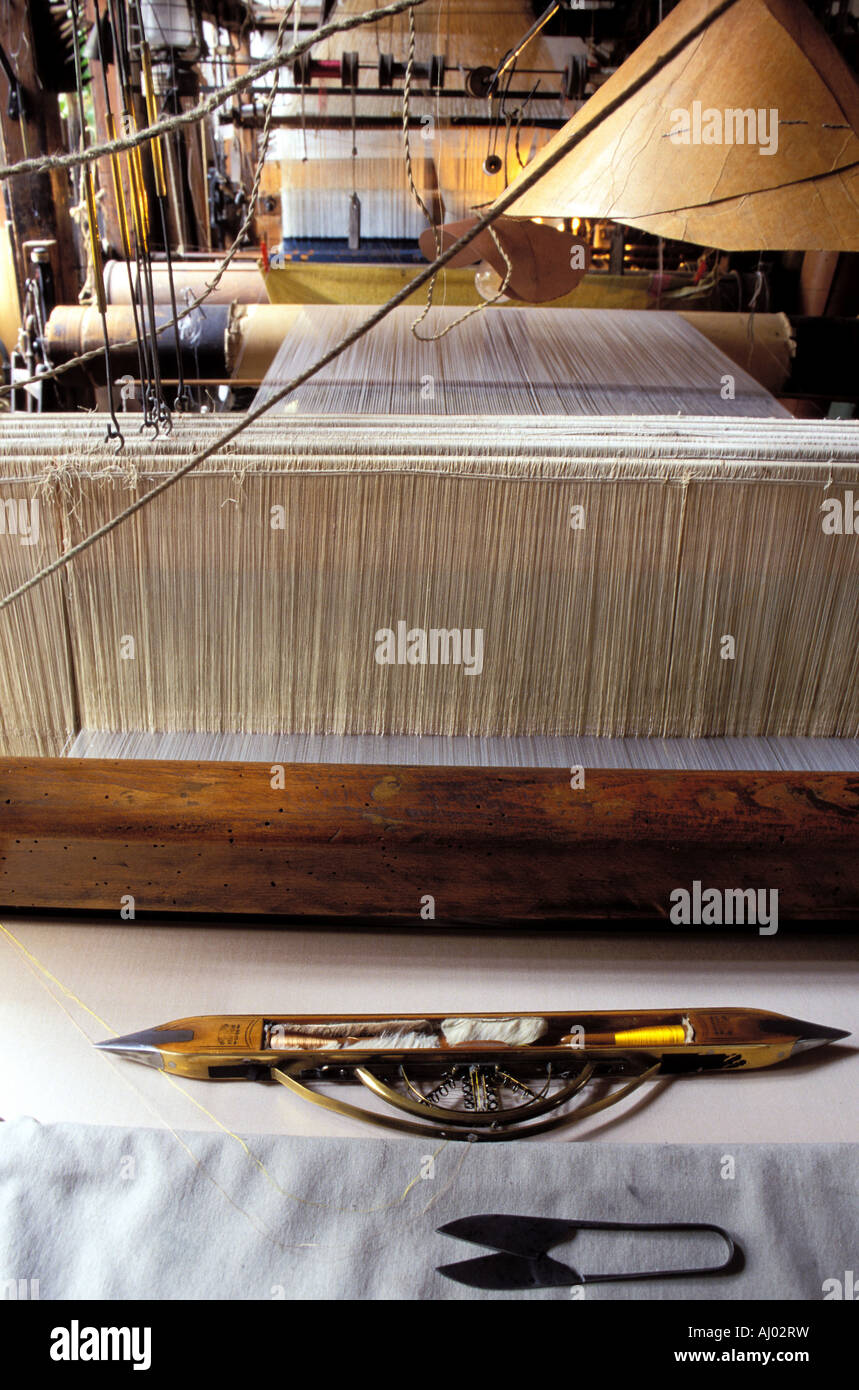 France, Rhone, Lyon city, mechanical loom with Jacquard, weaving of taffeta chameleon Stock Photohttps://www.alamy.com/image-license-details/?v=1https://www.alamy.com/stock-photo-france-rhone-lyon-city-mechanical-loom-with-jacquard-weaving-of-taffeta-14577084.html
France, Rhone, Lyon city, mechanical loom with Jacquard, weaving of taffeta chameleon Stock Photohttps://www.alamy.com/image-license-details/?v=1https://www.alamy.com/stock-photo-france-rhone-lyon-city-mechanical-loom-with-jacquard-weaving-of-taffeta-14577084.htmlRFAJ02RW–France, Rhone, Lyon city, mechanical loom with Jacquard, weaving of taffeta chameleon
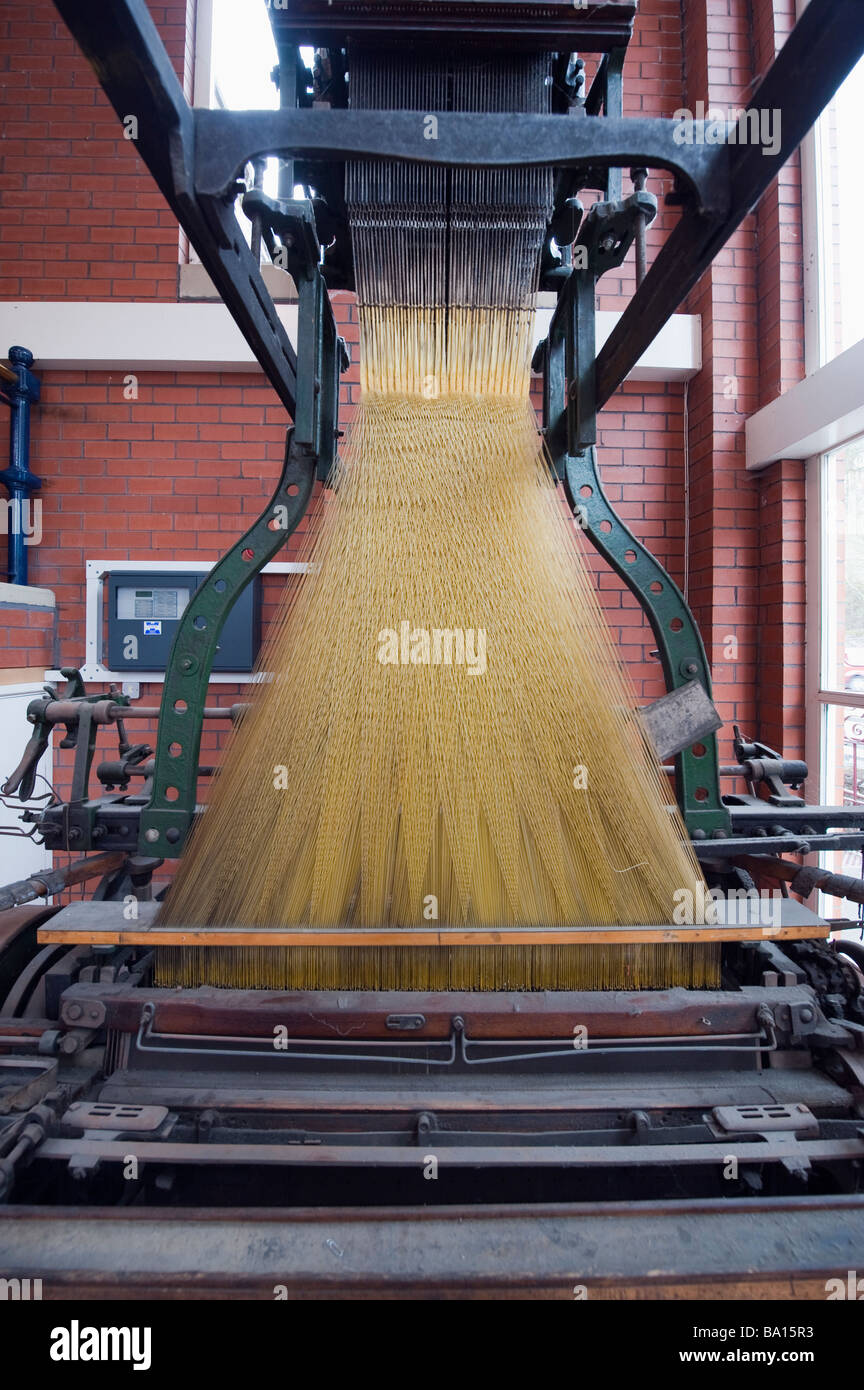 Loom 'Masson Mills', 'Matlock Bath',Derbyshire, England, 'Great Britain', 'United Kingdom' Stock Photohttps://www.alamy.com/image-license-details/?v=1https://www.alamy.com/stock-photo-loom-masson-mills-matlock-bathderbyshire-england-great-britain-united-23383447.html
Loom 'Masson Mills', 'Matlock Bath',Derbyshire, England, 'Great Britain', 'United Kingdom' Stock Photohttps://www.alamy.com/image-license-details/?v=1https://www.alamy.com/stock-photo-loom-masson-mills-matlock-bathderbyshire-england-great-britain-united-23383447.htmlRMBA15R3–Loom 'Masson Mills', 'Matlock Bath',Derbyshire, England, 'Great Britain', 'United Kingdom'